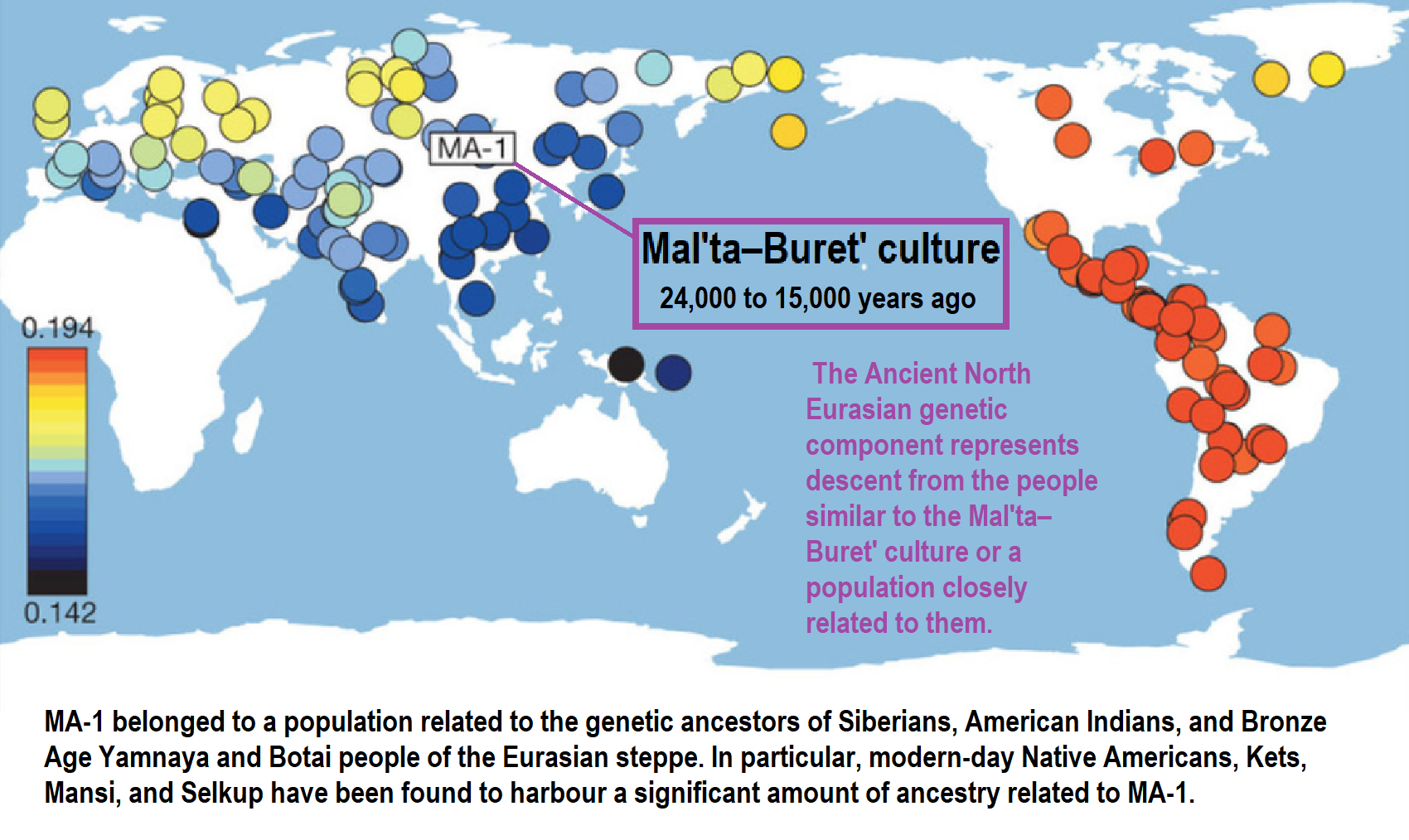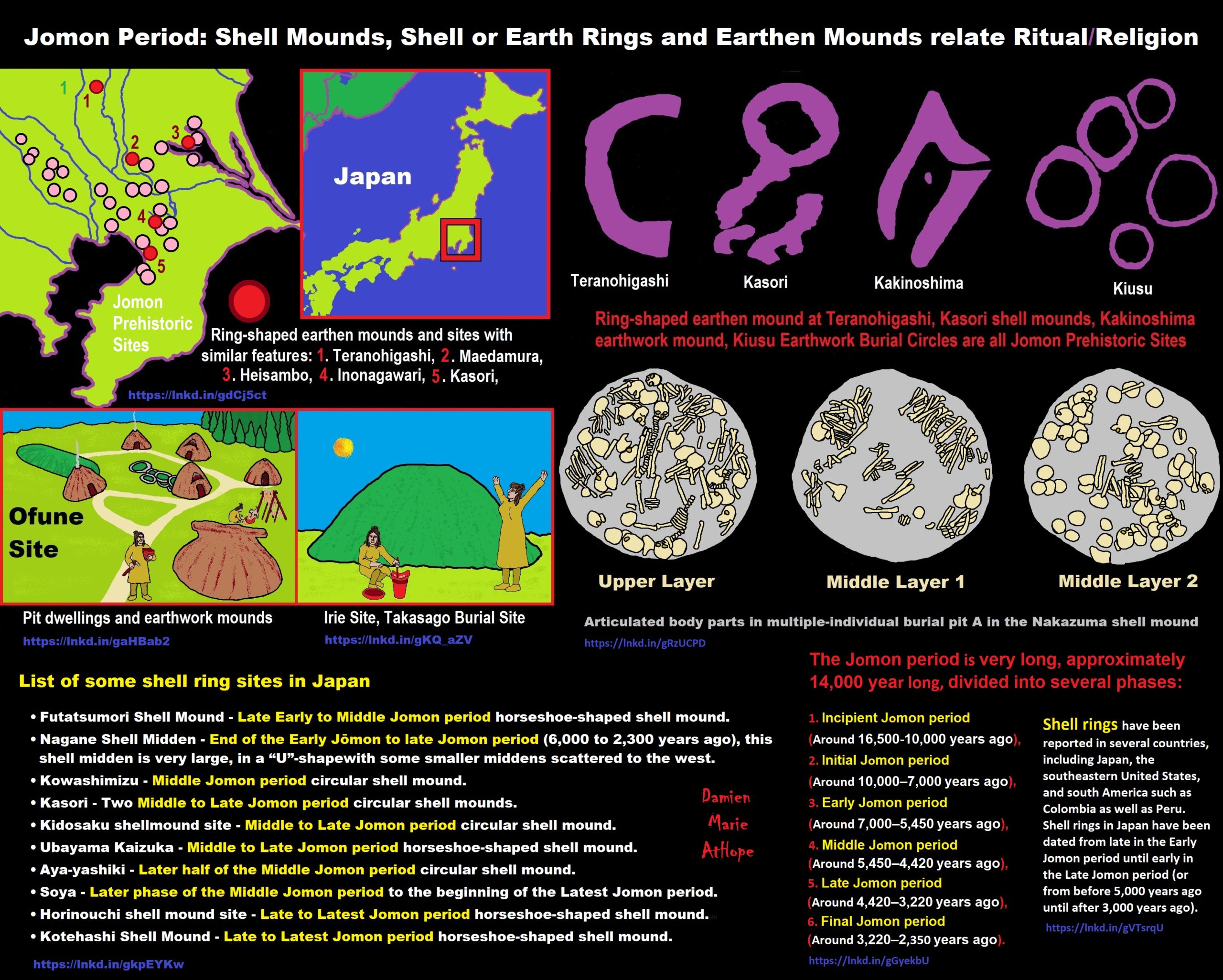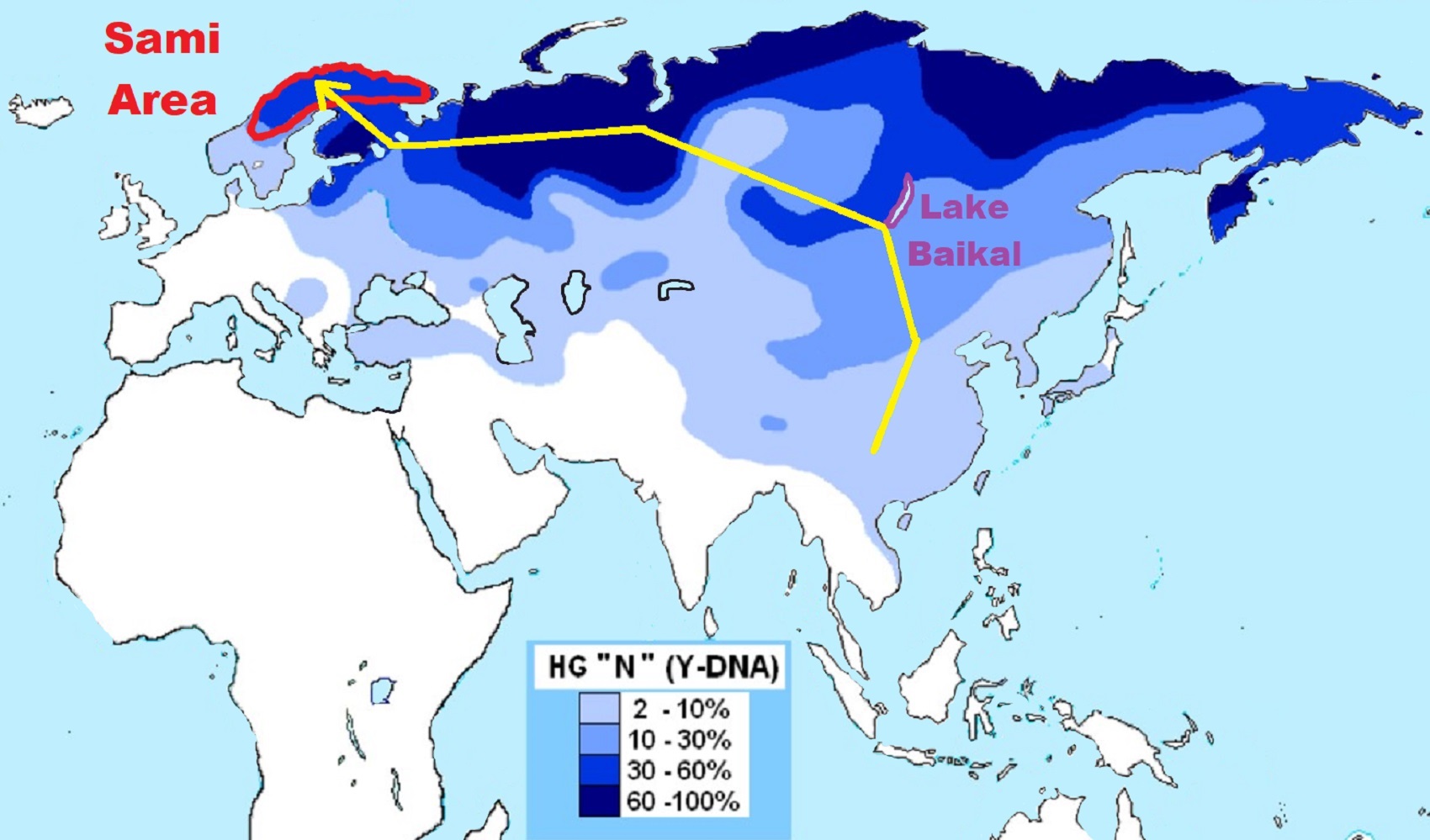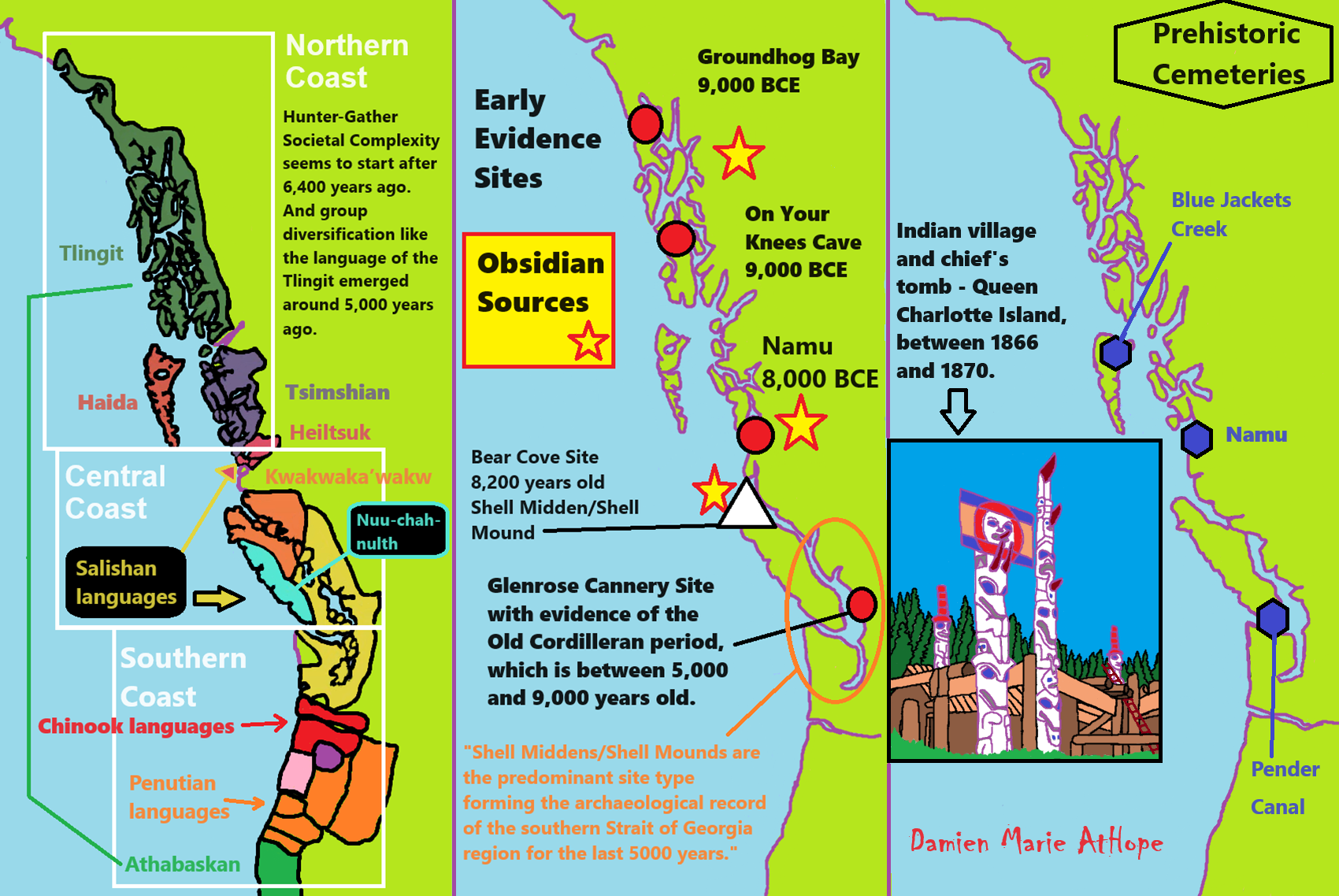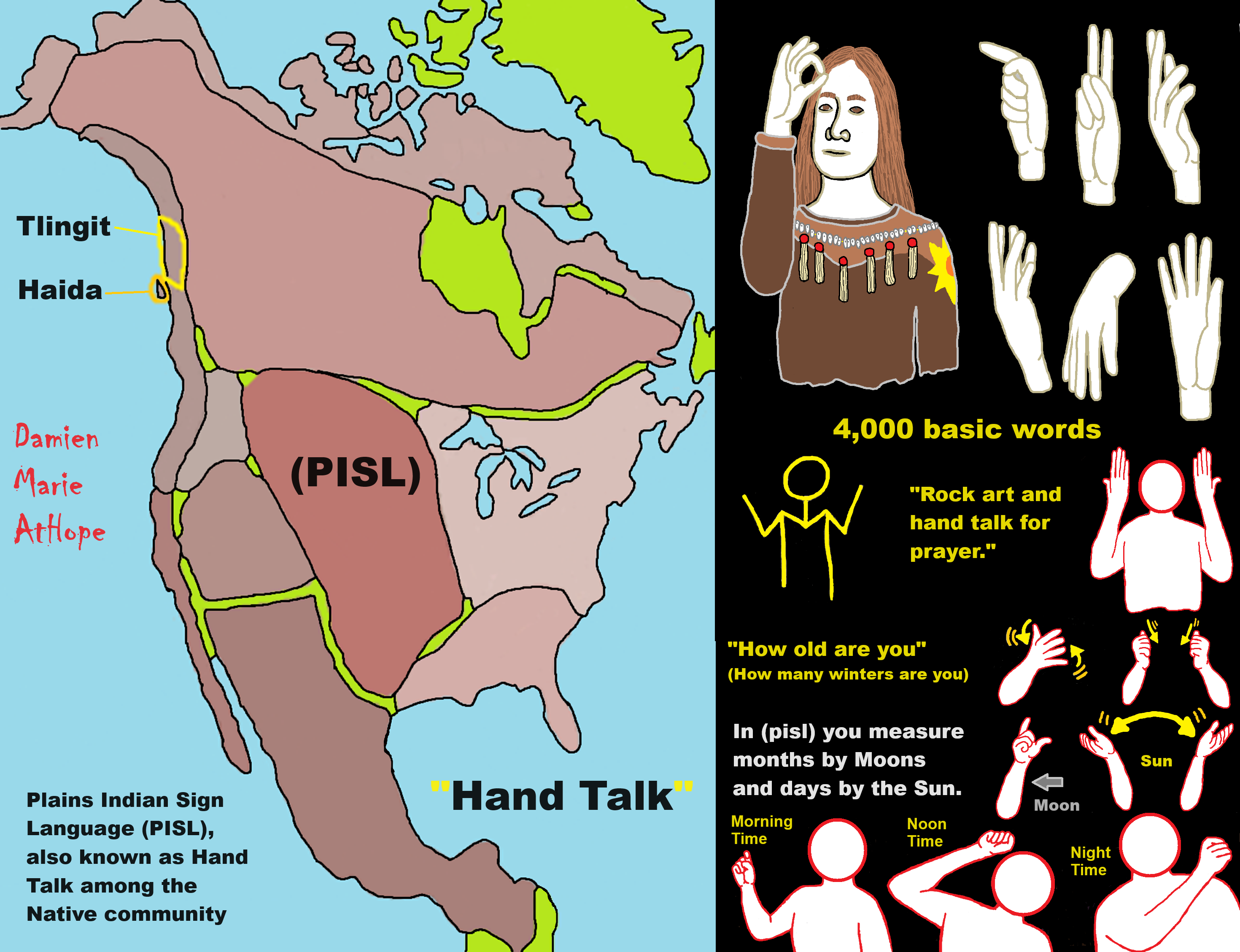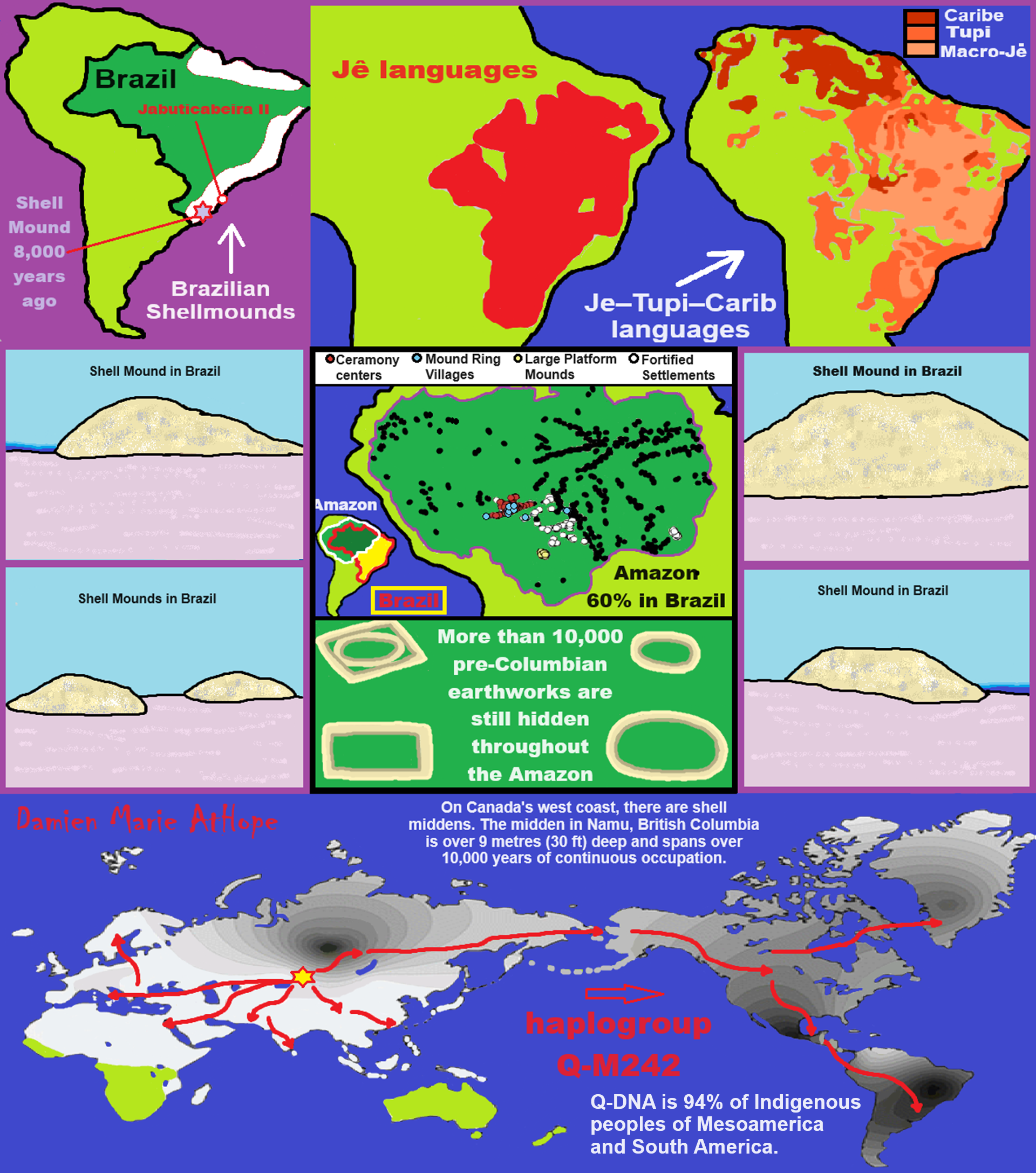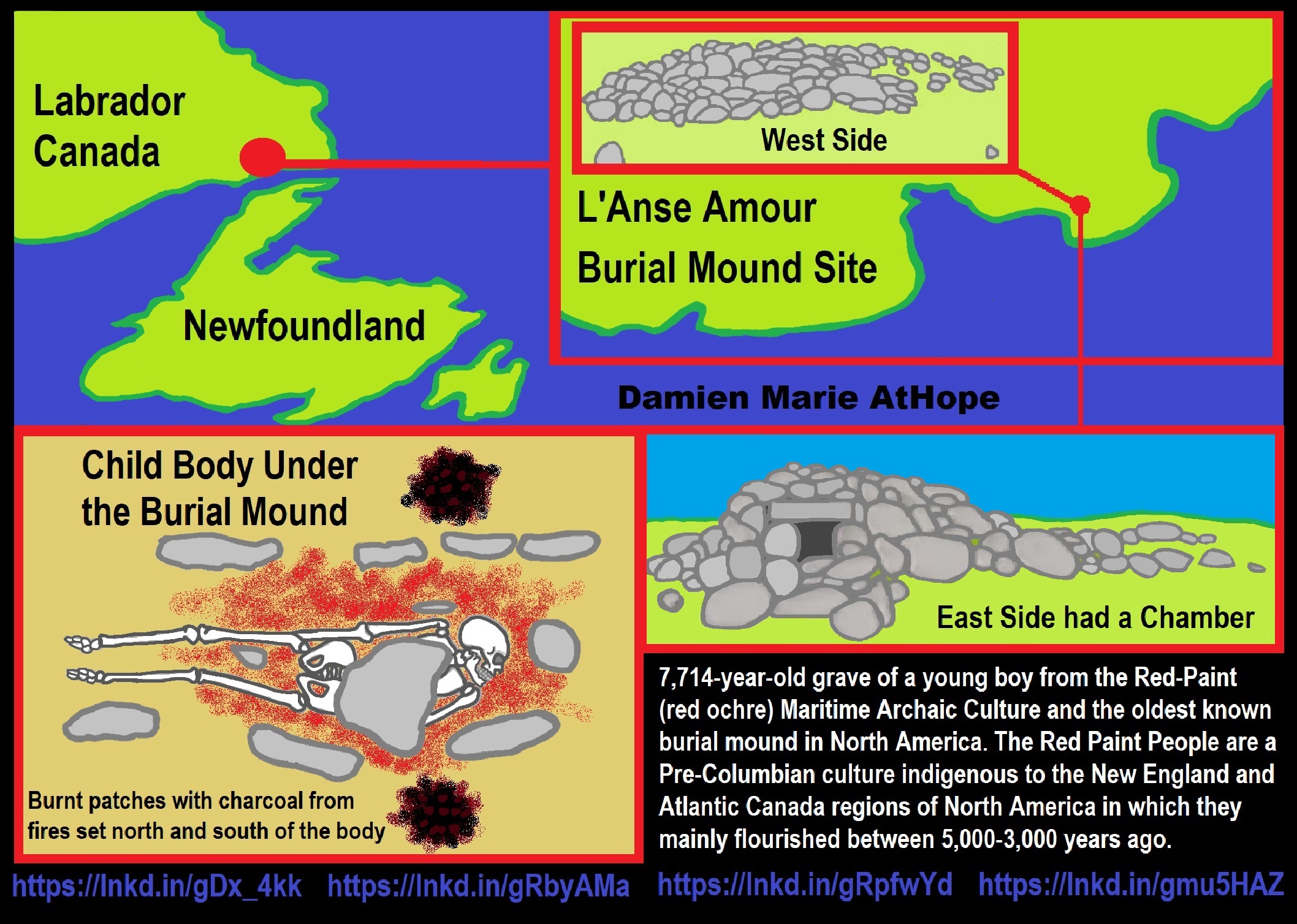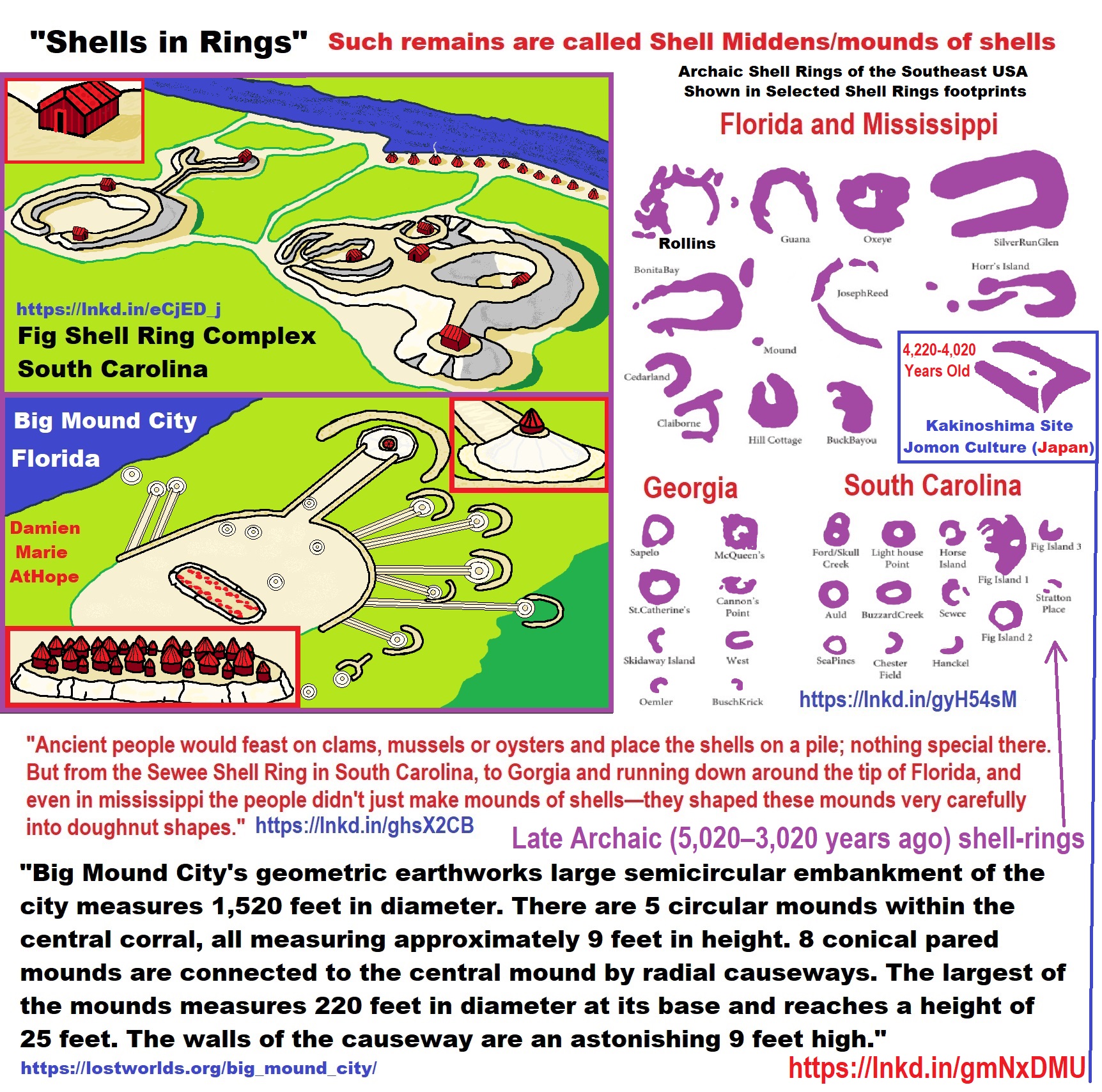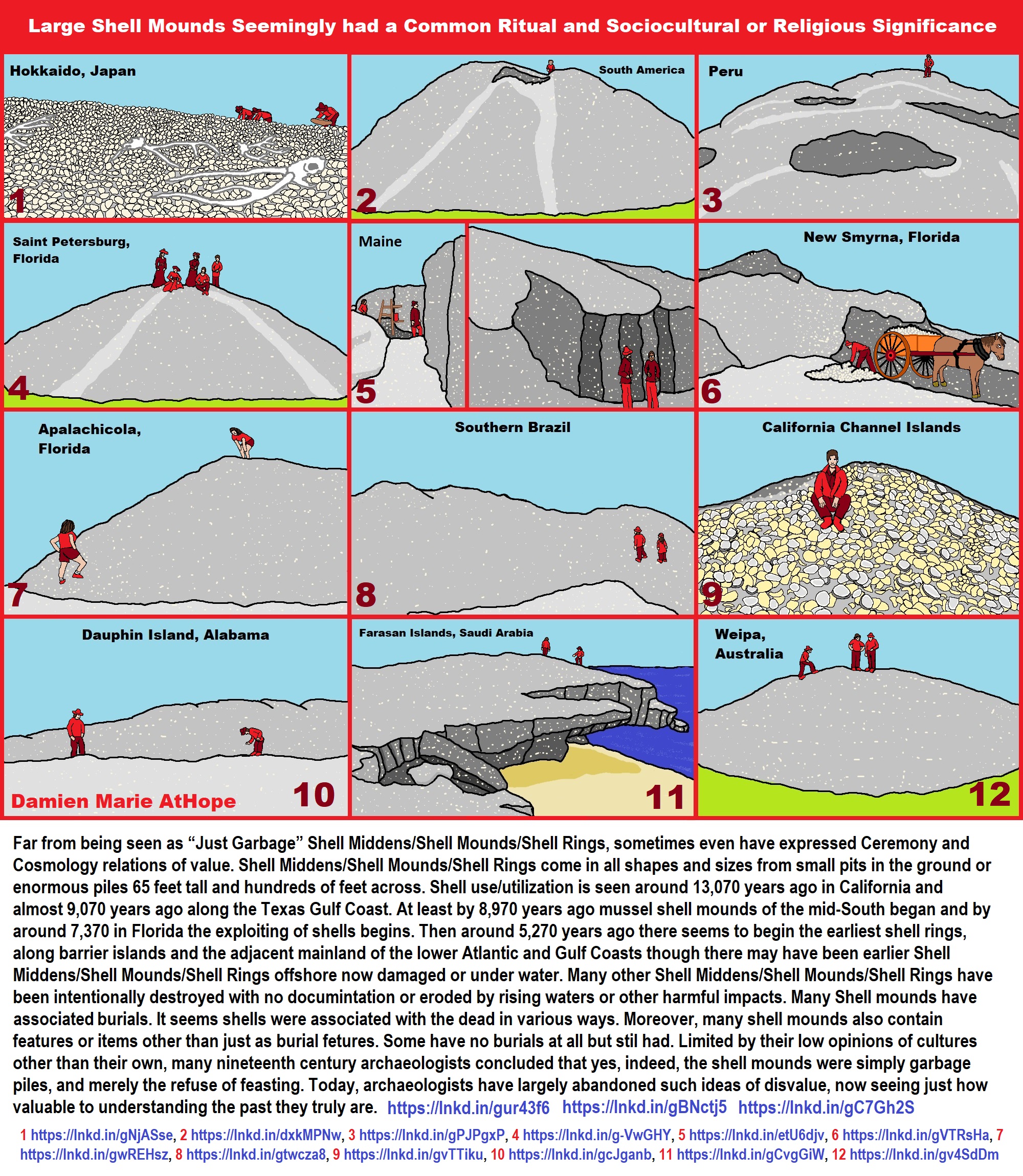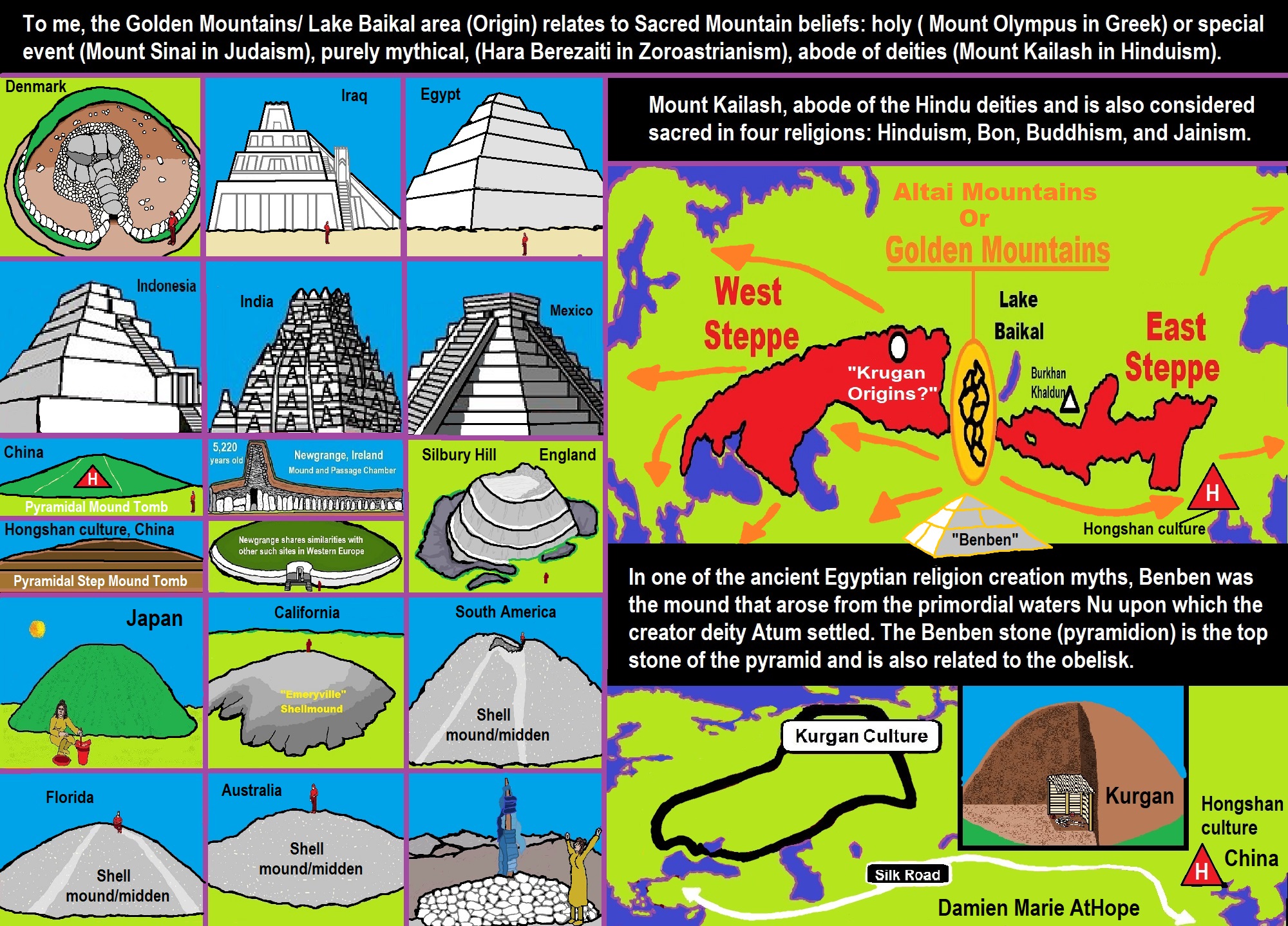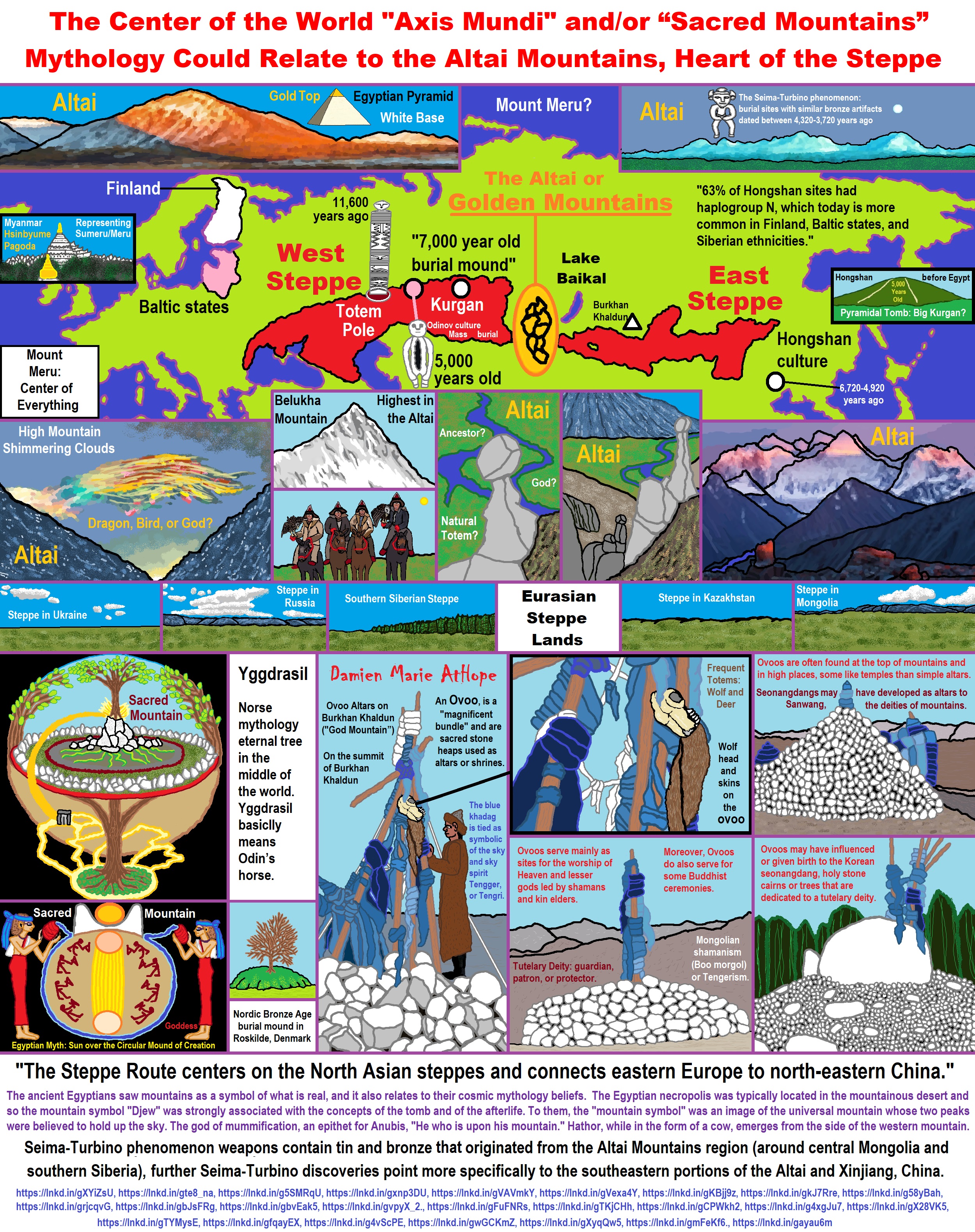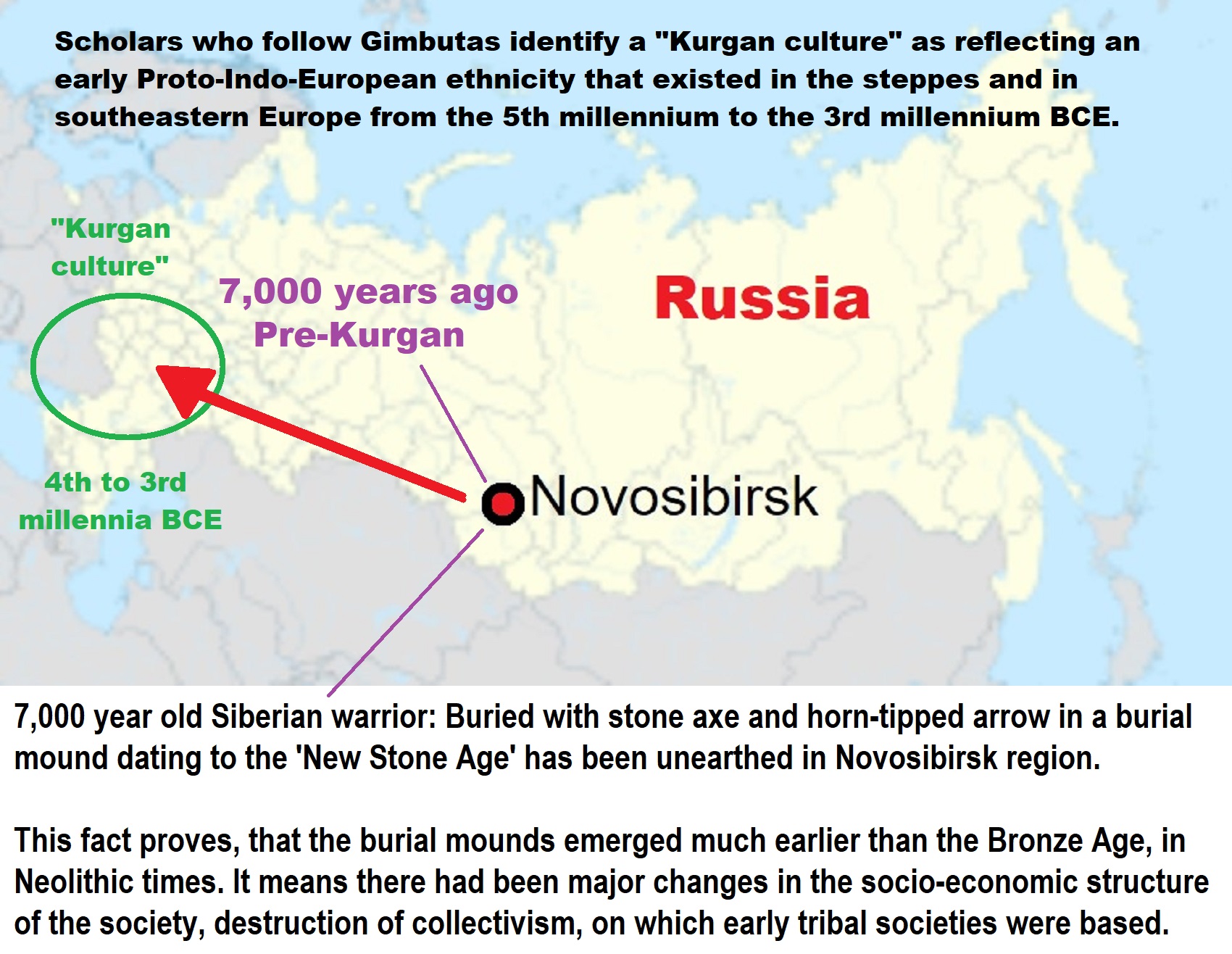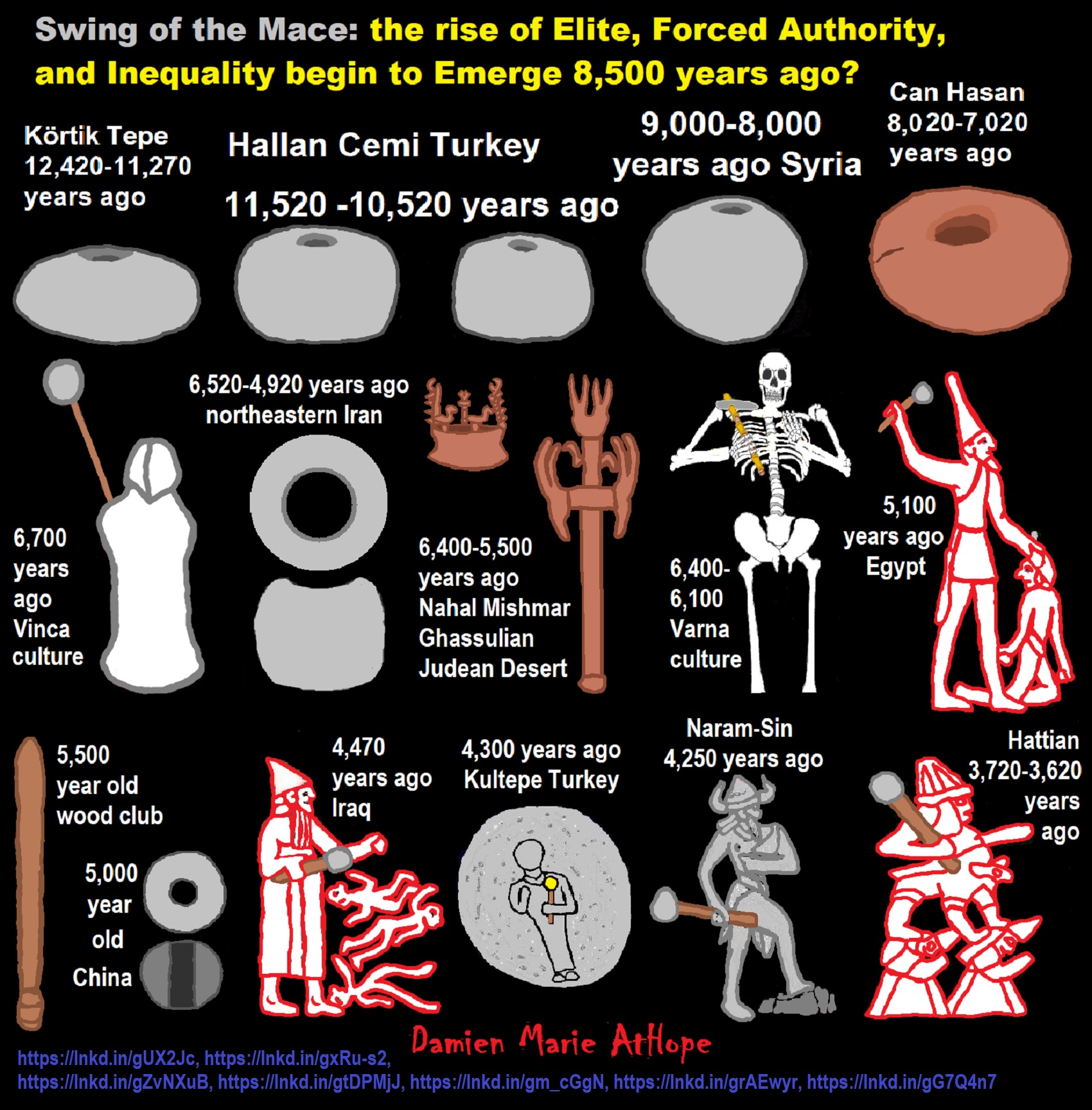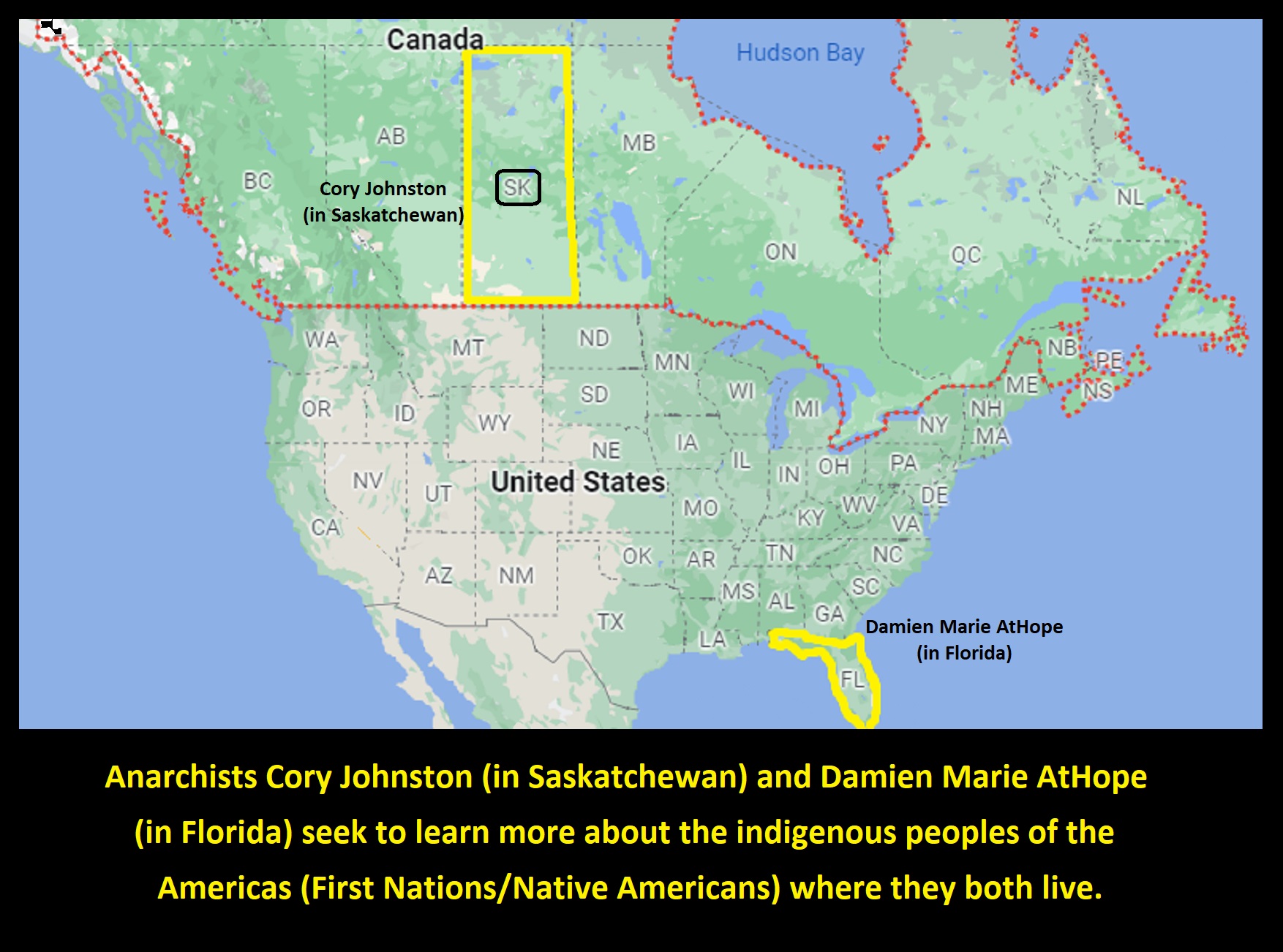
Religion ideas moved both directly by movements or migrations of people as well as by trade or transfer not related to migration. I see actual movements or migrations having more influence on the similar religion beliefs, to me. But both were involved in how religions evolved.
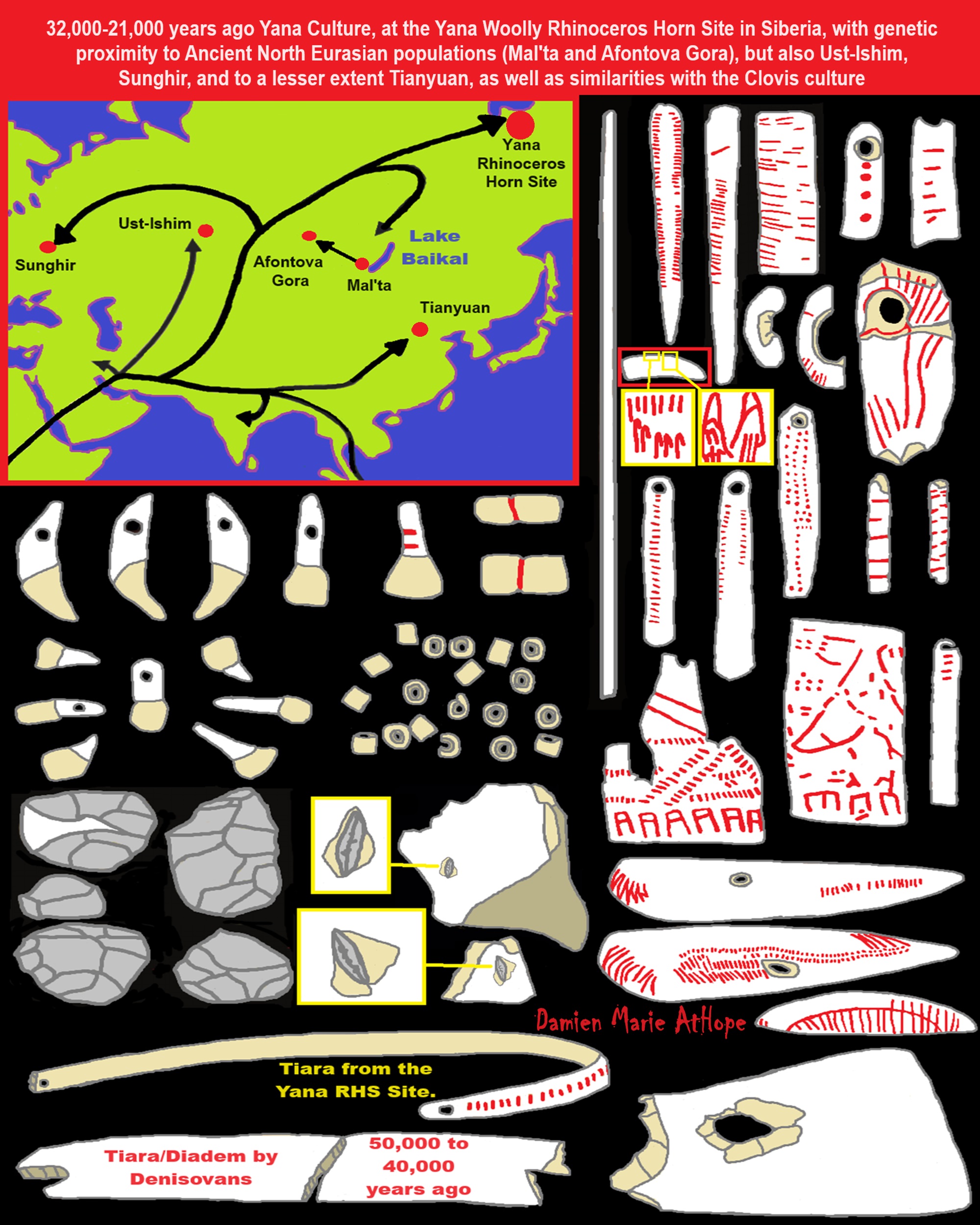
ref, ref, ref, ref, ref, ref, ref, ref
32,000-21,000 years ago, Yana Culture, at the Yana Woolly Rhinoceros Horn Site in Siberia, with genetic proximity to Ancient North Eurasian populations (Mal’ta, Afontova Gora), but also Ust-Ishim, Sunghir, and to a lesser extent Tianyuan, as well as similarities with the Clovis culture
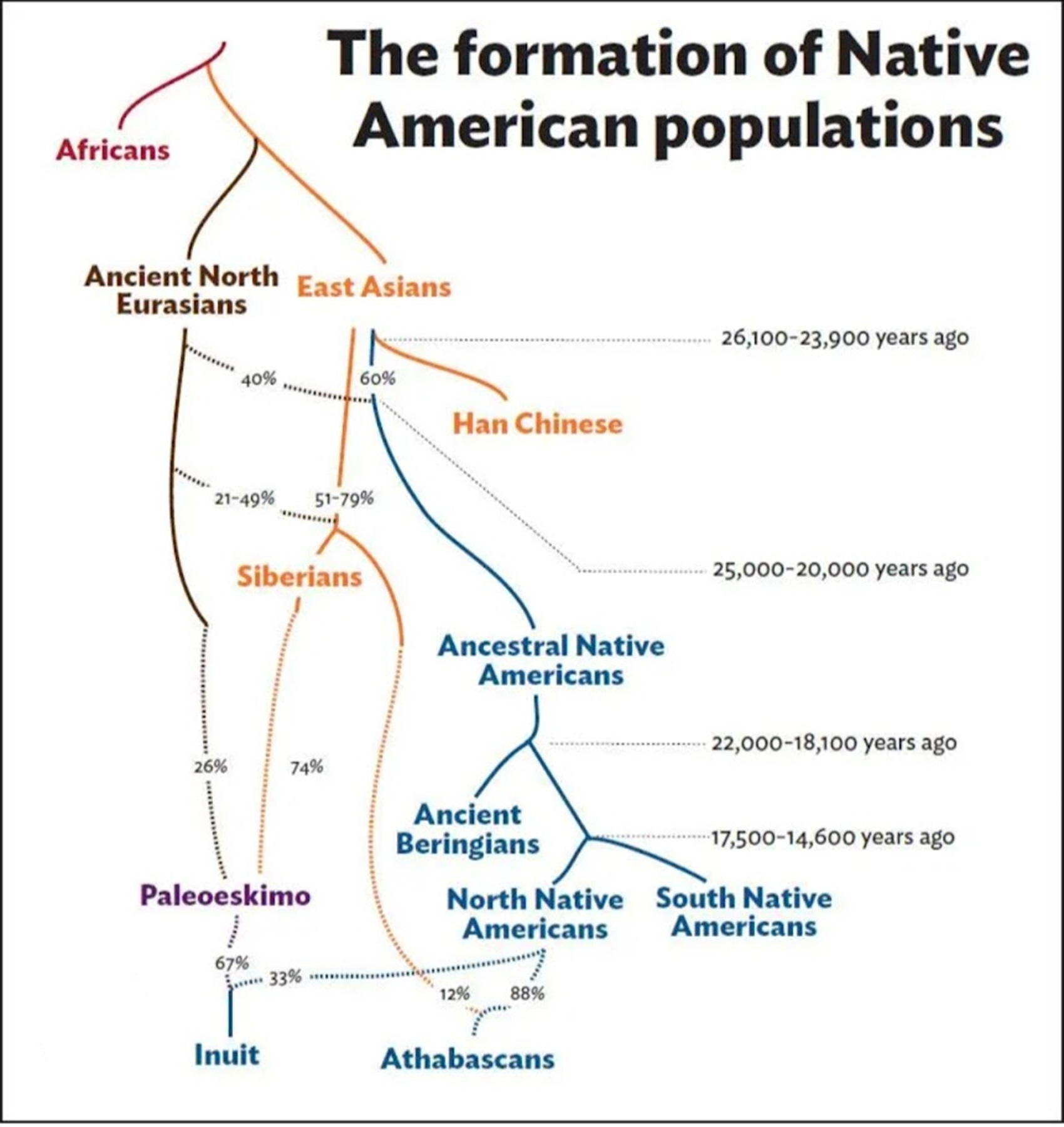


“P-M45 (P1c, formerly P1) commonly found among Siberians and Central Asians. P-M45 (P1c) is, in turn, the parent node of Haplogroup Q (Q-M242) and Haplogroup R (R-M207). The major subclades of Haplogroups P-M45, Q and R now include most males among Europeans, Native Americans, South Asians and Central Asians.” ref
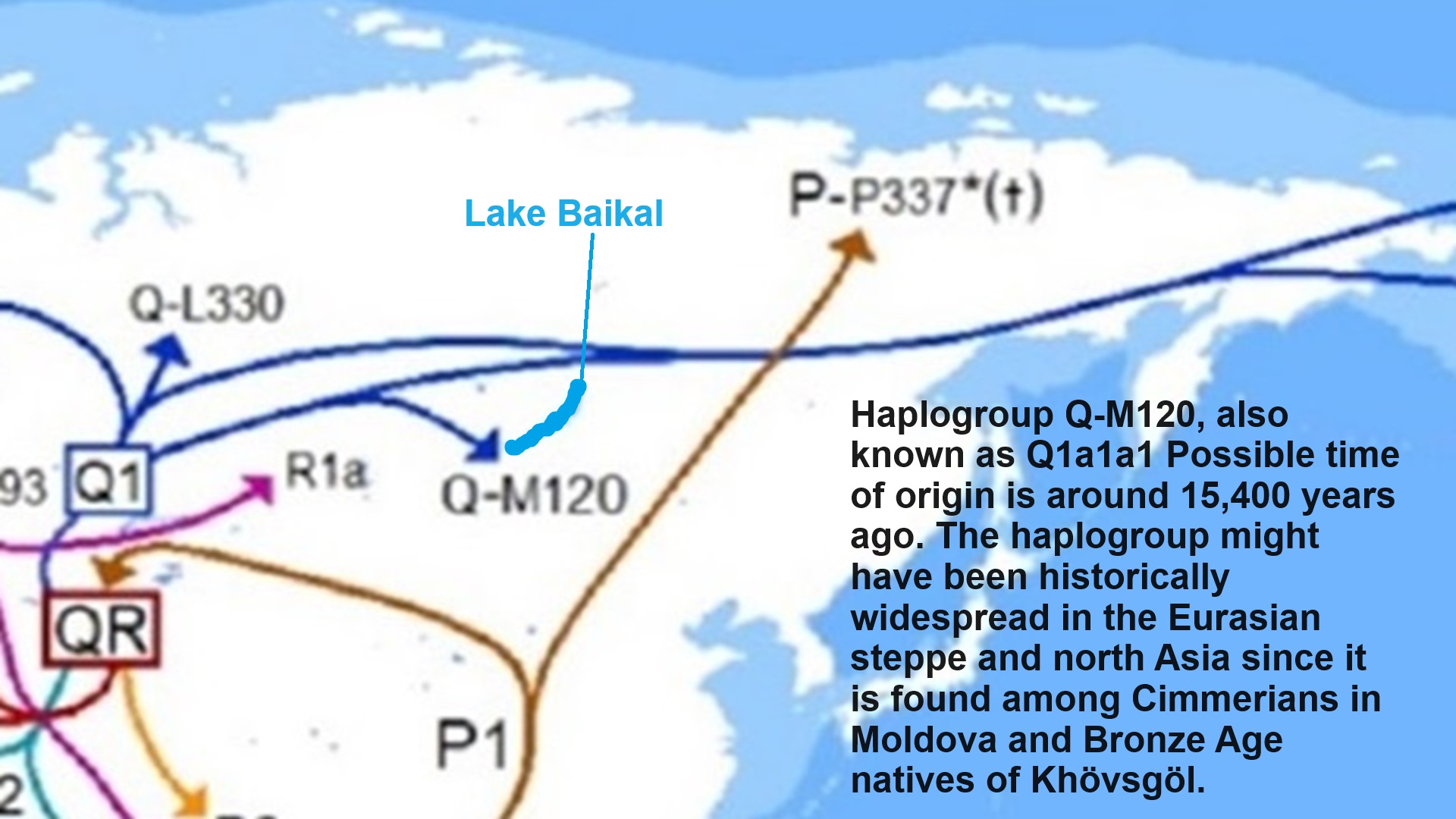
“Haplogroup Q-M120, also known as Q1a1a1, is a Y-DNA haplogroup. It is the only primary branch of haplogroup Q1a1a (F746/NWT01). The lineage is most common amongst modern populations in eastern Eurasia. But the haplogroup might have been historically widespread in the Eurasian steppe and north Asia since it is found among Cimmerians in Moldova and Bronze Age natives of Khövsgöl. Possible time of origin is about 15,400 years ago.” ref
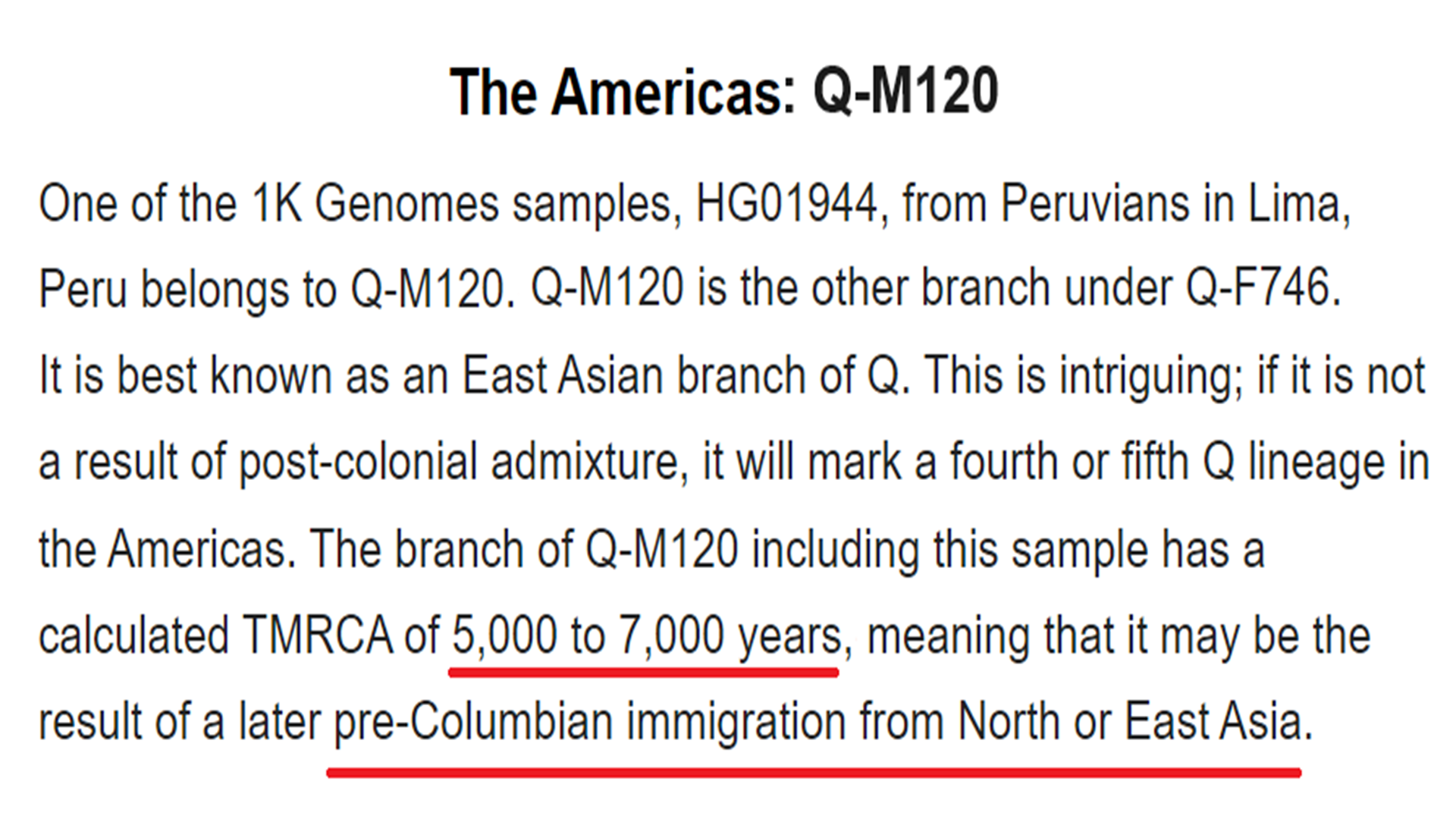
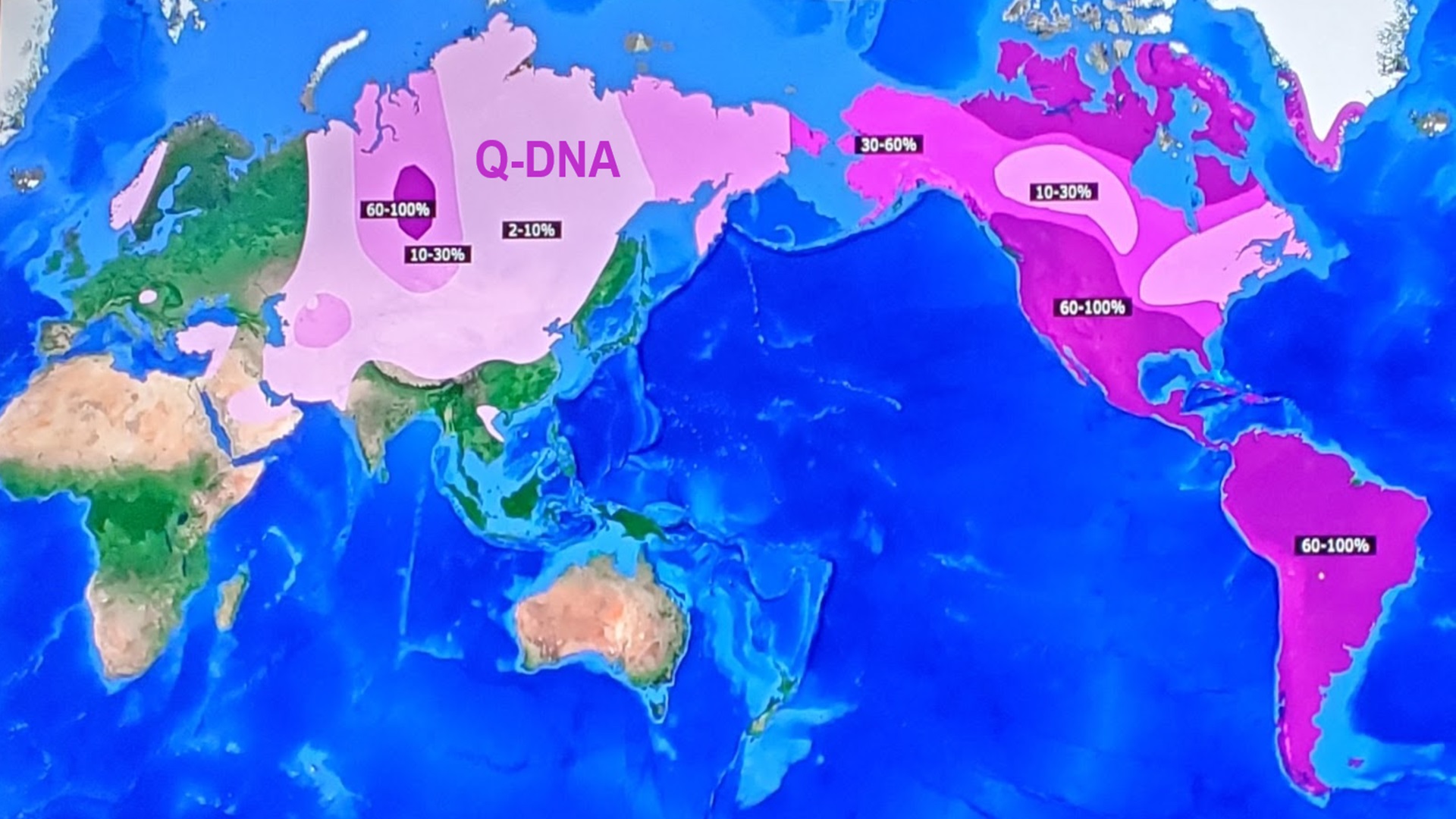
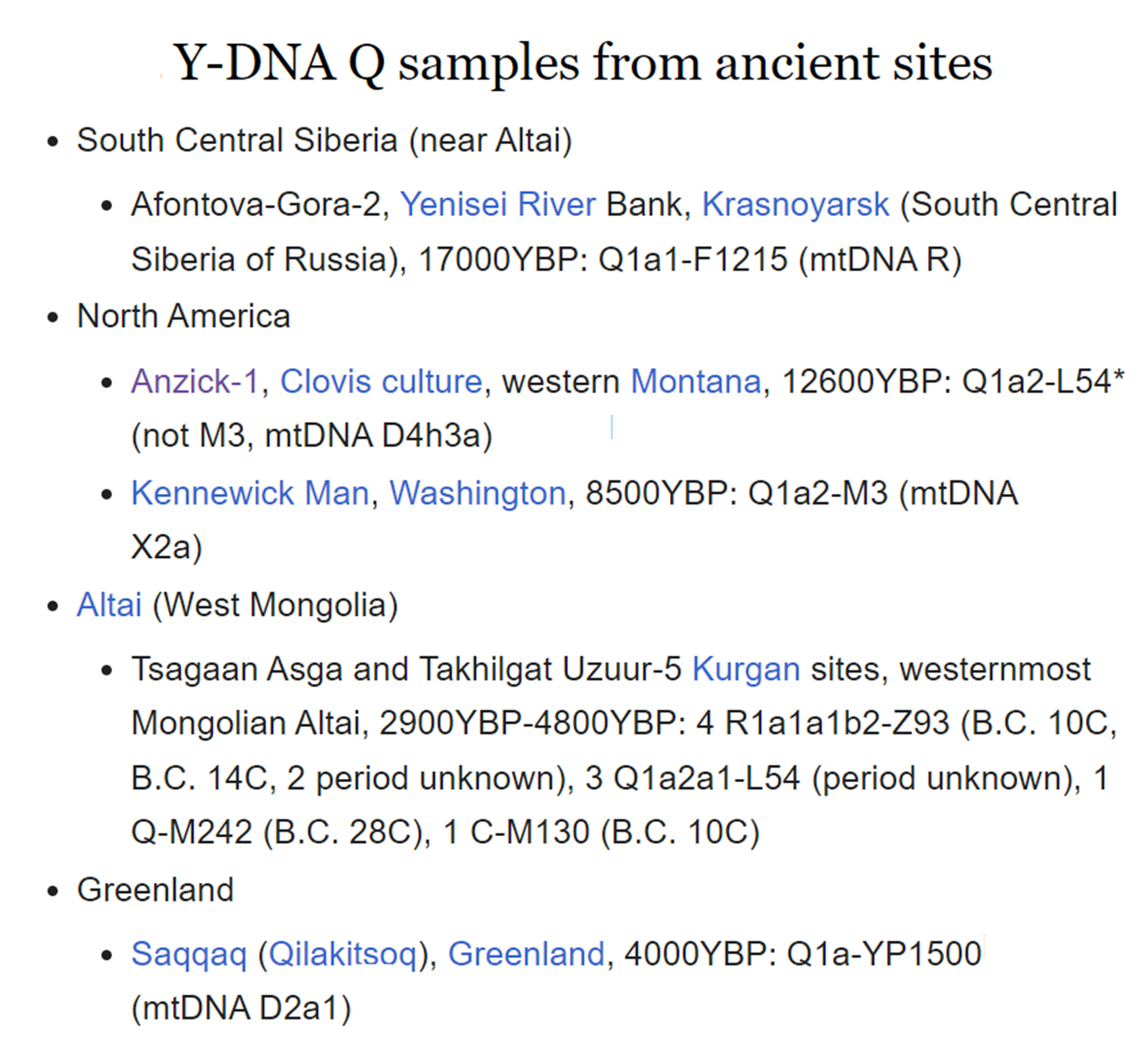

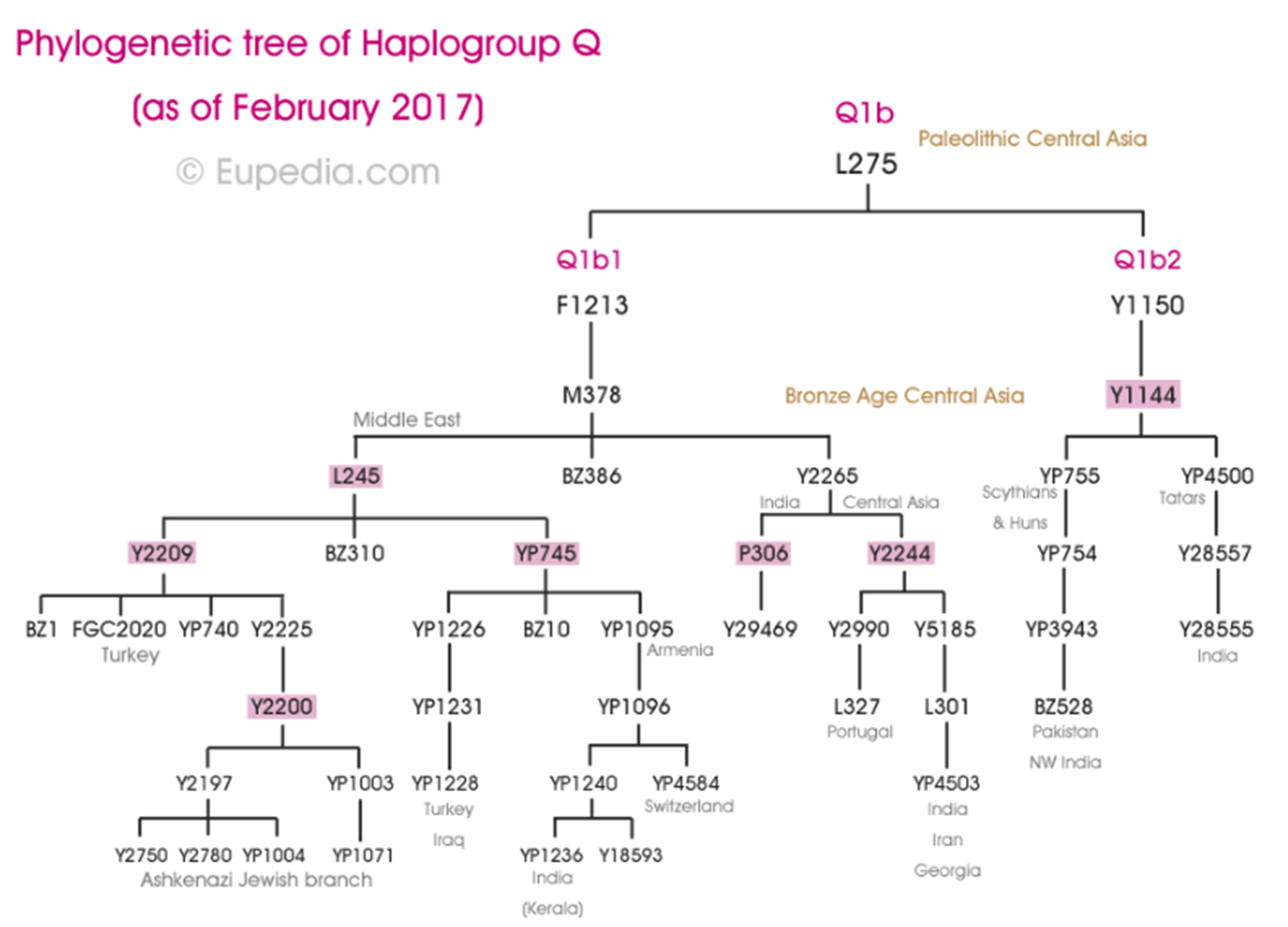
“Radiocarbon dating of the layers of material indicates the mounds were built over thousands of years. These findings show that people began to build the first mound about 11,000 years ago. New research reveals more information about the LSU Campus Mounds, including the discovery of thousands of years old charred mammal bone fragments and a coordinated alignment of both mounds toward one of the brightest stars in the night sky. This new information offers more insight into the oldest known man-made structures in the Americas. The two large, grassy mounds that are about 20 feet tall, on LSU’s campus, are among the more than 800 man-made, hill-like mounds in Louisiana, built by ancient indigenous people. While many mounds in the region have been destroyed, the LSU Campus Mounds have been preserved and are listed on the National Register for Historic Places.” ref
“Determining the time depth or antiquity of shell middens around the world is complicated by postglacial sea level rise that prohibits site discovery and is intertwined with how one defines a shell midden. Many shell middens, particularly large, diverse midden mounds, appeared during the Holocene, and shell middens of all types proliferated around the world after 8000–6000 years ago. The seemingly recent (Holocene) appearance or dramatic increase of shell middens was once used to indicate that marine and other aquatic resources were a late component of human adaptations and played a marginal or peripheral role in human evolution. However, marine and other aquatic foods have a deep history of use by anatomically modern humans and Neandertals, and some of these findings come from shell middens.” ref
“In the Americas, shell middens were widespread by the Early to Middle Holocene, but research is helping understand the antiquity of coastal resource use and the peopling of the Americas. Evidence of the use of estuaries and kelp forests, marine shellfish, finfish, mammals, and birds has been documented in >12,000–10,000-year-old deposits from British Columbia, California’s Channel Islands, and Baja California. In South America, layers of shell, bones, artifacts, charcoal, and other materials at Huaca Prieta are even older at 15,000–8000 years ago. Shell deposits elsewhere in Peru extend back roughly 13,200 to 11,200 years ago, and shell middens in northern Chile dated between ~12,900 and 9000 years ago. On the other side of the continent, early shell midden layers in the Bolivian lowlands of western Amazonia and at a riverine shell midden in Brazil extend back ~10,000 years.” ref
“In parts of South and North America, shell middens tend to be younger and increased greatly after ~7000 years ago. Given their conspicuous nature, shell middens are an obvious sign of people’s interactions with aquatic habitats, their movements around the world, and their colonization of offshore islands. This includes sites dated to the Late Pleistocene, but it also is important for tracking later (Holocene) movements of people. On the Farasan Islands, Saudi Arabia, a region hypothesized as an area for potential migration between Africa and Asia, over 3000 shell middens primarily dated from 7360–4700 years ago have been discovered. Despite their Holocene age, these sites have implications for how we interpret other early sites containing shellfish around the world.” ref
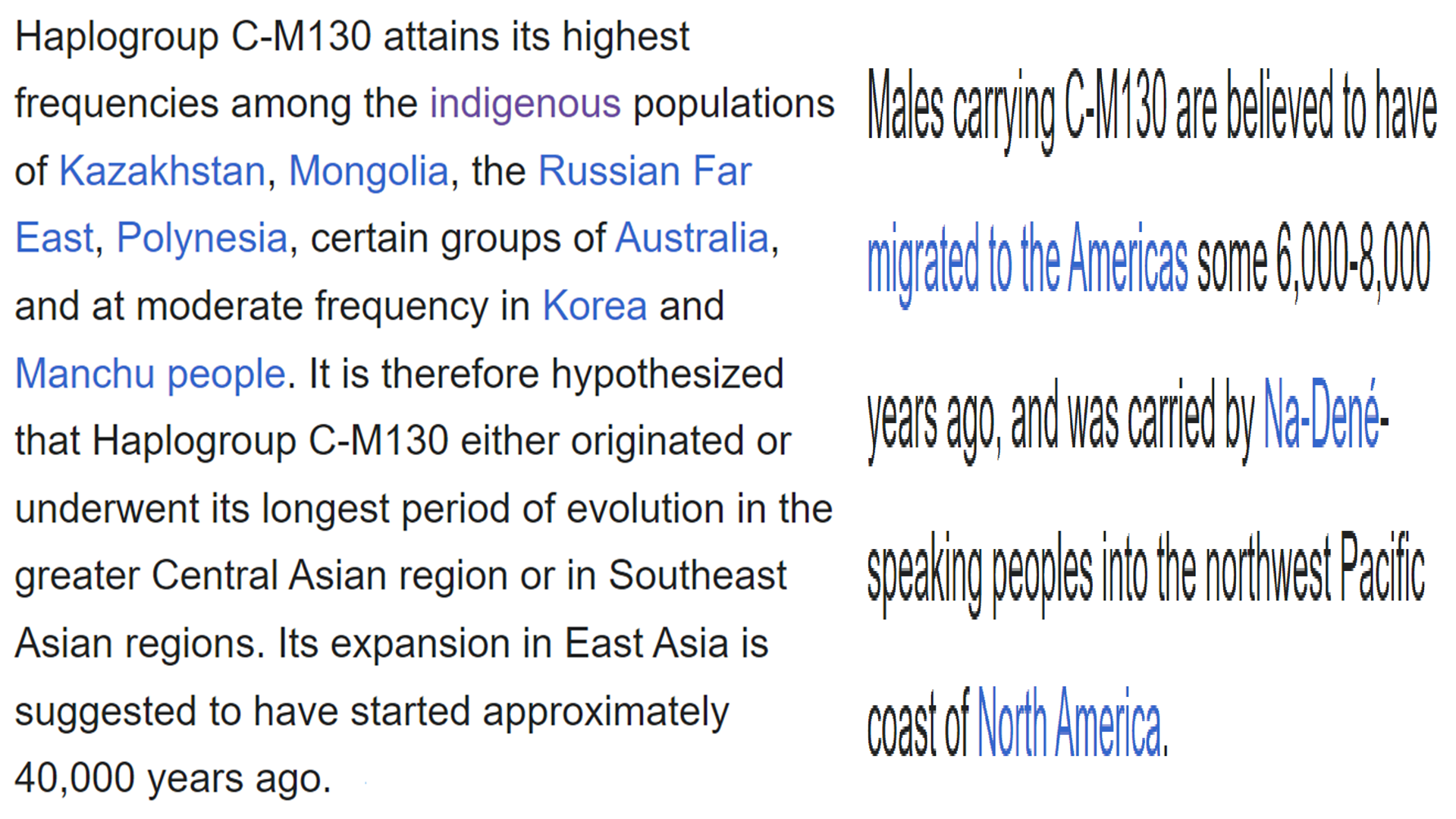
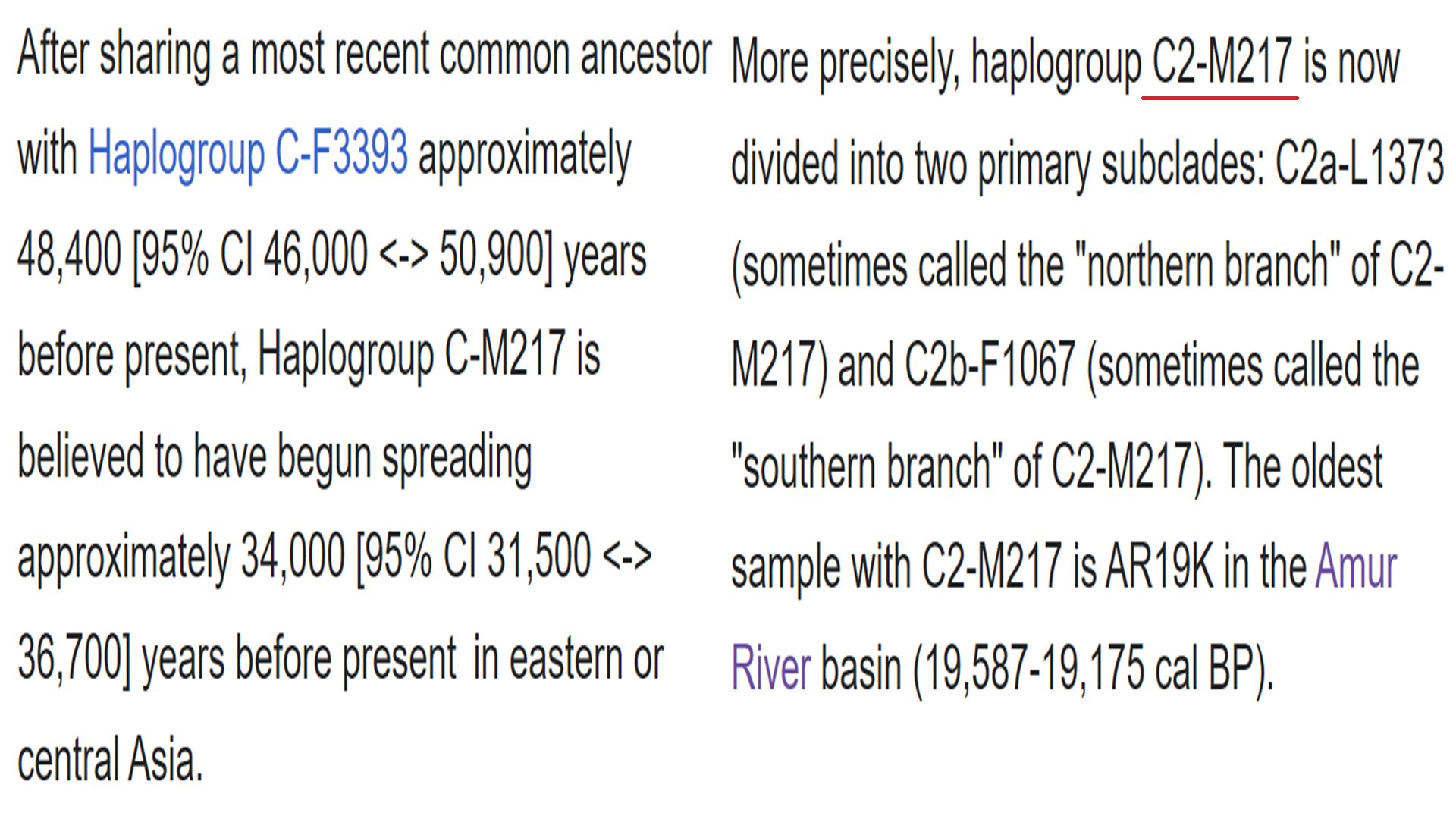
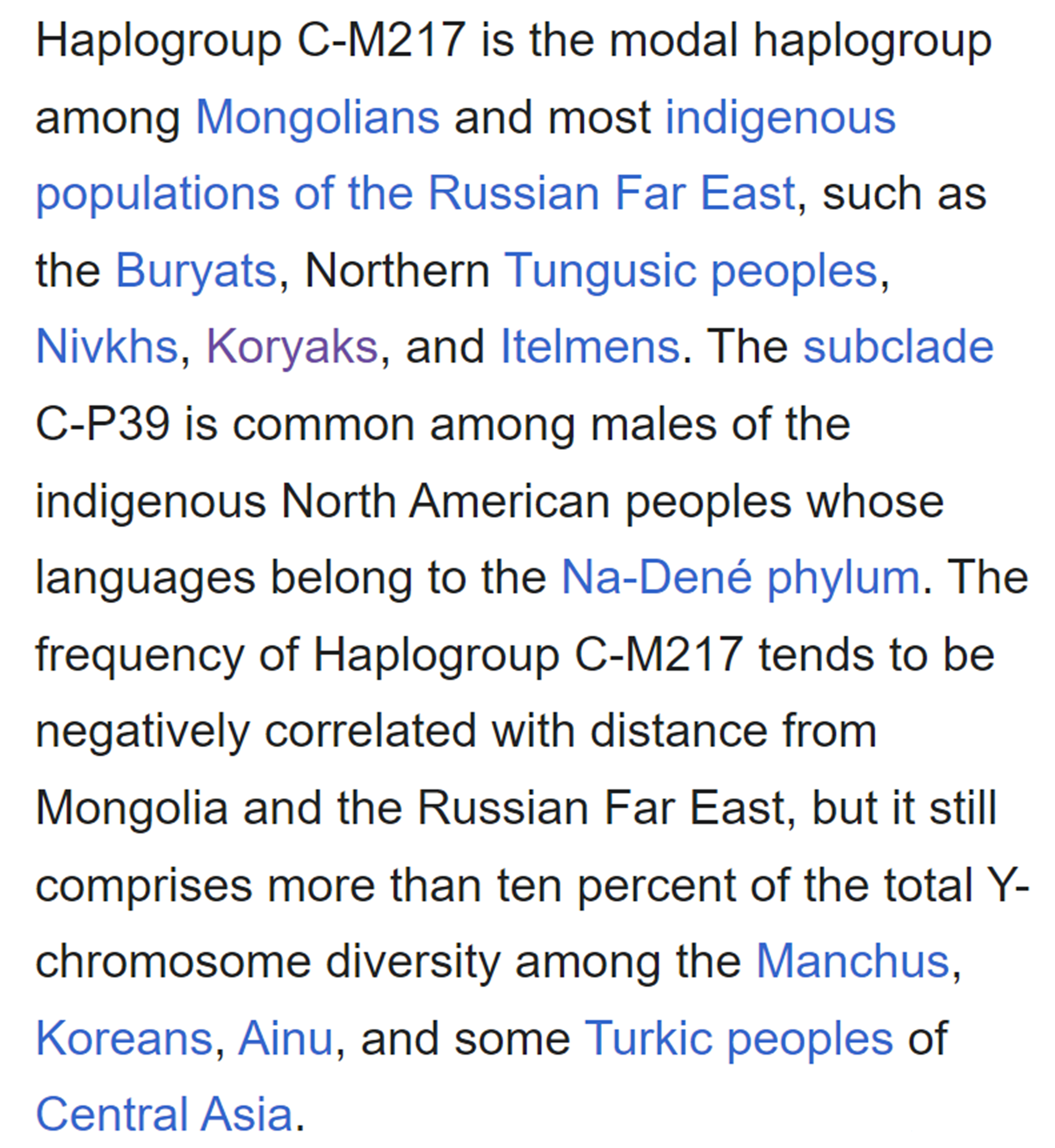
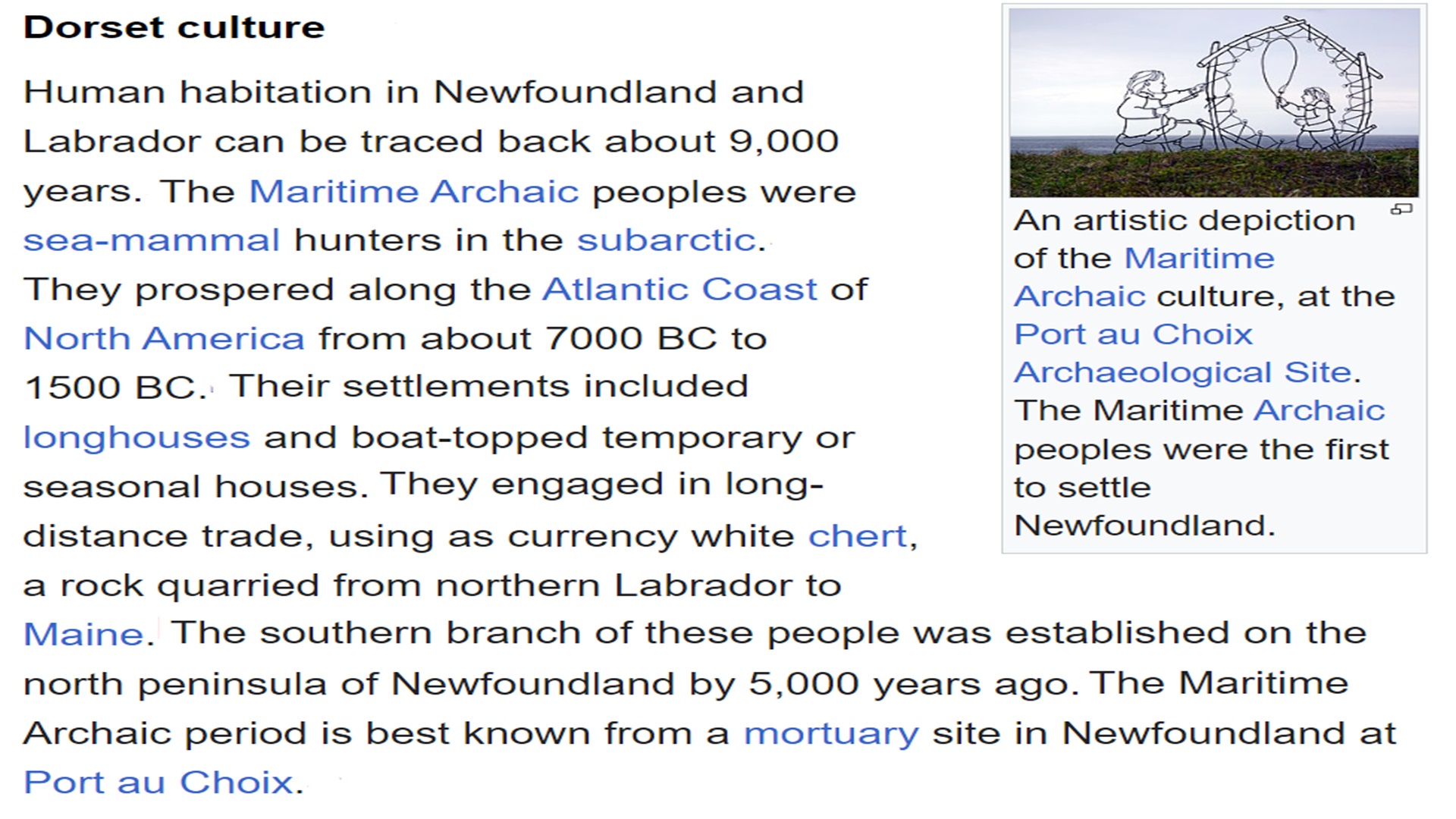
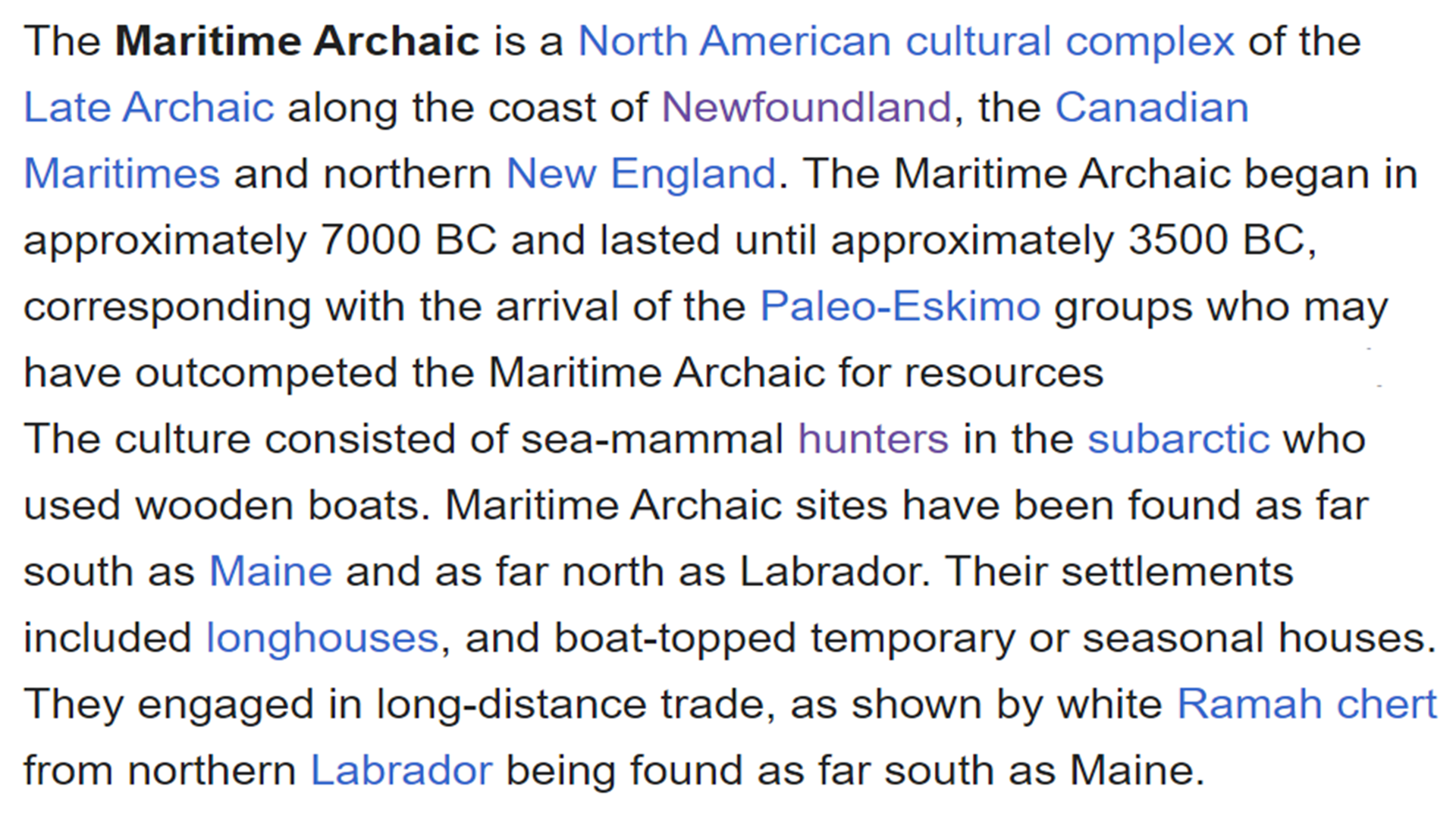
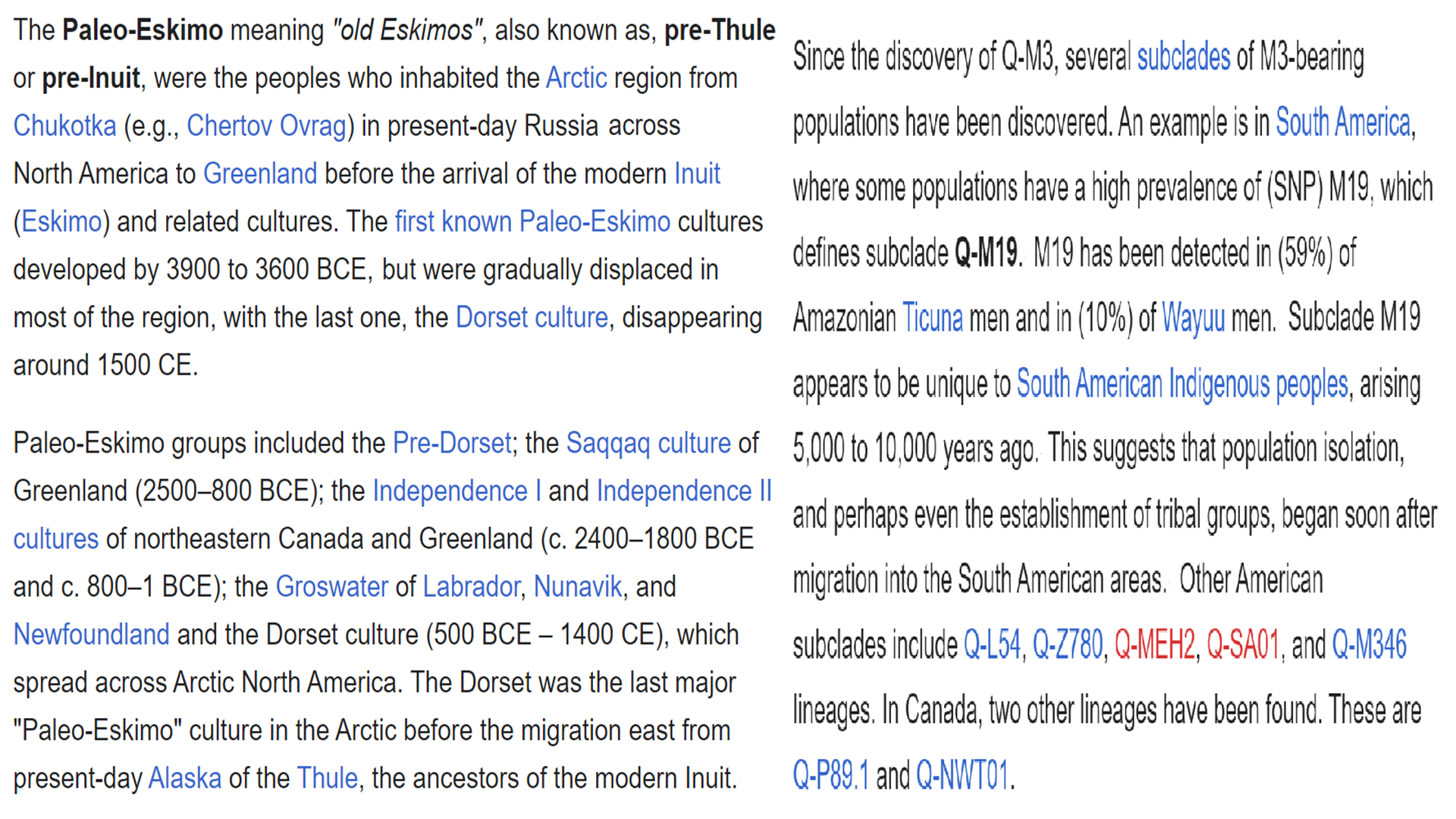
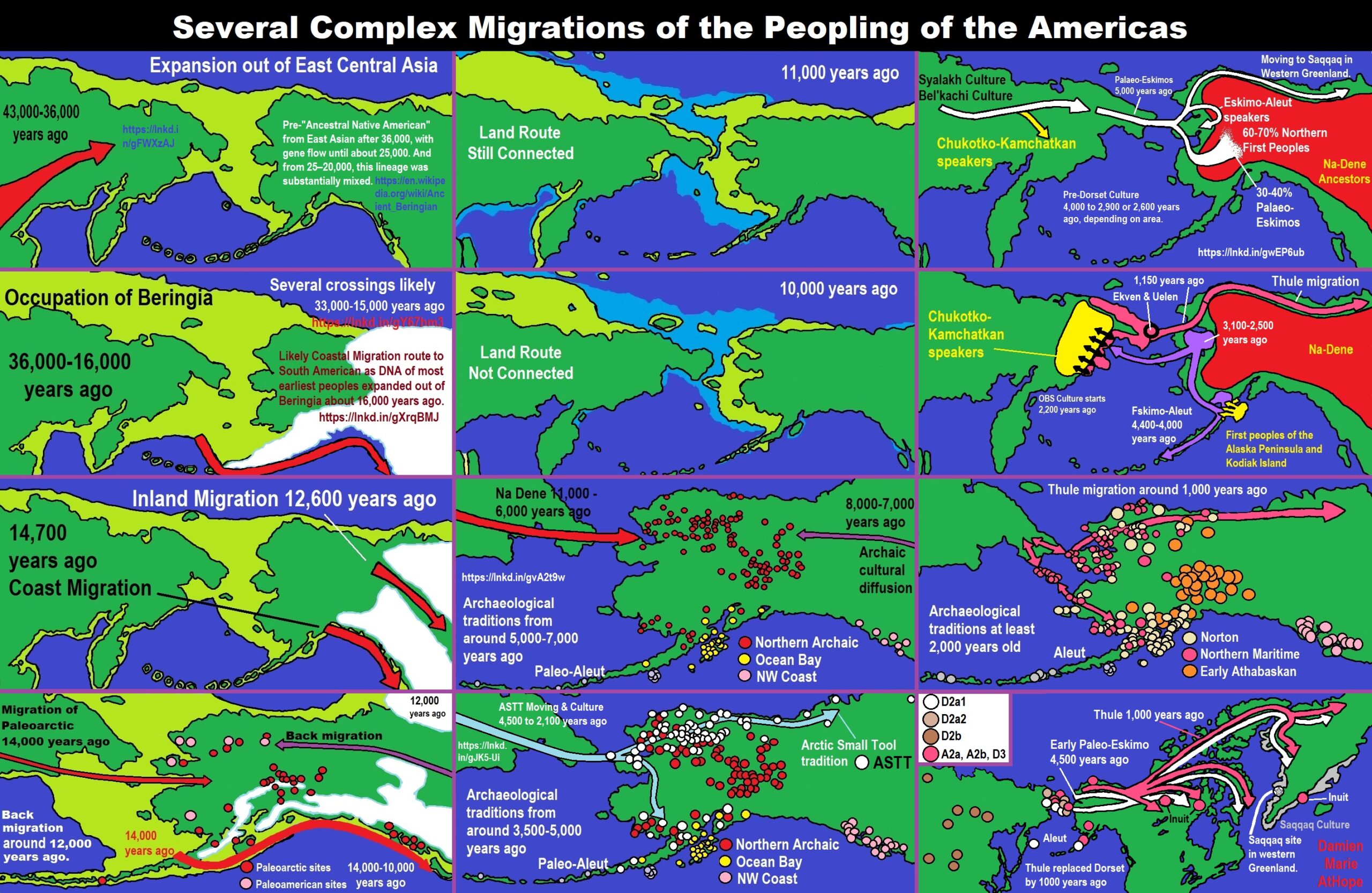
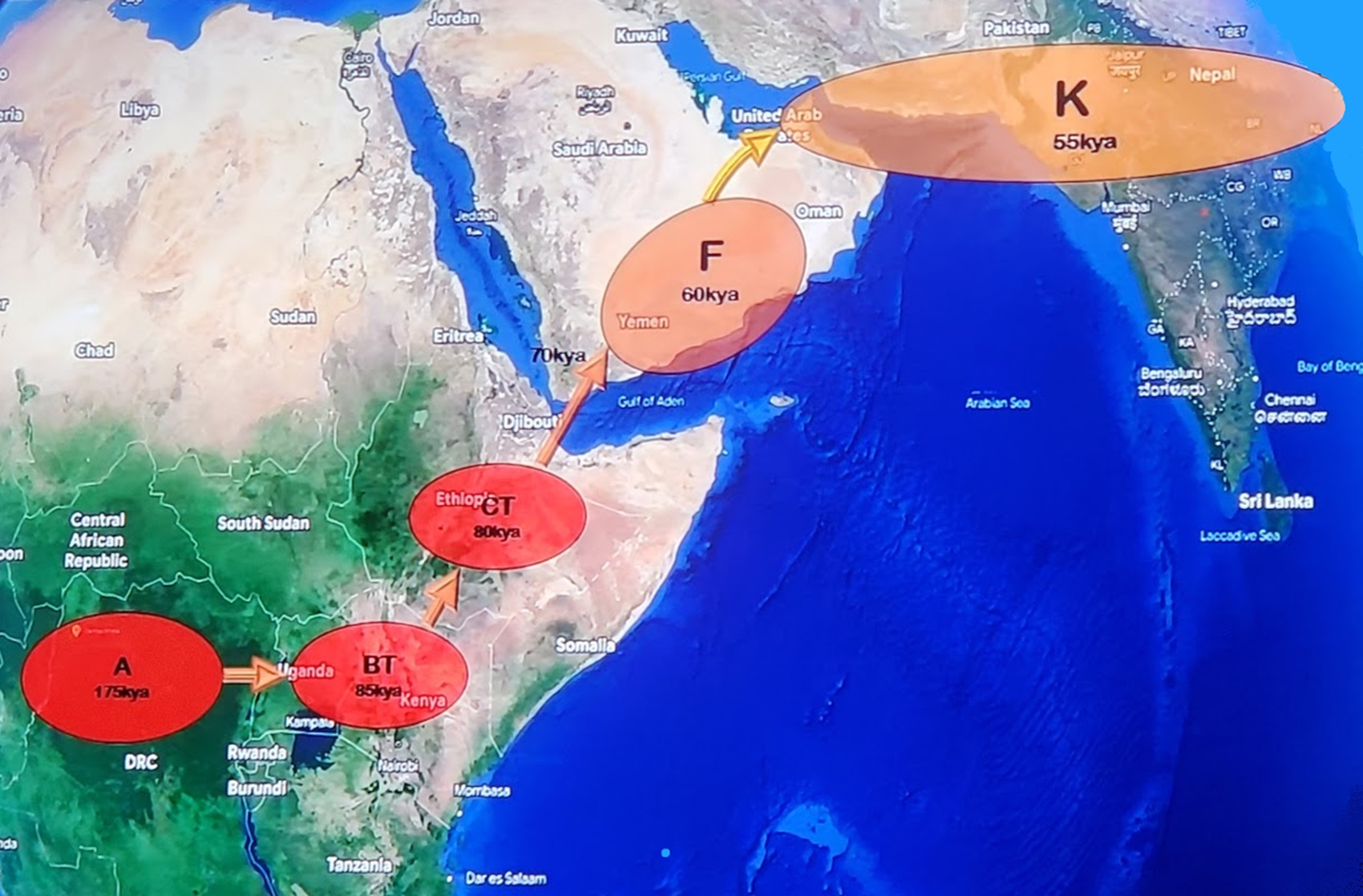


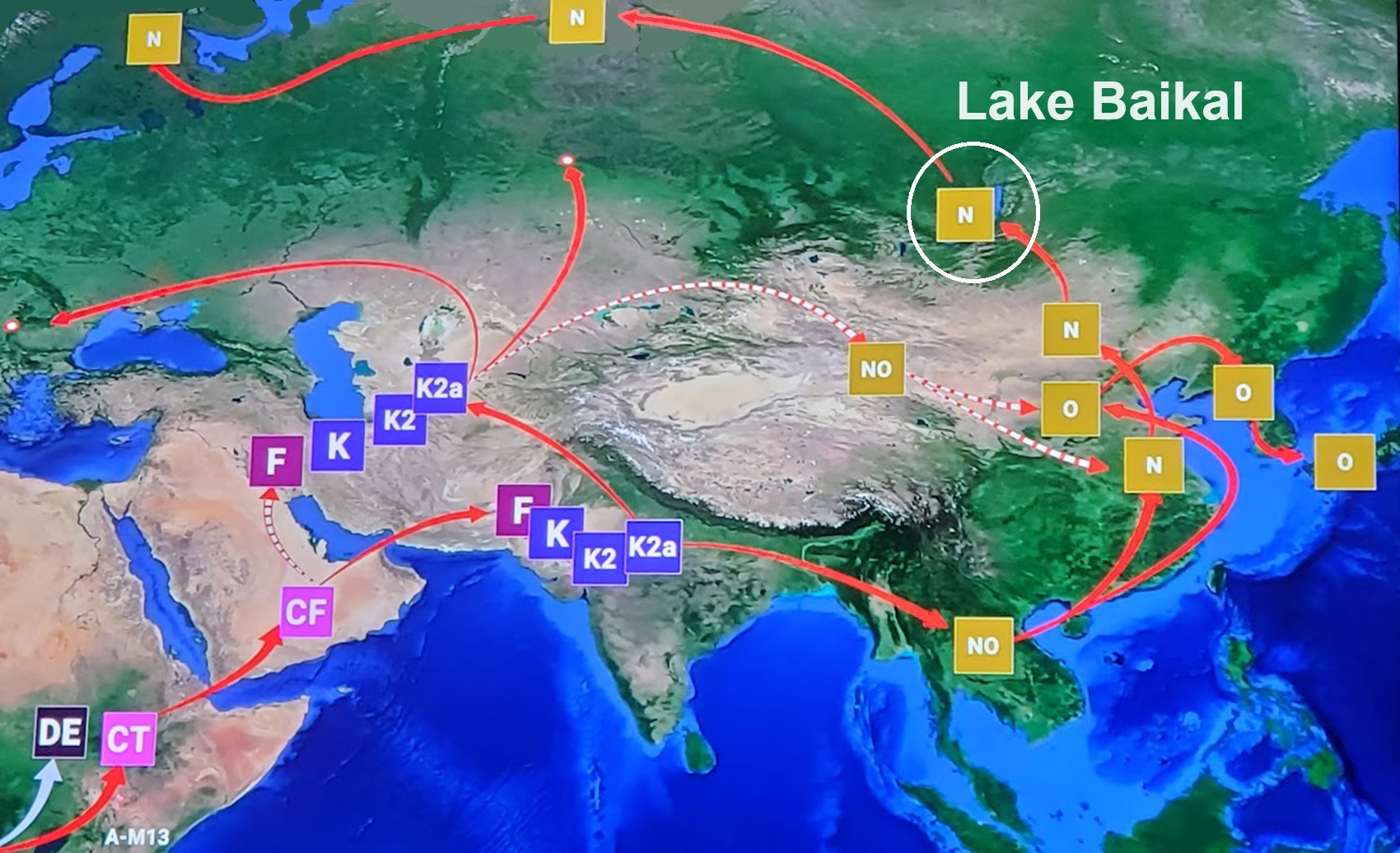

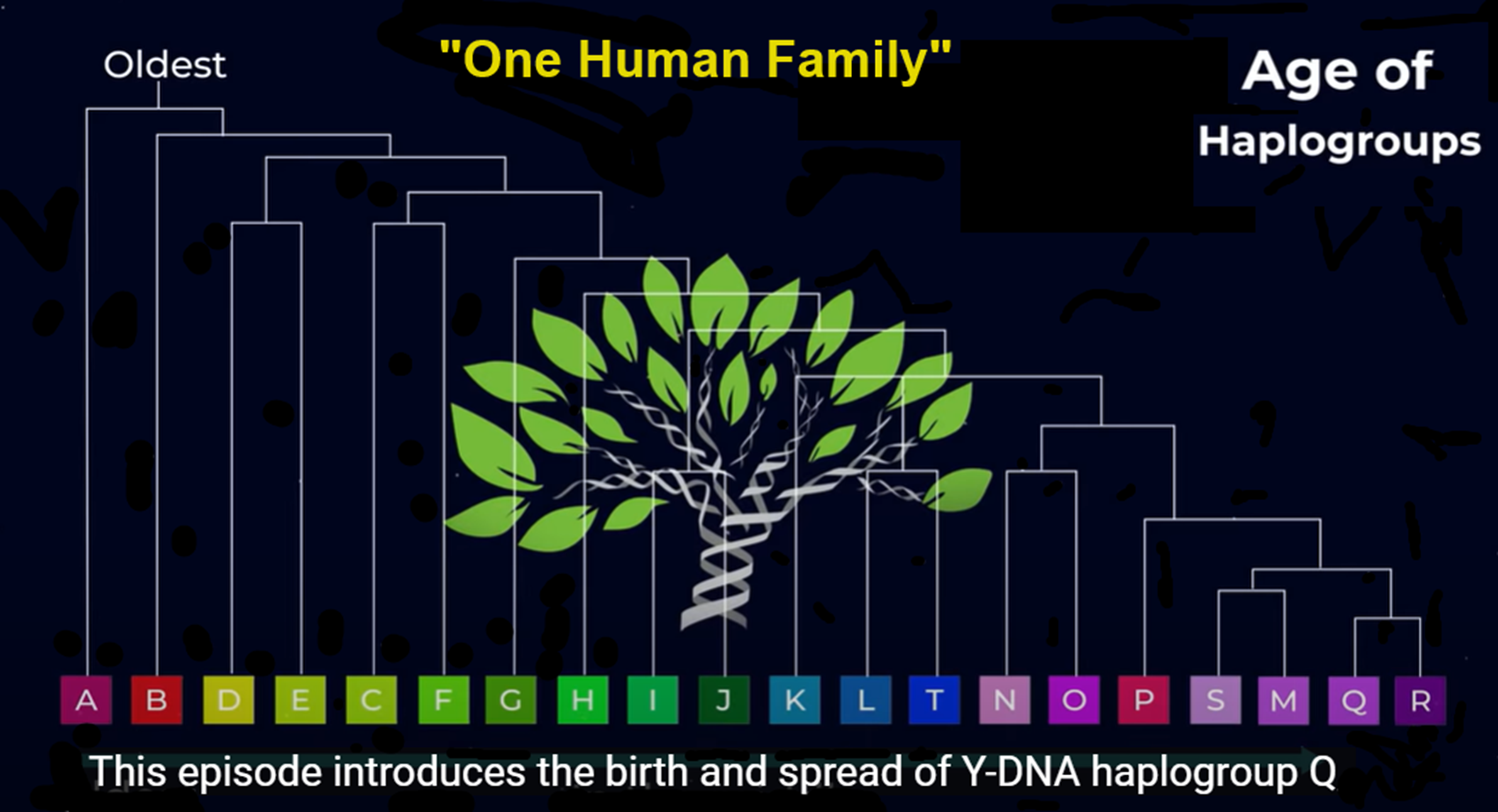
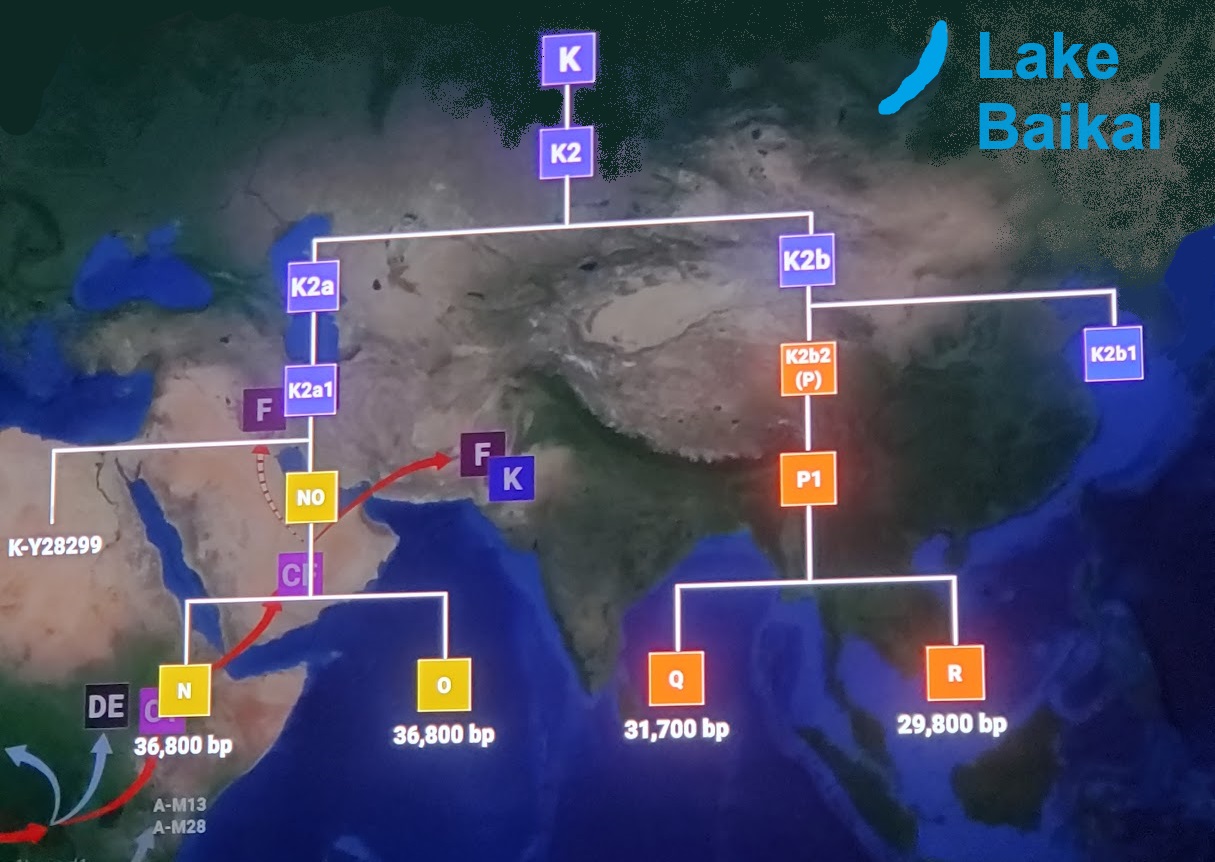
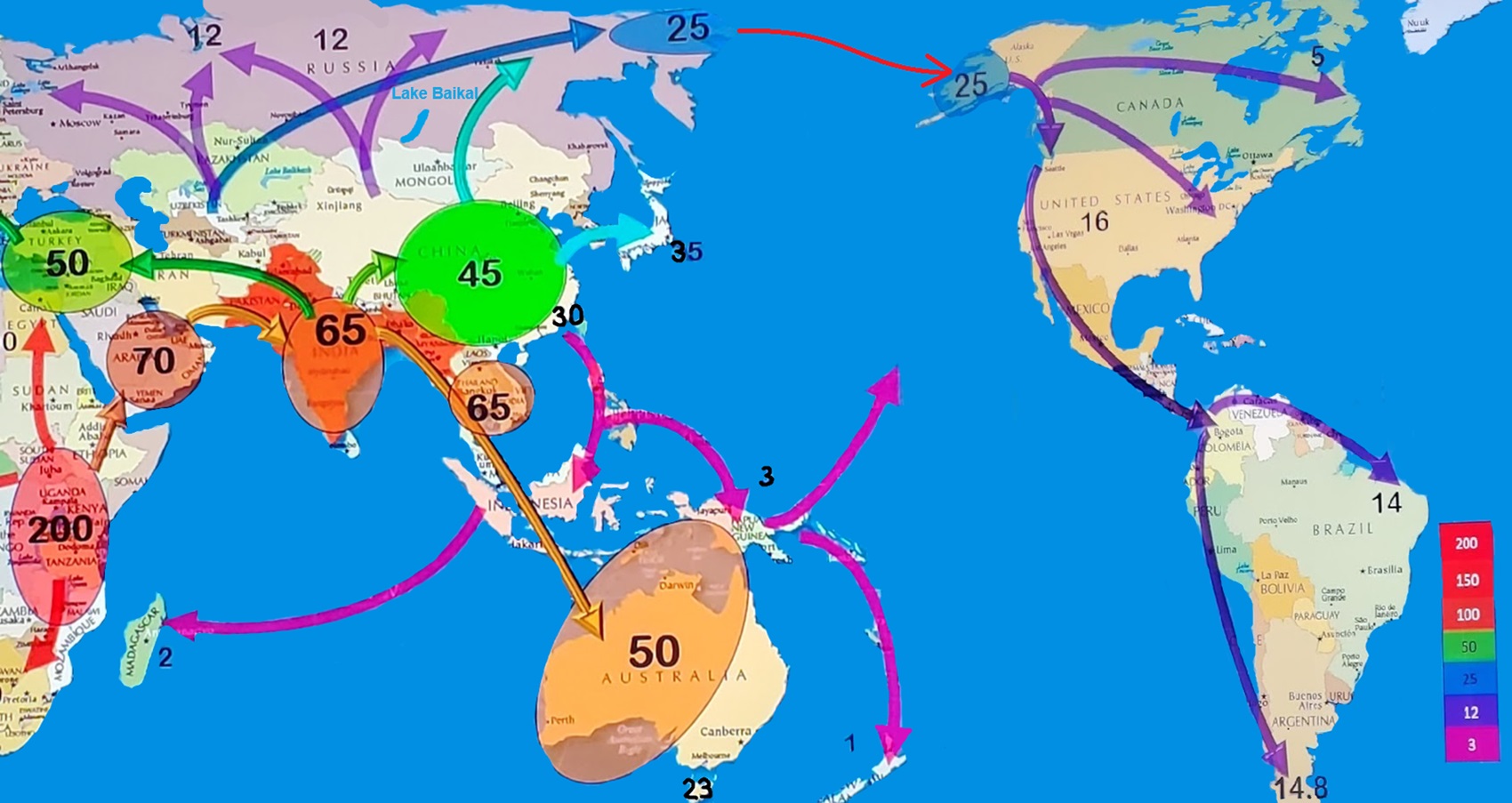

Paternal origin of Paleo-Indians in Siberia: insights from Y-chromosome sequences
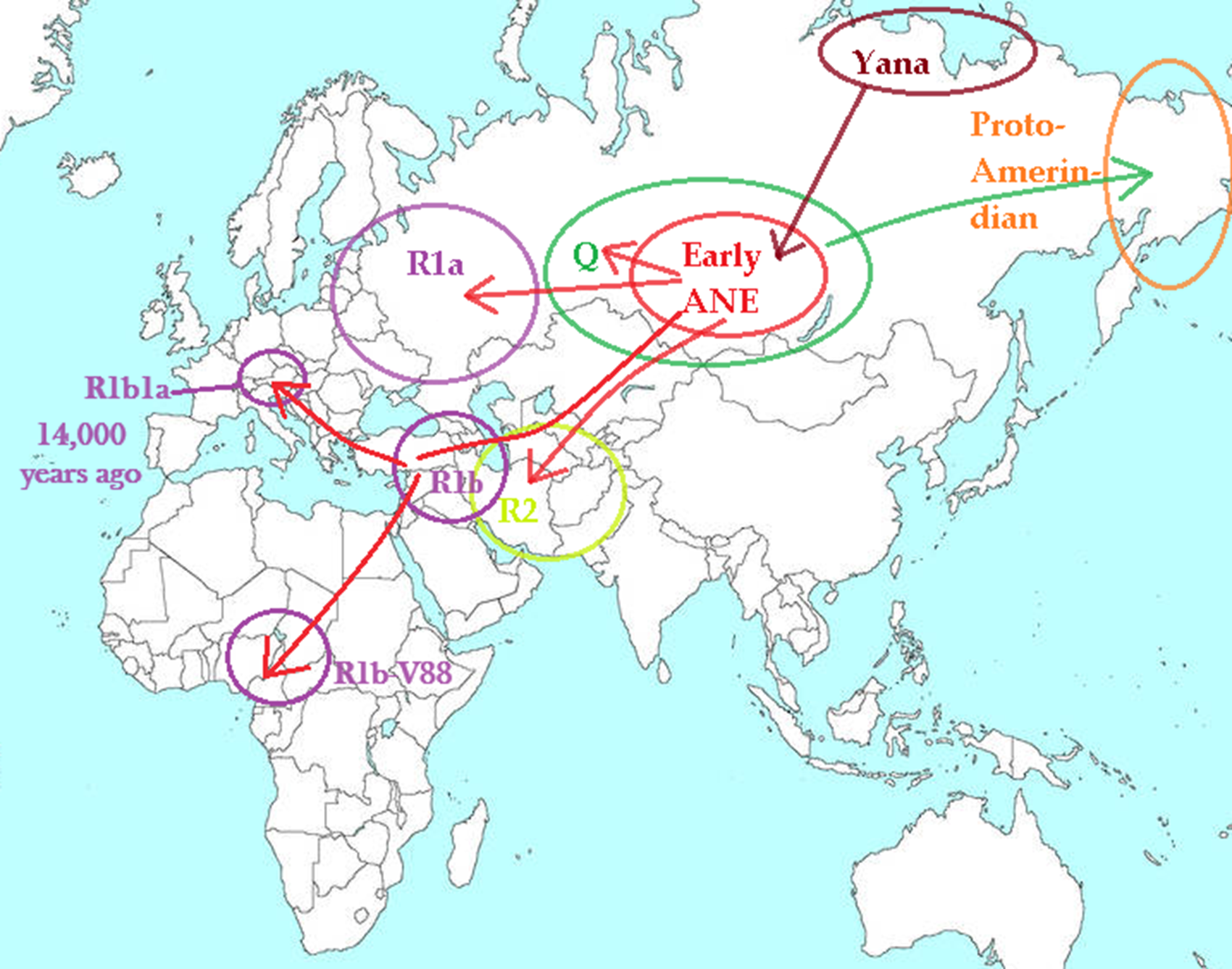
Haplogroup migrations related to the Ancient North Eurasians: I added stuff to this map to help explain.
People reached Lake Baikal Siberia around 25,000 years ago. They (to Damien) were likely Animistic Shamanists who were also heavily totemistic as well. Being animistic thinkers they likely viewed amazing things in nature as a part of or related to something supernatural/spiritual (not just natural as explained by science): spirit-filled, a sprit-being relates to or with it, it is a sprit-being, it is a supernatural/spiritual creature, or it is a great spirit/tutelary deity/goddess-god. From there comes mythology and faith in things not seen but are believed to somehow relate or interact with this “real world” we know exists.
Both areas of Lake Baikal, one on the west side with Ancient North Eurasian culture and one on the east side with Ancient Northern East Asian culture (later to become: Ancient Northeast Asian culture) areas are the connected areas that (to Damien) are the origin ancestry religion area for many mythologies and religious ideas of the world by means of a few main migrations and many smaller ones leading to a distribution of religious ideas that even though are vast in distance are commonly related to and centering on Lake Baikal and its surrounding areas like the Amur region and Altai Mountains region.
To an Animistic Thinker: “Things are not just as they seem, they may have a spirit, or spirit energy relates to them”
To a Totemistic Thinker: “Things are not just as they seem, they may have a spirit, or spirit energy relates to them; they may have religio-cultural importance.”
“Ancient North Eurasian population had Haplogroups R, P, U, and Q DNA types: defined by maternal West-Eurasian ancestry components (such as mtDNA haplogroup U) and paternal East-Eurasian ancestry components (such as yDNA haplogroup P1 (R*/Q*).” ref
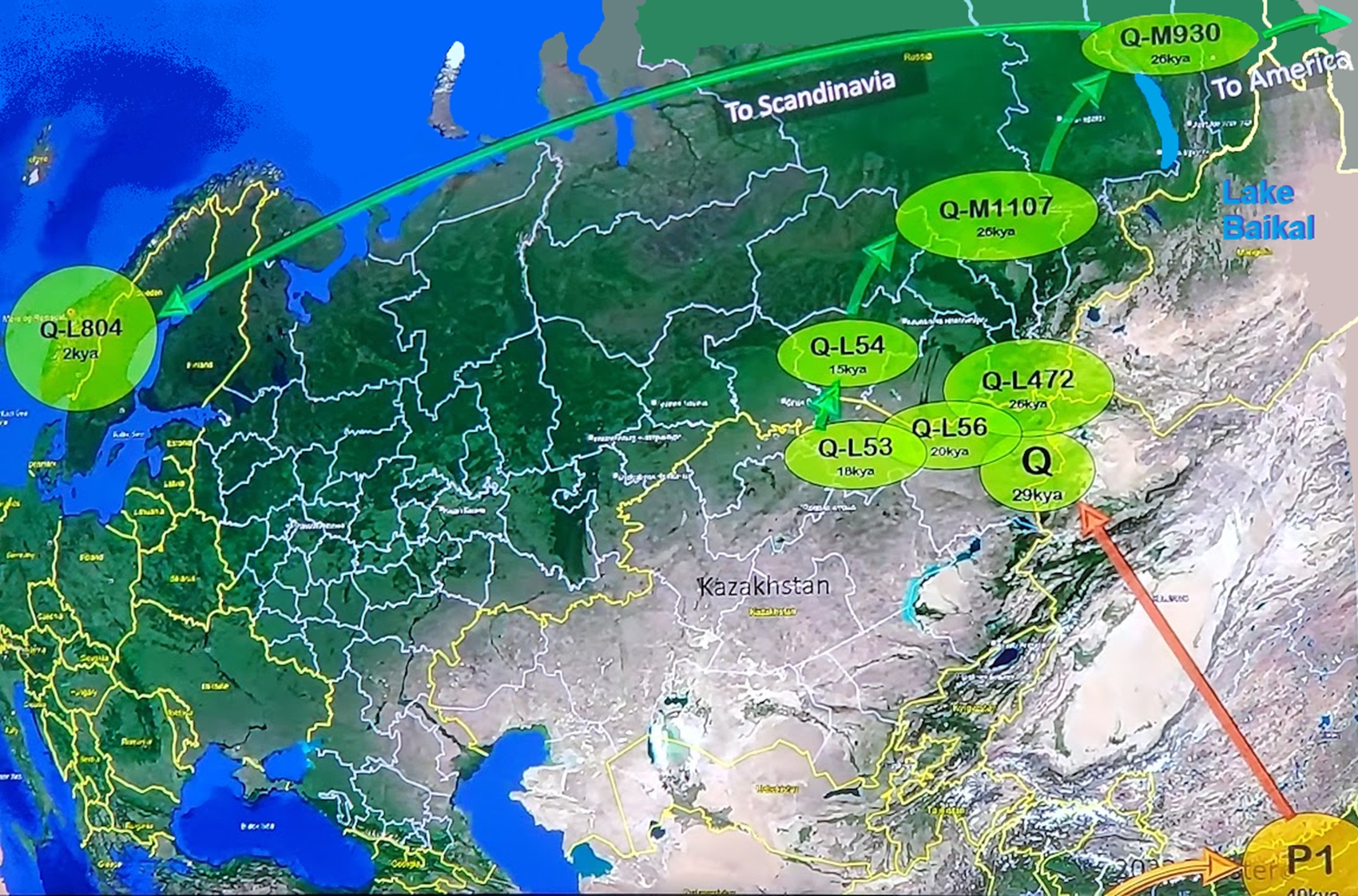

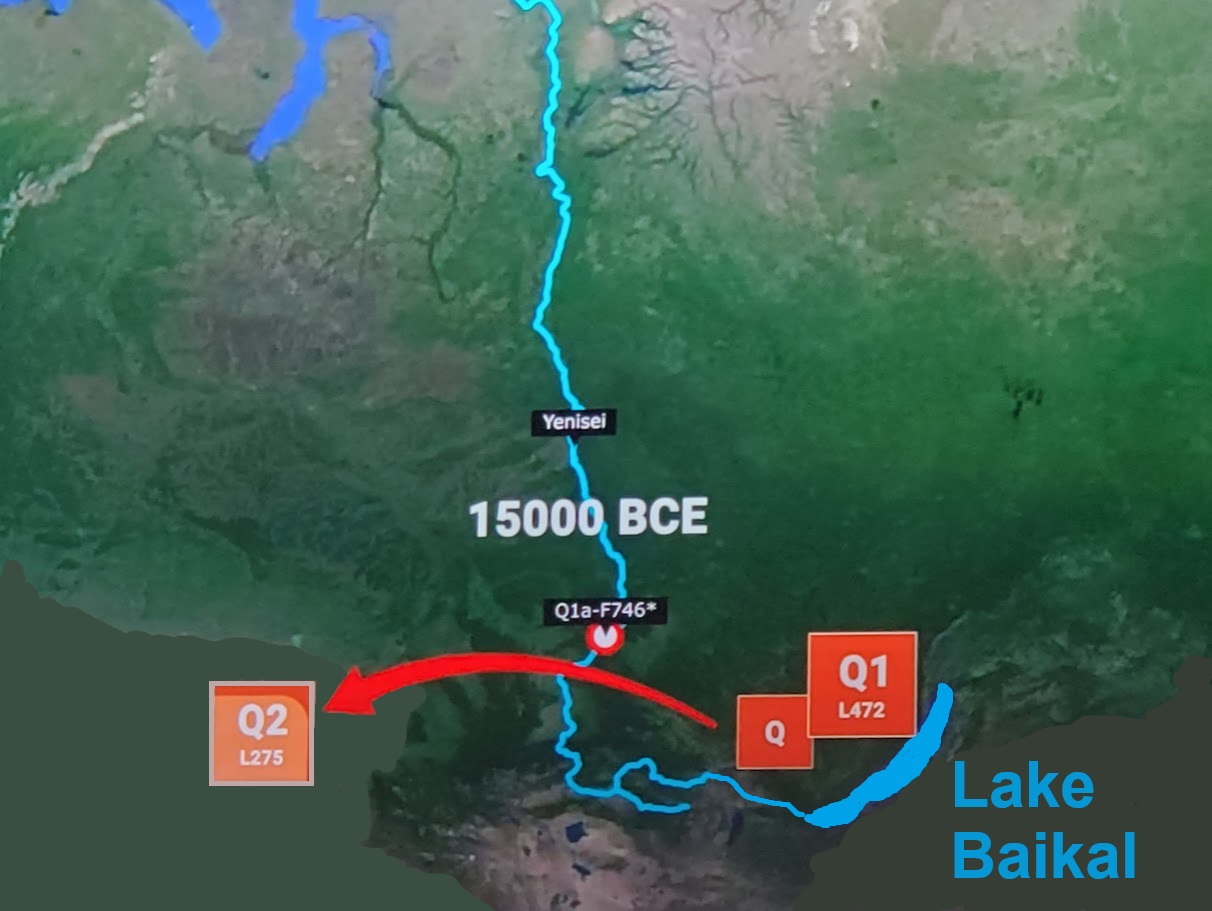
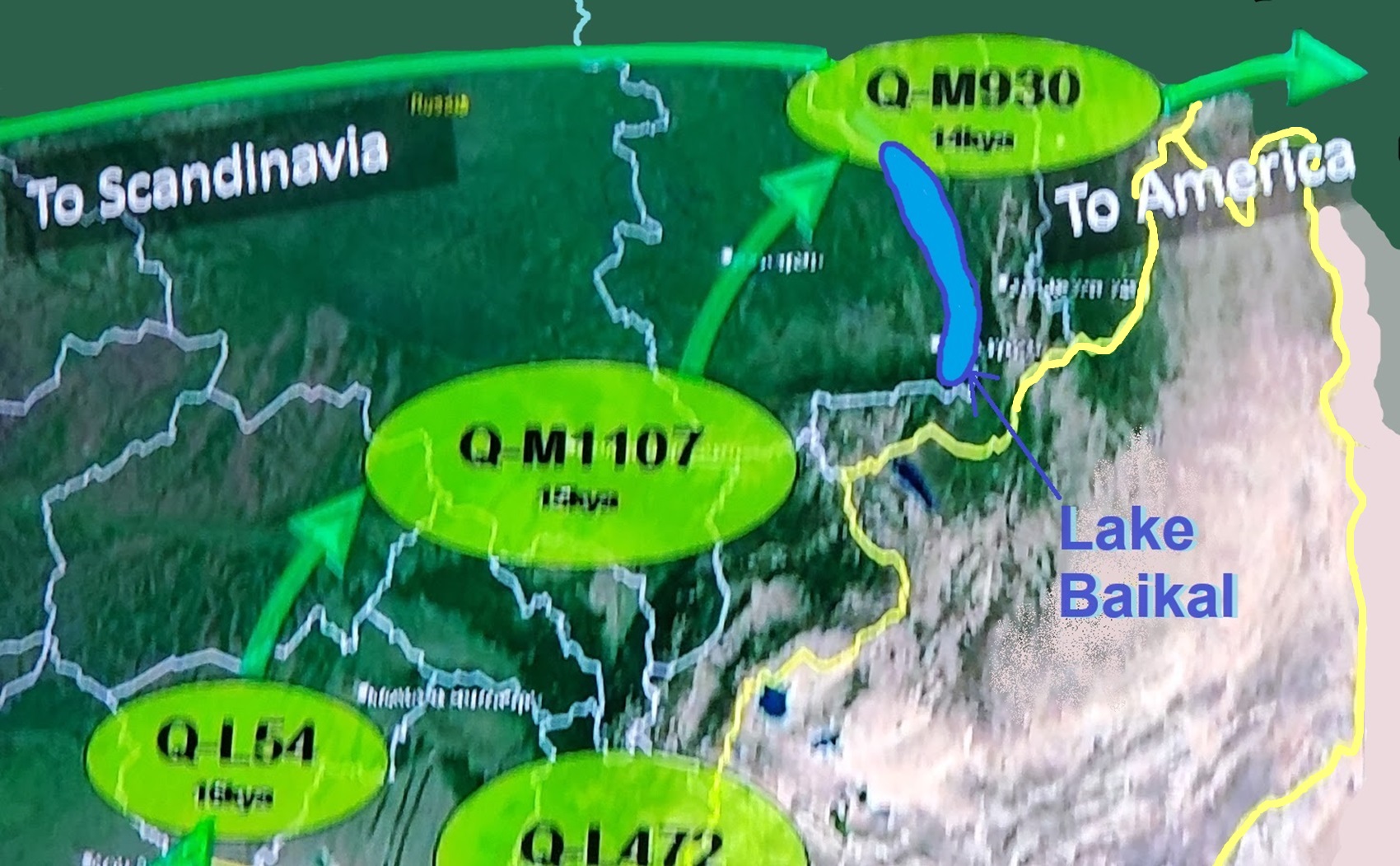
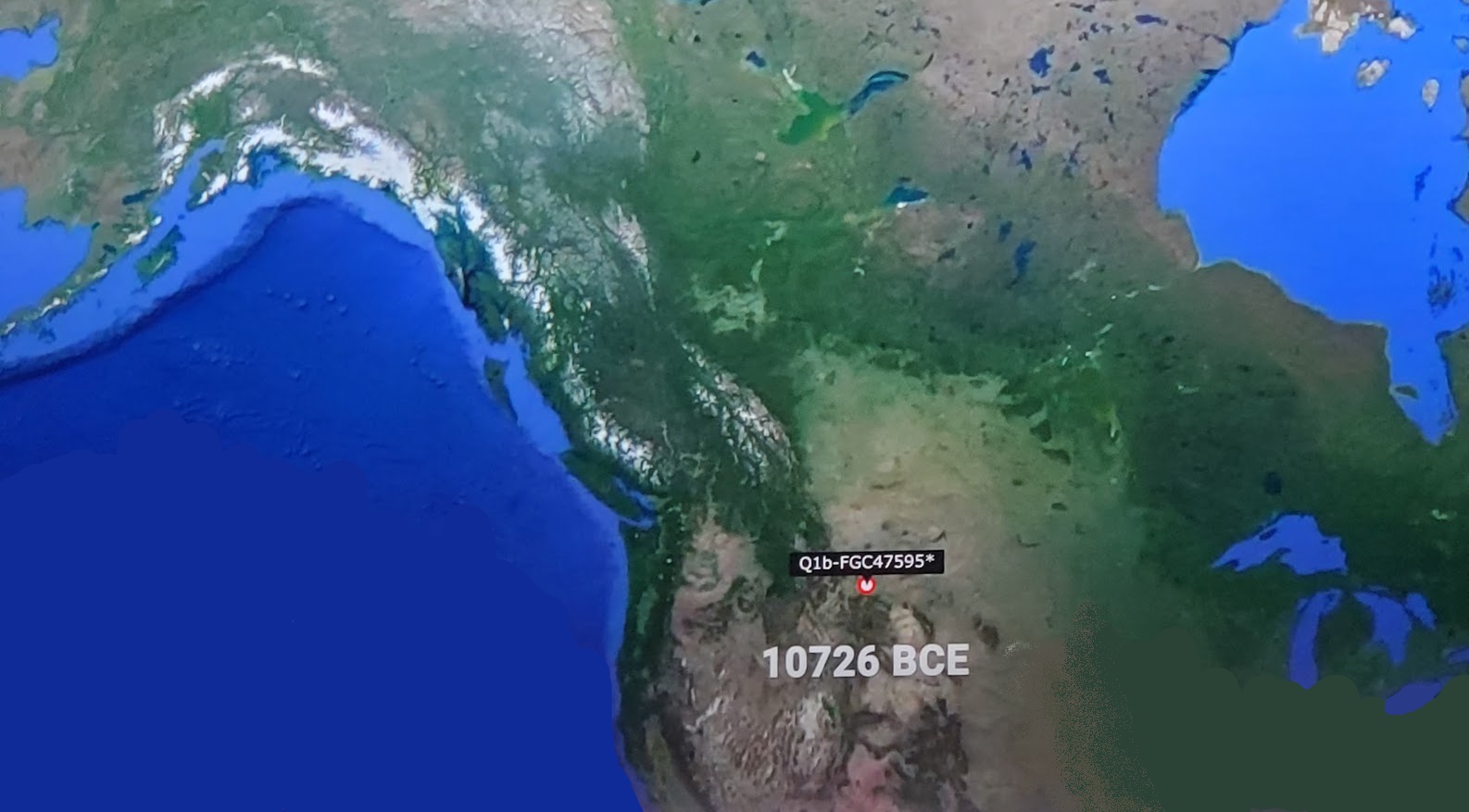

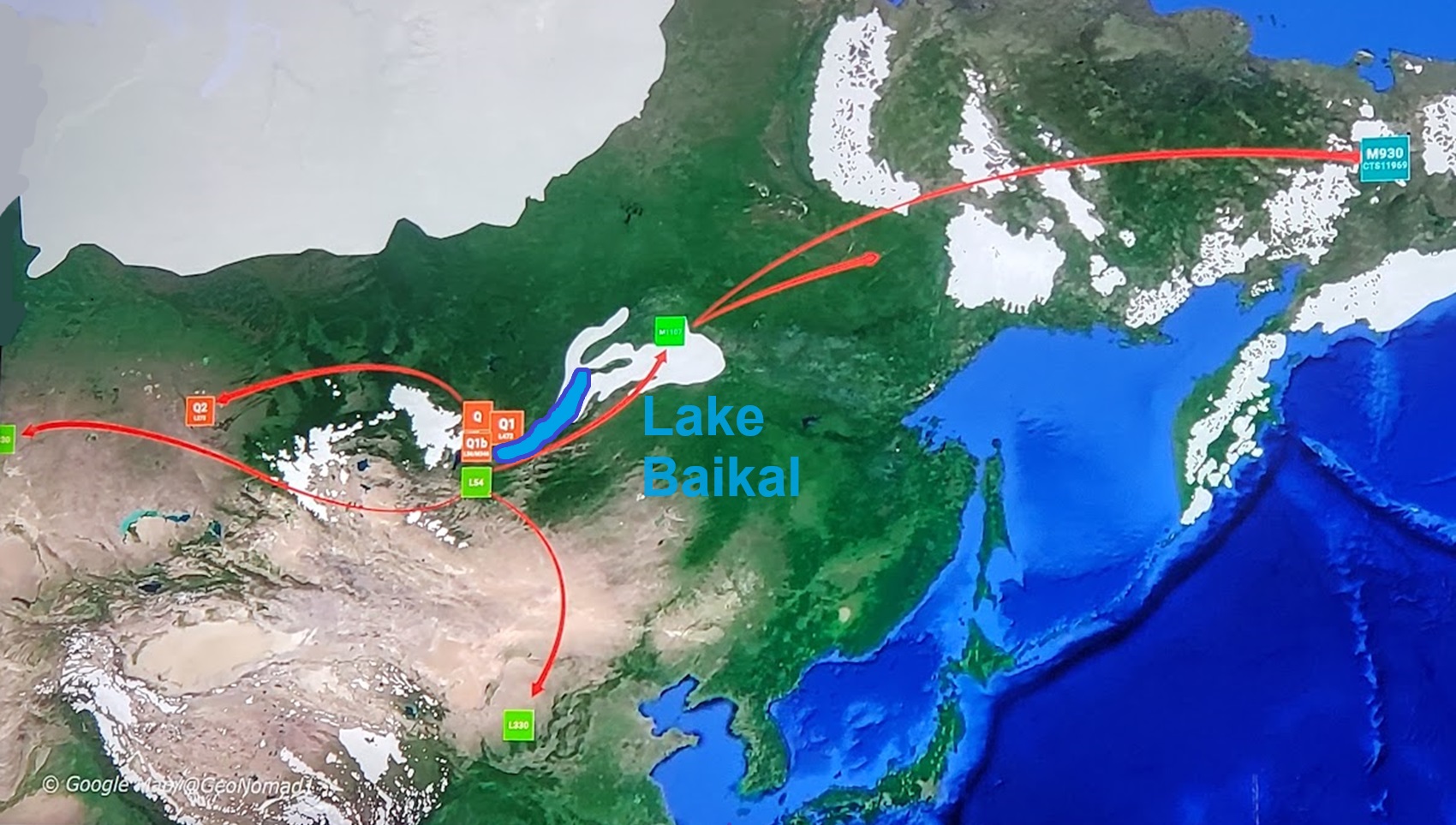

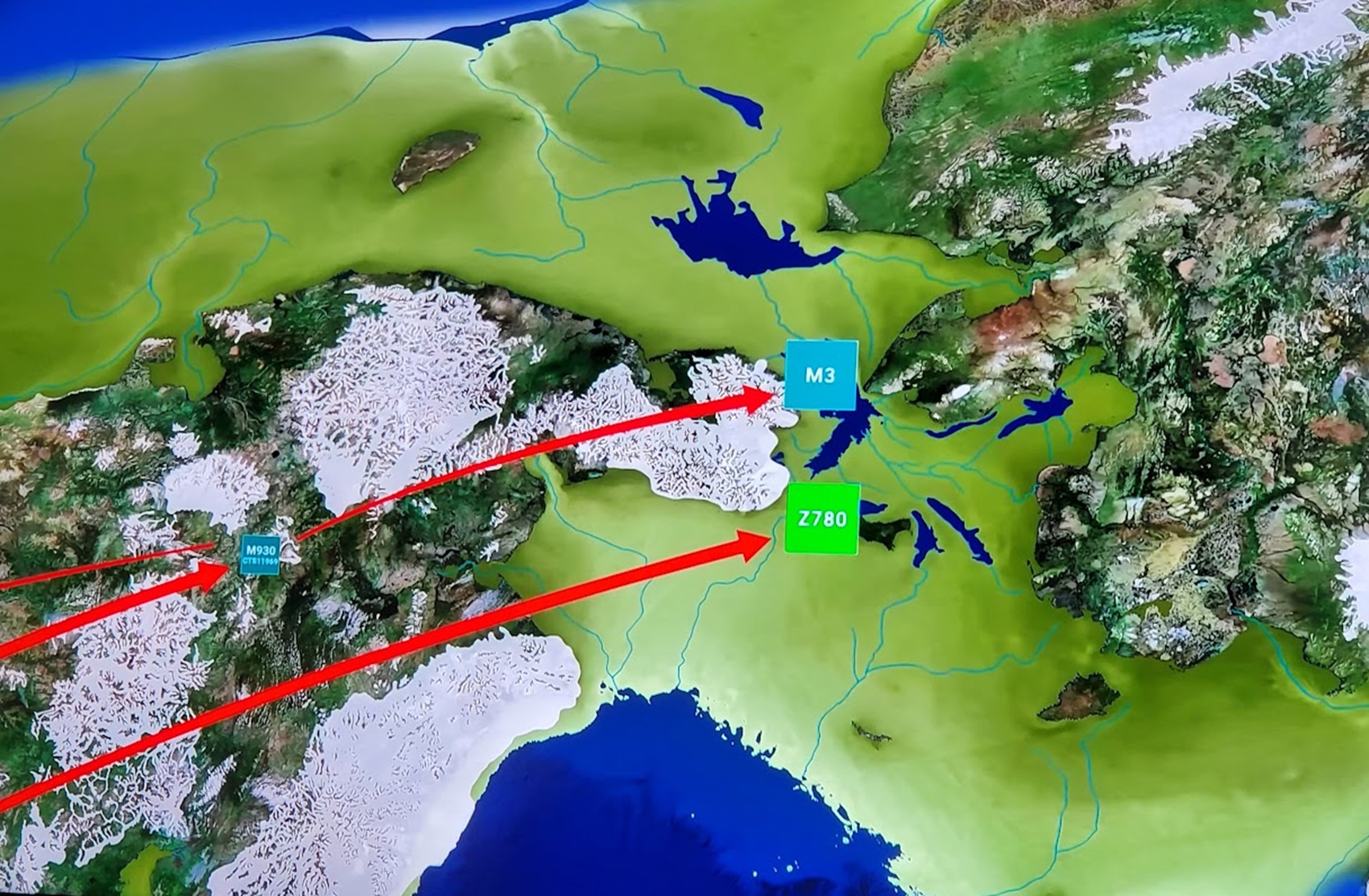
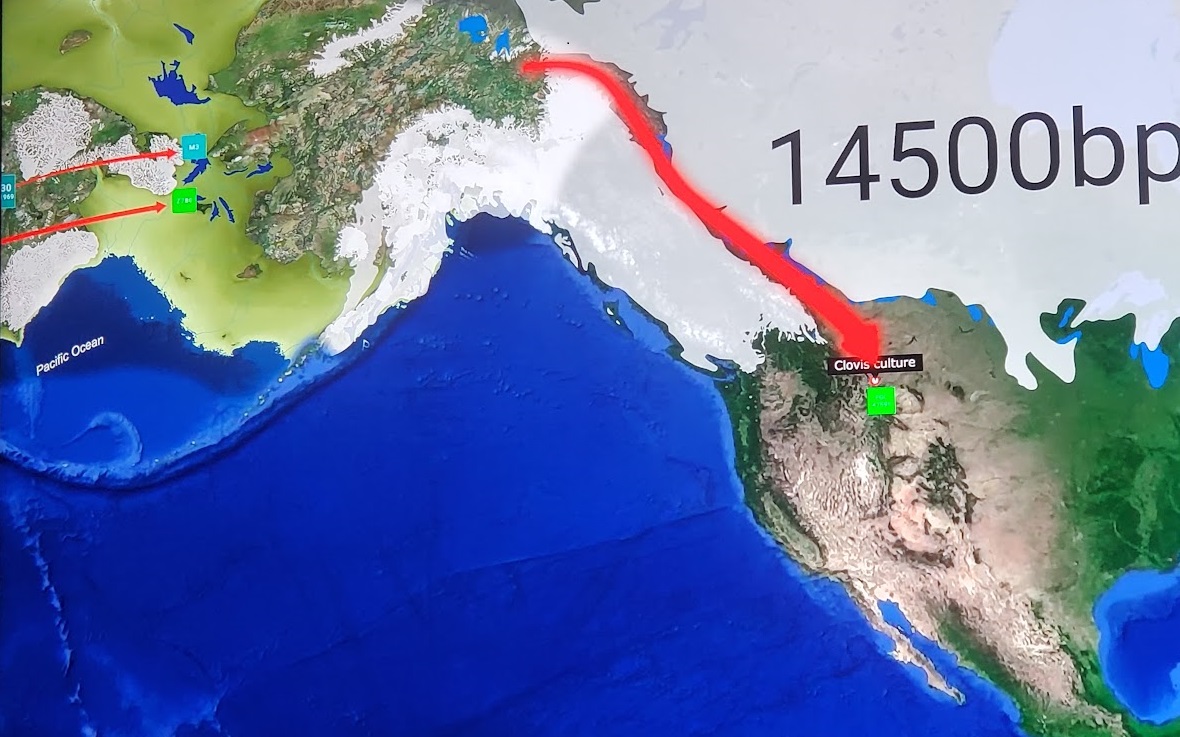

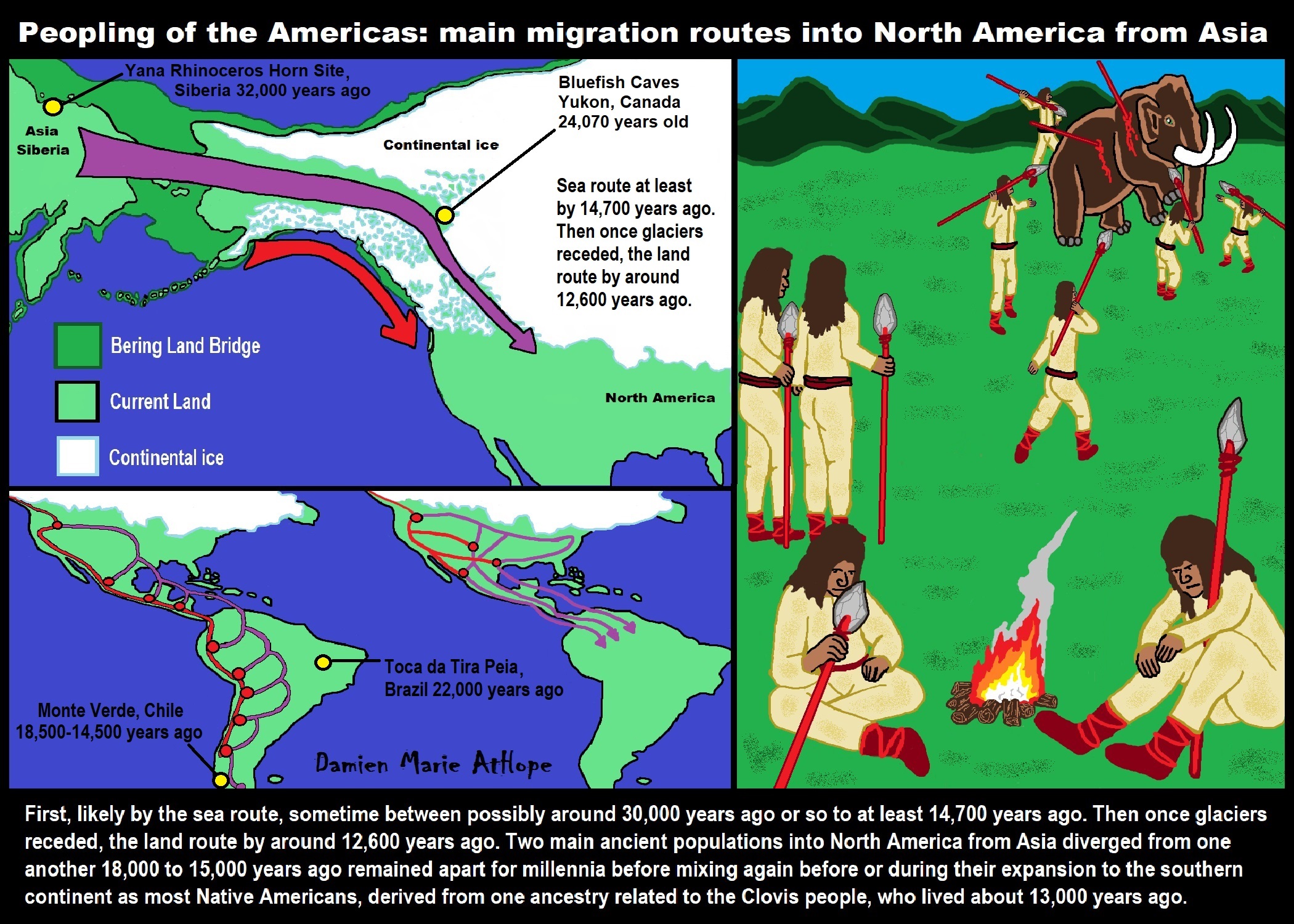

ref, ref, ref, ref, ref, ref, ref, ref, ref, ref, ref, ref, ref, ref, ref
“A 2016 study found that the global maximum of Ancient North Eurasian (ANE) ancestry occurs in modern-day Kets, Mansi, Native Americans, and Selkups. ANE ancestry has spread throughout Eurasia and the Americas in various migrations since the Upper Paleolithic, and more than half of the world’s population today derives between 5 and 42% of their genomes from the Ancient North Eurasians. Significant ANE ancestry can be found in Native Americans, as well as in regions of northern Europe, South Asia, Central Asia, and Siberia. It has been suggested that their mythology may have featured narratives shared by both Indo-European and some Native American cultures, such as the existence of a metaphysical world tree and a fable in which a dog guards the path to the afterlife.” ref
Ancient Northern East Asian/ later became Ancient Northeast Asian
Ancient Paleo-Siberian
Mal’ta–Buret’ culture (Mal’ta boy MA-1)
The Kolyma Shaitans: Legends and Reality (I only use just a small part)
“A unique “shaitan” burial was discovered on the bank of Omuk-Kuel Lake in the Middle-Kolyma ulus in Yakutia. According to the legends, buried in it are mummified remains of a shaman woman who died during a devastating smallpox epidemics in the 18th c. In an attempt to overcome the deadly disease, the shaman’s relatives used her remains as an emeget fetish. The author believes that these legends reflect the real events of those far-away years. The Arabic word “shaitan” came to the Russian language from Turkic languages. According to Islamic tradition, a shaitan is a genie, an evil spirit, a demon. During Russian colonization and Christianization of Siberia, all sacred things used by the aborigines as fetishes, patron spirits of the family, and the tribe, grew to be called “shaitans.” There are various facts, dating to the 18th and 19th cc., confirming that this word also referred to the mummified remains of outstanding shamans.” ref
“In the 1740s, a member of the Second Kamchatka Expedition Yakov Lindenau wrote, “Meat is scratched off the [shaman’s] bones and the bones are put together to form a skeleton, which is dressed in human’s clothes and worshipped as a deity. The Yukagirs place such dressed bones…in their yurts, their number can sometimes reach 10 or 15. If somebody commits even a minor sacrilege with respect to these bones, he stirs up rancor on the part of the Yukagirs… While traveling and hunting, the Yukagirs carry these bones in their sledges, and moreover, in their best sledges pulled by their best deer. When the Yukagirs are going to undertake something really important, they tell fortune using these skeletons: lift a skeleton up, and if it seems light, it means that their enterprise will have a favorable outcome. The Yukagirs call these skeletons stariks (old men), endow them with their best furs, and sit them on beds covered with deer hides, in a circle, as though they are alive.” (Lindenau, 1983, p. 155)” ref
“In the late 19th c., a famous explorer of aboriginal culture V. I. Jochelson noted the changes that occurred in the ritual in the last century and a half. So, the Yukagirs divided among themselves the shaman’s meat dried in the sun and then put it in separate tents. The dead bodies of killed dogs were left there as well. “After that,” V. I. Jochelson writes, “they would divide the shaman’s bones, dry them and wrap in clothes. The skull was an object of worshipping. It was put on top of a trunk (body) cut out of wood. A caftan and two hats – a winter and a summer one – were sewn for the idol. The caftan was all embroidered. On the skull, a special mask was put, with holes for the eyes and the mouth… The figure was placed in the front corner of the home. Before a meal, a piece of food was thrown into the fire and the idol was held above it. This feeding of the idol… was committed before each meal.” (V. I. Jochelson, 2005, pp. 236—237)” ref
“The idol was kept by the children of the dead shaman. One of them was inducted into the shamanism mysteries while his father was still alive. The idol was carried in a wooden box. Sometimes, in line with the air burial ritual, the box was erected on poles or trees, and the idol was taken out only before hunting or a long journey so that the outcome of the enterprise planned could be predicted. With time, the Yukagirs began using wooden idols as charms. V. I. Jochelson notes that by the late 19th c. the Yukagirs had developed a skeptical attitude towards idols and referred to them as “shaitans.” In this way, under the influence of Christianity, the worshipped ancestor’s spirit turned into its opposite – an evil spirit, a devil, a Satan.” ref
Ancestral Native American, Ancient Beringian
14,000-year-old Ust-Kyakhta-3 (UKY) individual found near Lake Baikal
Chertovy Vorota Cave/Devil’s Gate Cave
Bactria–Margiana Archaeological Complex
32,000-21,000 years ago Yana Culture, at the Yana Woolly Rhinoceros Horn Site in Siberia, with genetic proximity to Ancient North Eurasian populations (Mal’ta and Afontova Gora), but also Ust-Ishim, Sunghir, and to a lesser extent Tianyuan, as well as similarities with the Clovis culture

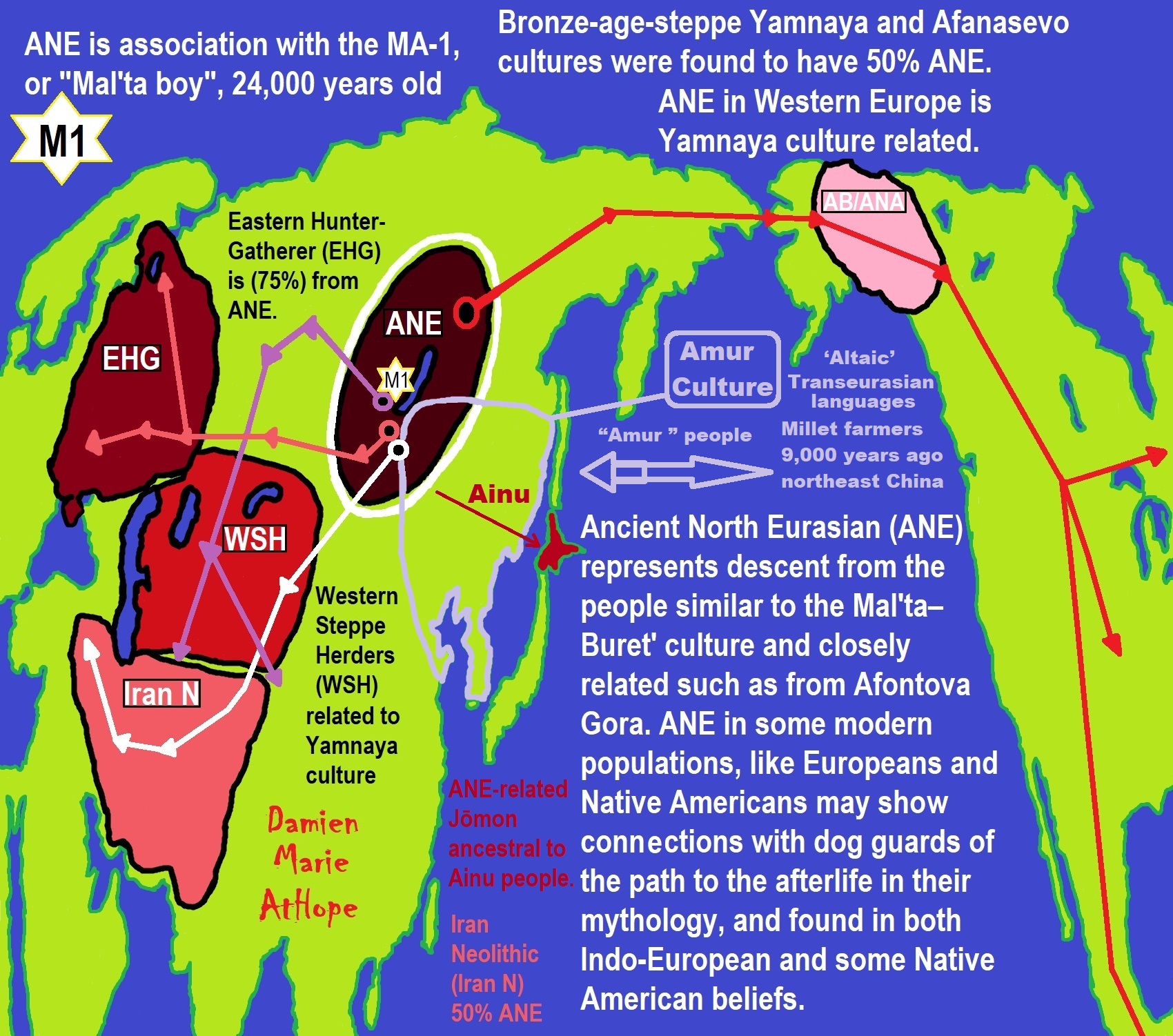
Groups partially derived from the Ancient North Eurasians
“The ANE lineage is defined by association with the MA-1, or “Mal’ta boy”, remains of 24,000 years ago in central Siberia Mal’ta-Buret’ culture 24,000-15,000 years ago. The Ancient North Eurasians (ANE) samples (Afontova Gora 3, Mal’ta 1, and Yana-RHS) show evidence for minor gene flow from an East Asian-related group (simplified by the Amis, Han, or Tianyuan) but no evidence for ANE-related geneflow into East Asians (Amis, Han, Tianyuan), except the Ainu, of North Japan.” ref
“The ANE lineage is defined by association with the MA-1, or “Mal’ta boy”, remains of 24,000 years ago in central Siberia Mal’ta-Buret’ culture 24,000-15,000 years ago “basal to modern-day Europeans”. Some Ancient North Eurasians also carried East Asian populations, such as Tianyuan Man.” ref
“Bronze-age-steppe Yamnaya and Afanasevo cultures were ANE at around 50% and Eastern Hunter-Gatherer (EHG) at around 75% ANE. Karelia culture: Y-DNA R1a-M417 8,400 years ago, Y-DNA J, 7,200 years ago, and Samara, of Y-haplogroup R1b-P297 7,600 years ago is closely related to ANE from Afontova Gora, 18,000 years ago around the time of blond hair first seen there.” ref
Ancient North Eurasian
“In archaeogenetics, the term Ancient North Eurasian (often abbreviated as ANE) is the name given to an ancestral West Eurasian component that represents descent from the people similar to the Mal’ta–Buret’ culture and populations closely related to them, such as from Afontova Gora and the Yana Rhinoceros Horn Site. Significant ANE ancestry are found in some modern populations, including Europeans and Native Americans.” ref
“The ANE lineage is defined by association with the MA-1, or “Mal’ta boy“, the remains of an individual who lived during the Last Glacial Maximum, 24,000 years ago in central Siberia, Ancient North Eurasians are described as a lineage “which is deeply related to Paleolithic/Mesolithic hunter-gatherers in Europe,” meaning that they diverged from Paleolithic Europeans a long time ago.” ref
“The ANE population has also been described as having been “basal to modern-day Europeans” but not especially related to East Asians, and is suggested to have perhaps originated in Europe or Western Asia or the Eurasian Steppe of Central Asia. However, some samples associated with Ancient North Eurasians also carried ancestry from an ancient East Asian population, such as Tianyuan Man. Sikora et al. (2019) found that the Yana RHS sample (31,600 BP) in Northern Siberia “can be modeled as early West Eurasian with an approximately 22% contribution from early East Asians.” ref
“Populations genetically similar to MA-1 were an important genetic contributor to Native Americans, Europeans, Central Asians, South Asians, and some East Asian groups, in order of significance. Lazaridis et al. (2016:10) note “a cline of ANE ancestry across the east-west extent of Eurasia.” The ancient Bronze-age-steppe Yamnaya and Afanasevo cultures were found to have a noteworthy ANE component at ~50%.” ref
“According to Moreno-Mayar et al. 2018 between 14% and 38% of Native American ancestry may originate from gene flow from the Mal’ta–Buret’ people (ANE). This difference is caused by the penetration of posterior Siberian migrations into the Americas, with the lowest percentages of ANE ancestry found in Eskimos and Alaskan Natives, as these groups are the result of migrations into the Americas roughly 5,000 years ago.” ref
“Estimates for ANE ancestry among first wave Native Americans show higher percentages, such as 42% for those belonging to the Andean region in South America. The other gene flow in Native Americans (the remainder of their ancestry) was of East Asian origin. Gene sequencing of another south-central Siberian people (Afontova Gora-2) dating to approximately 17,000 years ago, revealed similar autosomal genetic signatures to that of Mal’ta boy-1, suggesting that the region was continuously occupied by humans throughout the Last Glacial Maximum.” ref
“The earliest known individual with a genetic mutation associated with blonde hair in modern Europeans is an Ancient North Eurasian female dating to around 16000 BCE from the Afontova Gora 3 site in Siberia. It has been suggested that their mythology may have included a narrative, found in both Indo-European and some Native American fables, in which a dog guards the path to the afterlife.” ref
“Genomic studies also indicate that the ANE component was introduced to Western Europe by people related to the Yamnaya culture, long after the Paleolithic. It is reported in modern-day Europeans (7%–25%), but not of Europeans before the Bronze Age. Additional ANE ancestry is found in European populations through paleolithic interactions with Eastern Hunter-Gatherers, which resulted in populations such as Scandinavian Hunter-Gatherers.” ref
“The Ancient North Eurasians (ANE) split from the ancestors of European peoples somewhere in the Middle East or South-central Asia, and used a northern dispersal route through Central Asia into Northern Asia and Siberia. Genetic analyses show that all ANE samples (Afontova Gora 3, Mal’ta 1, and Yana-RHS) show evidence for minor gene flow from an East Asian-related group (simplified by the Amis, Han, or Tianyuan). In contrast, no evidence for ANE-related geneflow into East Asians (Amis, Han, Tianyuan), except the Ainu, was found.” ref
“Genetic data suggests that the ANE formed during the Terminal Upper-Paleolithic (36+-1,5ka) period from a deeply European-related population, which was once widespread in Northern Eurasia, and from an early East Asian-related group, which migrated northwards into Central Asia and Siberia, merging with this deeply European-related population. These population dynamics and constant northwards geneflow of East Asian-related ancestry would later gave rise to the “Ancestral Native Americans” and Paleosiberians, which replaced the ANE as dominant population of Siberia.” ref
Groups partially derived from the Ancient North Eurasians
“Eastern Hunter-Gatherer (EHG) is a lineage derived predominantly (75%) from ANE. It is represented by two individuals from Karelia, one of Y-haplogroup R1a-M417, dated c. 8.4 kya, the other of Y-haplogroup J, dated c. 7.2 kya; and one individual from Samara, of Y-haplogroup R1b-P297, dated c. 7.6 kya. This lineage is closely related to the ANE sample from Afontova Gora, dated c. 18 kya. After the end of the Last Glacial Maximum, the Western Hunter-Gatherers (WHG) and EHG lineages merged in Eastern Europe, accounting for early presence of ANE-derived ancestry in Mesolithic Europe. Evidence suggests that as Ancient North Eurasians migrated West from Eastern Siberia, they absorbed Western Hunter-Gatherers and other West Eurasian populations as well.” ref
“Caucasian Hunter-Gatherer (CHG) is represented by the Satsurblia individual dated ~13 kya (from the Satsurblia cave in Georgia), and carried 36% ANE-derived admixture. While the rest of their ancestry is derived from the Dzudzuana cave individual dated ~26 kya, which lacked ANE-admixture, Dzudzuana affinity in the Caucasus decreased with the arrival of ANE at ~13 kya Satsurblia.” ref
“Scandinavian Hunter-Gatherer (SHG) is represented by several individuals buried at Motala, Sweden ca. 6000 BC. They were descended from Western Hunter-Gatherers who initially settled Scandinavia from the south, and later populations of EHG who entered Scandinavia from the north through the coast of Norway.” ref
“Iran Neolithic (Iran_N) individuals dated ~8.5 kya carried 50% ANE-derived admixture and 50% Dzudzuana-related admixture, marking them as different from other Near-Eastern and Anatolian Neolithics who didn’t have ANE admixture. Iran Neolithics were later replaced by Iran Chalcolithics, who were a mixture of Iran Neolithic and Near Eastern Levant Neolithic.” ref
“Ancient Beringian/Ancestral Native American are specific archaeogenetic lineages, based on the genome of an infant found at the Upward Sun River site (dubbed USR1), dated to 11,500 years ago. The AB lineage diverged from the Ancestral Native American (ANA) lineage about 20,000 years ago.” ref
“West Siberian Hunter-Gatherer (WSHG) are a specific archaeogenetic lineage, first reported in a genetic study published in Science in September 2019. WSGs were found to be of about 30% EHG ancestry, 50% ANE ancestry, and 20% to 38% East Asian ancestry.” ref
“Western Steppe Herders (WSH) is the name given to a distinct ancestral component that represents descent closely related to the Yamnaya culture of the Pontic–Caspian steppe. This ancestry is often referred to as Yamnaya ancestry or Steppe ancestry.” ref
“Late Upper Paeolithic Lake Baikal – Ust’Kyakhta-3 (UKY) 14,050-13,770 BP were mixture of 30% ANE ancestry and 70% East Asian ancestry.” ref
“Lake Baikal Holocene – Baikal Eneolithic (Baikal_EN) and Baikal Early Bronze Age (Baikal_EBA) derived 6.4% to 20.1% ancestry from ANE, while rest of their ancestry was derived from East Asians. Fofonovo_EN near by Lake Baikal were mixture of 12-17% ANE ancestry and 83-87% East Asian ancestry.” ref
“Hokkaido Jōmon people specifically refers to the Jōmon period population of Hokkaido in northernmost Japan. Though the Jōmon people themselves descended mainly from East Asian lineages, one study found an affinity between Hokkaido Jōmon with the Northern Eurasian Yana sample (an ANE-related group, related to Mal’ta), and suggest as an explanation the possibility of minor Yana gene flow into the Hokkaido Jōmon population (as well as other possibilities). A more recent study by Cooke et al. 2021, confirmed ANE-related geneflow among the Jōmon people, partially ancestral to the Ainu people. ANE ancestry among Jōmon people is estimated at 21%, however, there is a North to South cline within the Japanese archipelago, with the highest amount of ANE ancestry in Hokkaido and Tohoku.” ref
Here are the Human Migrations from Asia into Alaska (North America)
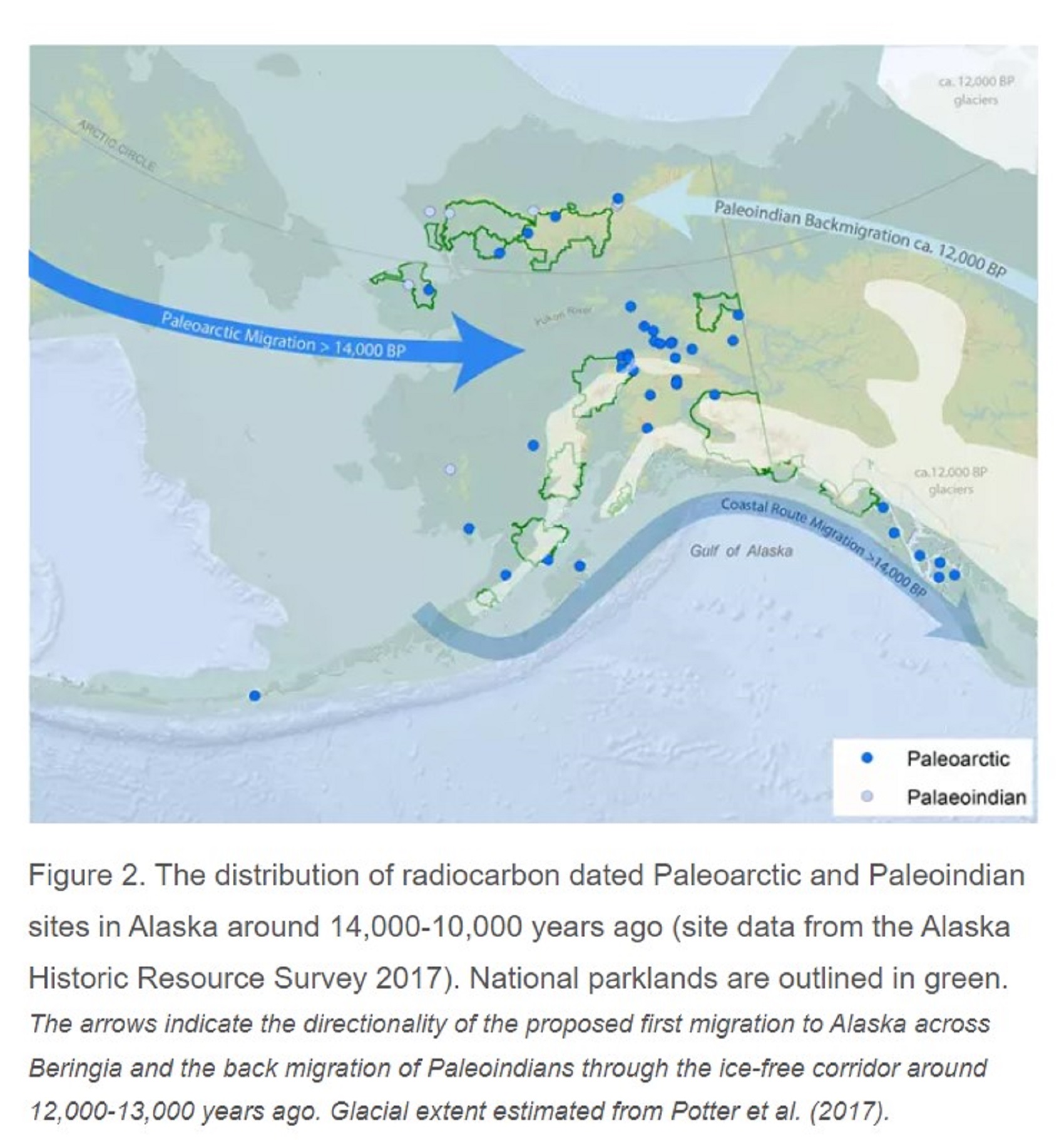
Human Migration from Asia into Alaska (North America) (14,000 to 10,000 years ago)
“likely relates to the Ancient North Eurasians described as an R DNA lineage”
Lithic stage: before 8500 BCE
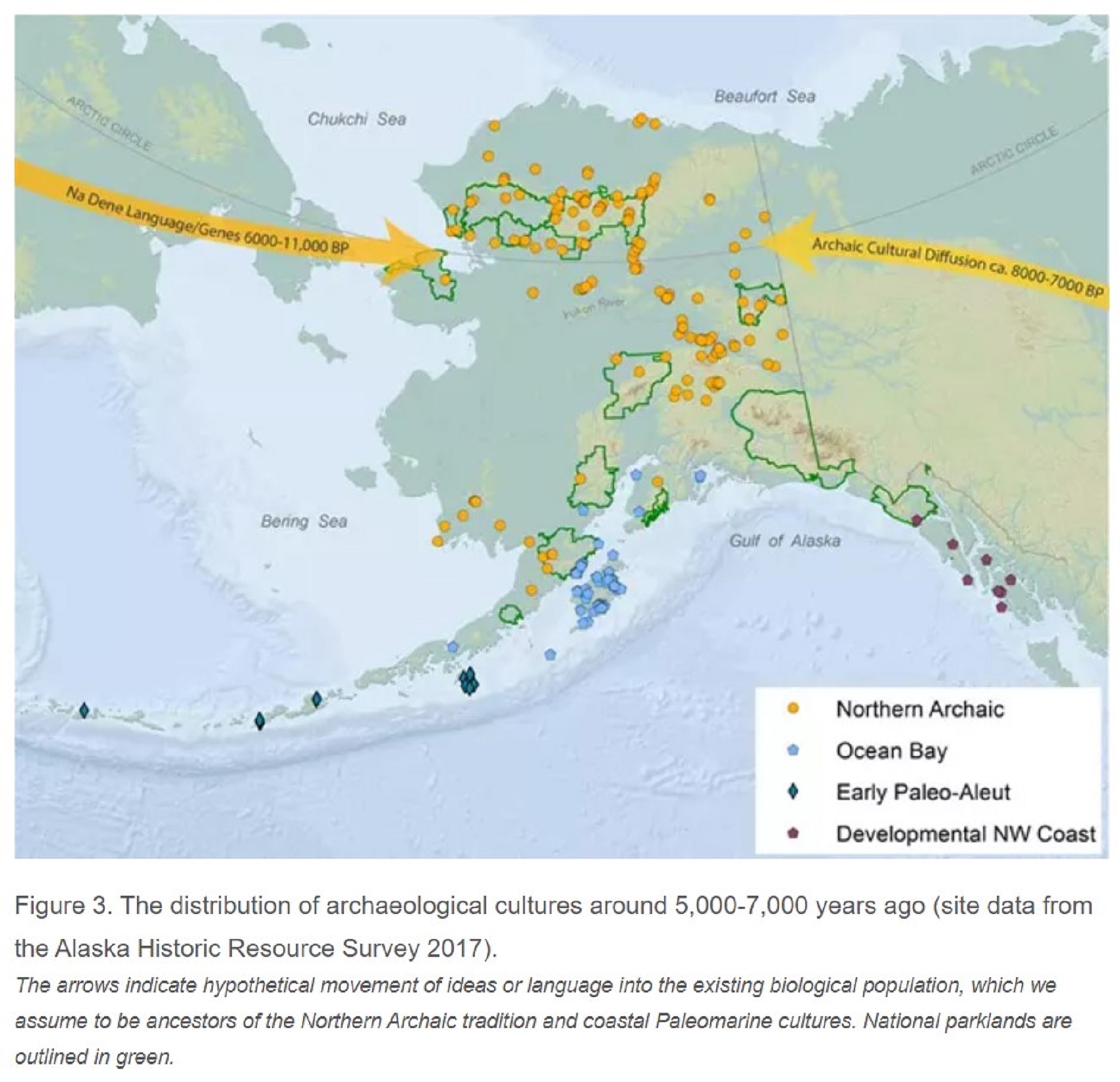
Human Migration from Asia into Alaska (North America) (11,000 to 6,000 years ago)
“likely relates to the Na-Dene languages described as C-M217/C2/C3/C-M130 DNA lineage”
Archaic period: 8000 BC– 1000 BCE
This C-M217/C2/C3/C-M130 DNA lineage is also in the Mound Builders (some of which are pyramid-like) such as the Adena (800 BCE–100 CE), Hopewell (200 BCE–500 CE), and the Maya civilization with pyramids.
Mound Builders
“A number of pre-Columbian cultures are collectively termed “Mound Builders“. The term does not refer to a specific people or archaeological culture, but refers to the characteristic mound earthworks erected for an extended period of more than 5,000 years. The “Mound Builder” cultures span the period of roughly 3500 BCE (the construction of Watson Brake) to the 16th century CE, including the Archaic period, Woodland period (Calusa culture, Adena and Hopewell cultures), and Mississippian period. Geographically, the cultures were present in the region of the Great Lakes, the Ohio River Valley, and the Mississippi River valley and its tributary waters.” ref
“The first mound building was an early marker of political and social complexity among the cultures in the Eastern United States. Watson Brake in Louisiana, constructed about 3500 BCE during the Middle Archaic period, is currently the oldest known and dated mound complex in North America. It is one of 11 mound complexes from this period found in the Lower Mississippi Valley. These cultures generally had developed hierarchical societies that had an elite. These commanded hundreds or even thousands of workers to dig up tons of earth with the hand tools available, move the soil long distances, and finally, workers to create the shape with layers of soil as directed by the builders.” ref
“From about 800 CE, the mound building cultures were dominated by the Mississippian culture, a large archaeological horizon, whose youngest descendants, the Plaquemine culture and the Fort Ancient culture, were still active at the time of European contact in the 16th century. One tribe of the Fort Ancient culture has been identified as the Mosopelea, presumably of southeast Ohio, who were speakers of an Ohio Valley Siouan language. The bearers of the Plaquemine culture were presumably speakers of the Natchez language isolate. The first description of these cultures is due to Spanish explorer Hernando de Soto, written between 1540 and 1542.” ref



Pic ref
Ancient Women Found in a Russian Cave Turn Out to Be Closely Related to The Modern Population https://www.sciencealert.com/ancient-women-found-in-a-russian-cave-turn-out-to-be-closely-related-to-the-modern-population
Abstract
“Ancient genomes have revolutionized our understanding of Holocene prehistory and, particularly, the Neolithic transition in western Eurasia. In contrast, East Asia has so far received little attention, despite representing a core region at which the Neolithic transition took place independently ~3 millennia after its onset in the Near East. We report genome-wide data from two hunter-gatherers from Devil’s Gate, an early Neolithic cave site (dated to ~7.7 thousand years ago) located in East Asia, on the border between Russia and Korea. Both of these individuals are genetically most similar to geographically close modern populations from the Amur Basin, all speaking Tungusic languages, and, in particular, to the Ulchi. The similarity to nearby modern populations and the low levels of additional genetic material in the Ulchi imply a high level of genetic continuity in this region during the Holocene, a pattern that markedly contrasts with that reported for Europe.” ref
“Six of seven individuals whose remains have been recovered from the cave have been DNA tested. Originally, three of the specimens were thought to be adult males, two were thought to be adult females, one was thought to be a sub-adult of about 12-13 years of age, and one was thought to be a juvenile of about 6-7 years of age based on the skeletal morphology of the remains. Results of genetic analysis of the sub-adult individual have not yet been published. However, two specimens, NEO236 (Skull B, DevilsGate2) and NEO235 (Skull G), who had been presumed to be adult males according to a forensic morphological assessment of their remains, were discovered through genetic analysis to actually be females. The juvenile specimen also has been determined to be female through genetic analysis. Three of the specimens (including the only adult male plus NEO235/Skull G and another adult female, labeled as Skull Е, DevilsGate1, or NEO240, who has been genetically determined to be a first-degree relative of NEO235/Skull G) have been assigned to mtDNA haplogroup D4m; a previous genetic analysis of one of these adult female specimens determined her mtDNA haplogroup to be D4. Another three specimens (including the juvenile female, the DevilsGate2 specimen, and another adult female; both the juvenile female and the DevilsGate2 specimen have been determined to be first-degree relatives of the other adult female, and the juvenile female and the DevilsGate2 specimen also have been determined to be second-degree relatives of each other) have been assigned to haplogroup D4; a previous genetic analysis of the DevilsGate2 specimen determined her mtDNA haplogroup to be M. The only specimen from the cave who has been confirmed to be male through genetic analysis has been assigned to Y-DNAhaplogroup C2b-F6273/Y6704/Y6708, equivalent to C2b-L1373, the northern (Central Asian, Siberian, and indigenous American) branch of haplogroup C2-M217.” ref
“The haplogroup C-M217 is now found at high frequencies among Central Asian peoples, indigenous Siberians, and some Native peoples of North America. Haplogroup C-M217 is the modal haplogroup among Mongolians and most indigenous populations of the Russian Far East, such as the Buryats, Northern Tungusic peoples, Nivkhs, Koryaks, and Itelmens. The subclade C-P39 is common among males of the indigenous North American peoples whose languages belong to the Na-Dené phylum. C2b1a1a P39 Canada,USA(Found in several indigenous peoples of North America, including some Na-Dené-,Algonquian-, orSiouan-speaking populations).” ref
“Males carrying C-M130 are believed to have migrated to the Americas some 6,000-8,000 years ago, and was carried by Na-Dené-speaking peoples into the northwest Pacific coast of North America. The distribution of Haplogroup C-M130 is generally limited to populations of Siberia, parts of East Asia, Oceania, and the Americas. Haplogroup C2 (M217) – the most numerous and widely dispersed C lineage – was once believed to have originated in Central Asia, spread from there into Northern Asia and the Americas while other theory it originated from East Asia. C-M217 stretches longitudinally from Central Europe and Turkey, to the Wayuu people of Colombia and Venezuela, and latitudinally from the Athabaskan peoples of Alaska to Vietnam to the Malay Archipelago. The highest frequencies of Haplogroup C-M217 are found among the populations of Mongolia and Far East Russia, where it is the modal haplogroup. Haplogroup C-M217 is the only variety of Haplogroup C-M130 to be found among Native Americans, among whom it reaches its highest frequency in Na-Dené populations.” ref
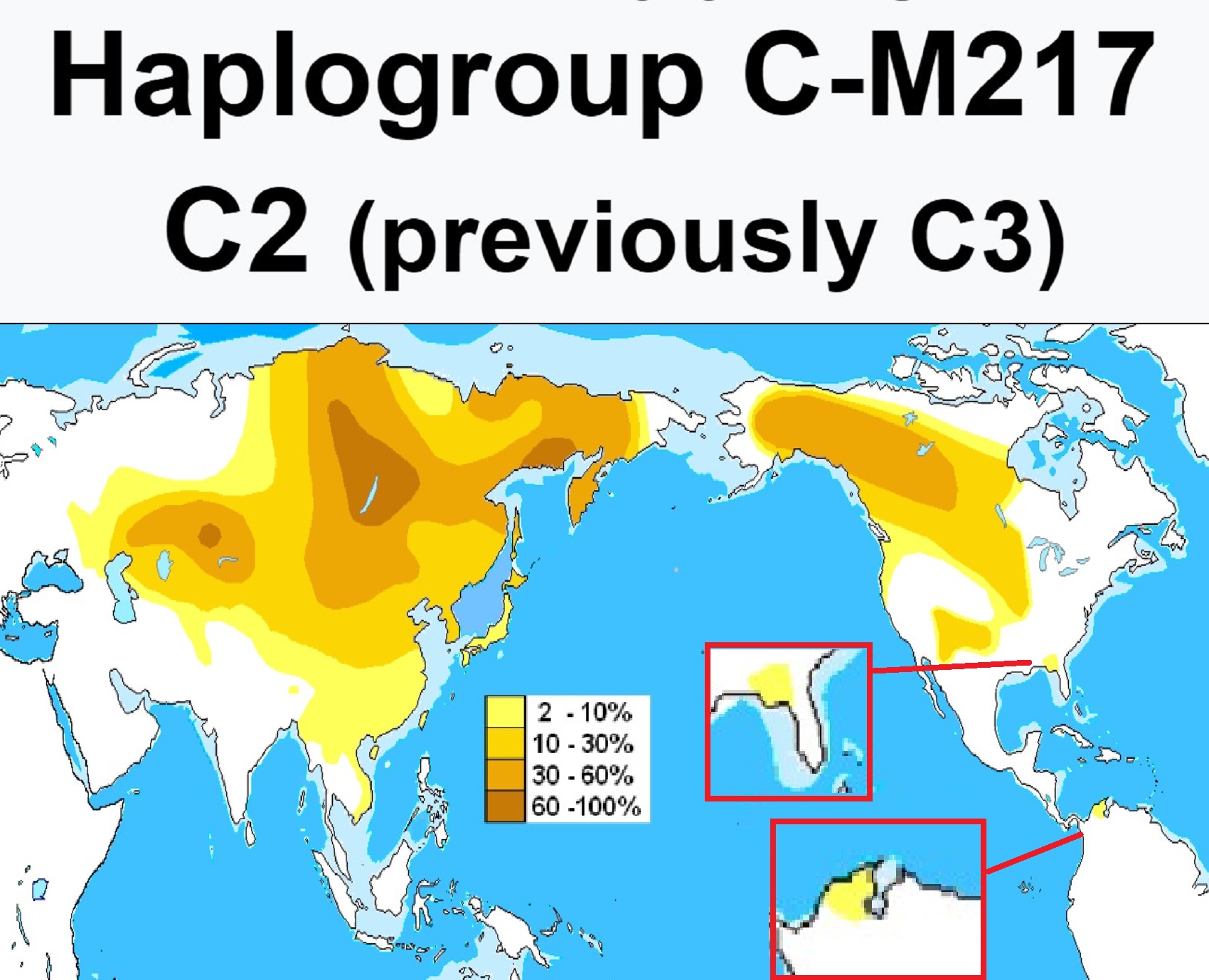
“Y DNA projects for C-M217 here, C-P39 here, and the main C project here. Please note that on the latest version of the ISOGG tree, M217, P44, and Z1453 are now listed as C2, not C3. In the Messavilla study (1962), fourteen individuals from the Kichwa and Waorani populations of South America were discovered to carry haplogroup C3* (M217). Most of the individuals within these populations carry variants of expected haplogroup Q, with the balance of 26% of the Kichwa samples and 7.5% of the Waorani samples carrying C3* (M217). MRCA estimates between the groups are estimated to be between 5.0-6.2 years ago, or years before the present.” ref
In the paper, the authors state that:
“We set out to test whether or not the haplogroup C3* (M217) Y chromosomes found at a mean frequency of 17% in two Ecuadorian populations could have been introduced by migration from East Asia, where this haplogroup is common. We considered recent admixture in the last few generations and, based on an archaeological link between the middle Jōmon culture in Japan and the Valdivia culture in Ecuador, a specific example of ancient admixture between Japan and Ecuador 6 Kya. In a paper, written by Estrada et all, titled “Possible Transpacific Contact on the Cost of Ecuador”, Estrada states that the earliest pottery-producing culture on the coast of Ecuador, the Valdivia culture, shows many striking similarities in decoration and vessel shape to the pottery of eastern Asia. In Japan, resemblances are closest to the Middle Jomon period. Both early Valdivia and Middle Jomon are dated between 2000 and 3000 BCE. A transpacific contact from Asia to Ecuador during this time is postulated.” ref
The conclusions from the 1962 paper states that:
Three different hypotheses to explain the presence of C3* Y chromosomes in Ecuador but not elsewhere in the Americas were tested: recent admixture, ancient admixture ∼6 Kya, or entry as a founder haplogroup 15–20 Kya with subsequent loss by drift elsewhere. We can convincingly exclude the recent admixture model, and find no support for the ancient admixture scenario, although cannot completely exclude it. Overall, our analyses support the hypothesis that C3* (M217) Y chromosomes were present in the “First American” ancestral population, and have been lost by drift from most modern populations except the Ecuadorians.
At the time not having the understanding of C-M217 (C3*) as we have now, the 1962 paper stated that:
“Other than one C3* individual in Alaska, C3* is unknown in the rest of the Native world including all of North American and the balance of Central and South America, but is common and widespread in East Asia.” ref
Some not all Mayan DNA shows C haplogroup. Genetic Overview of the Maya Populations: Mitochondrial DNA Haplogroups ref
Haplogroup C-M217, also known as C2 (and previously as C3), is a Y-chromosome DNA haplogroup.
“131 relations: Abazins, Adygea, African admixture in Europe, Ainu people, Aisin Gioro, Algonquian languages, Altai people, Anhui, Apache, Armenians, Bai people, Bangladesh, Beijing, Bhutan, Burusho people, Buryatia, Buryats, Cambodia, Central Asia, Chams, Chechnya, Cheyenne, China, Chukchi people, Crimean Tatars, Dai people, Daur people, Descent from Genghis Khan, Dungan people, East Asia, Evenks, Evens, Fujian, Gansu, Garo Hills, Garo people, Genetic genealogy, Genographic Project, Guangxi, Hamnigan, Han Chinese, Hani people, Haplogroup, Haplogroup C-M130, Haplogroup C-M217, Haplogroup C-M48, Haplogroup C-M8, Haplogroup CF (Y-DNA), Haplogroup CT, Haplotype, Hazaras, Hui people, Human Y-chromosome DNA haplogroup, Indigenous peoples of Siberia, Indigenous peoples of the Americas, Itelmens, Japanese people, Java, Jilin, Jishou, Kalmyks, Karakalpaks, Kazakhs, Khasic languages, Korea, Koreans, Koryaks, Kyrgyz people, Language family, List of Y-chromosome haplogroups in populations of the world, Lu people, Lyngngam language, Manchu people, Maritime Southeast Asia, Meghalaya, Miao people, Molecular phylogenetics, Mongols, Muong people, Na-Dene languages, Nanai people, National Geographic, Nepal, Nivkh people, Nogais, Northern Thai people, Northern Thailand, Oirats, Oroqen people, Outer Mongolia, Pakistan, Paragroup, Pashtuns, Patrilineality, Saga Prefecture, Shandong, Shanxi, She people, Sibe people, Siouan languages, Sioux, Southeast Asia, Soyot, Subclade, Tabasaran people, Taiwanese indigenous peoples, Tajiks, Tanana Athabaskans, Teleuts, Thailand, Tibetan people, Tibeto-Burman languages, Tujia people, Tungusic peoples, Turkic peoples, Tuvans, Udege people, Uyghurs, Uzbeks, Vietnam, Vietnamese people, Wayuu people, Xi’an, Y-DNA haplogroups by ethnic group, Y-DNA haplogroups in populations of East and Southeast Asia, Y-DNA haplogroups in populations of Oceania, Yakuts, Yao people, Yukaghir people, Yunnan, 1000 Genomes Project.” ref
“Several studies of the peopling of the Americas have made use of Native American variants. South American C-M217 (or C3), 17 which is defined by marker M21721 and is derived from haplogroup C, which is in turn defined by markers M216 and M130.22 This latter haplogroup is also found among various ethnic groups from northeast Asia, Australasia, and Oceania. The five haplogroup C (C-M130) individuals originated from two Ecuadorian communities, and one from Peru. All five individuals were Quechua speakers (Supplementary Table 4), and displayed also the derived allele for SNP M217; thus, these South American natives belong to the C-M217 lineage, as previously reported.” ref

Prevalence of Y-SNP haplogroup C-M217 (C3*) around the Pacific Ocean. Light blue: previous studies; dark blue: present study; yellow: relative frequency of C-M217 (C3*) carriers. https://www.researchgate.net/figure/Prevalence-of-Y-SNP-haplogroup-C-M217-C3-around-the-Pacific-Ocean-Light-blue_fig3_236207412
Dene-Yeniseian and Na-Dene
“The Dene-Yeniseian hypothesis regards the Ket language spoken in the Yenisei River Basin as genetically related to the widespread Na-Dene language family in North America. Na-Dene comprises Tlingit and the recently extinct Eyak in Alaska, along with over thirty Athabaskan languages spoken from the western North American Subarctic to pockets in California (Hupa), Oregon (Tolowa) and the American Southwest (Navajo, Apache) (Krauss 1976). Pre-Proto-Na-Dene is believed to have spread from Alaska ca. 3000-2500 BCE. Q1b-YP4010 in a 2,000-year-old North American sample from Lovelock Cave, Nevada, is possibly directly linked to the Southern Athabascan expansion, supporting that some Cis-Baikal LN patrilines survived among ancient Na-Dene speakers. Subclades of hg. Q1b-YP4010 shown by Onnyos-1 are later found widespread among Cis-Baikal Late Neolithic and Early Bronze Age individuals, most of them attributed to the Glazkovo culture. In fact, their ancestry is shared by Cis-Baikal LN/EBA individuals featuring – among others – hg. Q1b-Y11938, a haplogroup shared with the few sampled modern Ket people (a tribe of Yeniseian-speaking people in Siberia).” ref
“The population movement represented by Palaeo-Eskimo ancestry is thus probably the most relevant for a hypothetical Dene-Yeniseian connection before the (Pre-)Proto-Na-Dene expansion and eventual admixture with North American First Peoples, since Baikal LN/EBA samples show both Y-DNA lineages – Q1b-Y11938 closely related to modern Kets, and Q1b-YP4010 linked to the Paleo-Eskimo Syalakh/Bel’kachi-related expansions. The ancestor of Common Yeniseian (dated earlier than ca. 1000 BCE), Proto-Yeniseic, can be dated to a considerably earlier period (possibly ca. 3000-2000 BCE), and Na-Dene to a roughly similar time (ca. 3500-2500 BCE), which – based on the innovations of the latter – allows for a Dene-Yeniseian split ca. 7000-5000 BCE (cf. Vajda in Flegontov et al. 2017). The Baikal LN/EBA-related split in population genomics is visible ca. 7,000 years ago, showing that a Na-Dene – Yeniseian connection is not far-fetched in terms of reconstructible languages or tight link in population genomics.” ref
“Nevertheless, based on the shared ancestry among Northern Pacific groups and the highly variable linguistic guesstimates, it is still possible that the arrival of Proto-Na-Dene was linked to the formation of the Northern Archaic people, as previously proposed (e.g. Esdale 2008, Potter 2008). After all, their Northern Archaic tradition (ca. 5000-4500 BCE) probably involved a mixture of Syalakh/Bel’kachi-related population with back-migrating peoples bringing Archaic Cultural Diffusion to Alaska, which would justify the presence of Q1b-M3 among early Athabascans. Chukotko-Kamchatkan speakers show the closest affinity to Palaeo-Eskimos among modern populations, with the split from other present-day Siberian populations happening ca. 4300 BCE, and from Saqqaq estimated ca. 4400-2400 BCE. The split with Eskimo-Aleut is estimated to have occurred ca. 4200-2900 BCE, due to their admixture with a group related to Northern Athabascans (Flegontov et al. Nature 2019).” ref
“Diné Bahaneʼ (Navajo: “Story of the People”), the Navajo creation myth, describes the prehistoric emergence of the Navajo as a part of the Navajo religious beliefs. It centers on the area known as the Dinétah, the traditional homeland of the Navajo, and forms the basis of the traditional Navajo way of life and ceremony.” ref
The Union of Two Worlds: Reconstructing Elements of Proto-Athabaskan Folklore and Religion
“This study reconstructs elements of proto-Athabaskan folklore and religion, challenging received wisdom about the character of Southern Athabaskan culture. Detailed parallelism between Athabaskan and Old World folklore traditions, especially Inner Asian ones, means we must now consider that Southern Athabaskan cultures may retain significant elements of proto-Athabaskan belief systems originating in Asia.” ref
“Reconstruction of Proto-Na-Dene (= Proto-Athabaskan-Eyak-Tlingit, PAET in Jeff Leer’s terms)is based on comparison of three groups of languages: 1) Tlingit dialects (Tl), 2) Eyak (E) and3) Athabaskan languages (PA = Proto-Athabaskan)1. Eyak and the Athabaskan languages are close to each other and are traced back to an intermediate Proto-Eyak-Athabakan language(PEA = PAE of Jeff Leer). The regular phonetic correspondences between Eyak and PA were interpreted by Michael E. Krauss and Jeffrey Leer, including very complicated correspondences of sonorants (Krauss & Leer 1981). Leer (1992; 2008; 2008a) has proposed a PND reconstruction, explaining most of the regular sound correspondences between the Na-Dene languages.” ref
“Every Dene nation has its own creation story about how the Earth came to be, and how the Dene people and language were created. All of these tales often feature a Creator who forms the waters and lands of Denendeh. Dene oral traditions are records of history, known as þqtú hoghena nüsí hotßü honü, as well as spiritual legends, called üæqhzé. Every Dene nation has its own creation story about how the Earth came to be, and how the Dene people and language were created. All of these tales often feature a Creator who forms the waters and lands of Denendeh. They also feature common characters such as Raven and Yamǫǫ̀zha. Raven is a trickster figure who can transform into different forms. Raven’s behaviors and errors are meant to teach the Dene right from wrong. (See also Raven Symbolism.) Another well-known shape-shifter is Yamǫǫ̀zha (also known as Yamǫ́ria to some people; for others, Yamǫ́ria is a different being). Yamǫǫ̀zha is a medicine man who transforms from human to animal, and helps the Dene solve problems. In some tales, Yamǫǫ̀zha is half-animal/half-human. These legends are significant to Dene culture and spirituality, as they transmit lore and lessons to younger generations. (See also Indigenous Peoples: Religion and Spirituality.)” ref
“Ravens appear as stock characters in several traditional Serbian epic poems. Like in many other cultures, the raven is associated with death – more specifically with an aftermath of a bloody or significant battle. Ravens often appear in pairs and play the role of harbingers of tragic news, usually announcing the death of a hero or a group of heroes. They tend to appear in combination with female characters as receivers of the news. Usually, a mother or a wife of a hero will be notified about the hero’s death by a visit from a pair of ravens. Sometimes, these are treated as supernatural creatures capable of communicating with humans that report about events directly. Alternatively, these are ordinary birds bringing along scavenged body parts, such as a hand or a finger with a ring, by which the fate of the hero will be recognized. The most notable examples of this pattern are found in the songs “Car Lazar i Carica Milica” (Tsar Lazar and Tsarina Militsa) and “Boj na Mišaru” (Battle of Mishar).” ref
“Kutkh (also Kutkha, Kootkha, Kutq, Kutcha and other variants, Russian: Кутх) is a Raven spirit traditionally revered in various forms by various indigenous peoples of the Russian Far East. Kutkh appears in many legends: as a key figure in creation, as a fertile ancestor of mankind, as a mighty shaman and as a trickster. He is a popular subject of the animist stories of the Chukchi people and plays a central role in the mythology of the Koryaks and Itelmens of Kamchatka. Many of the stories regarding Kutkh are similar to those of the Raven among the indigenous peoples of the Pacific Northwest Coast, suggesting a long history of indirect cultural contact between Asian and North American peoples.” ref
“Koryaks believe in a Supreme Being whom they call by various names: ŋajŋənen (Universe/World), ineɣitelʔən (Supervisor), ɣət͡ɕɣoletənvəlʔən (Master-of-the-Upper-World), ɣət͡ɕɣolʔən (One-on-High), etc. He is considered to reside in Heaven with his family and when he wishes to punish mankind for immoral acts, he falls asleep and thus leaves man vulnerable to unsuccessful hunting and other ills. Koryak mythology centers on the supernatural shaman Quikil (Big-Raven), who was created by the Supreme Being as the first man and protector of the Koryak. Big Raven myths are also found in Southeast Alaska in the Tlingit culture, and among the Haida, Tsimshian, and other natives of the Pacific Northwest Coast Amerindians.” ref
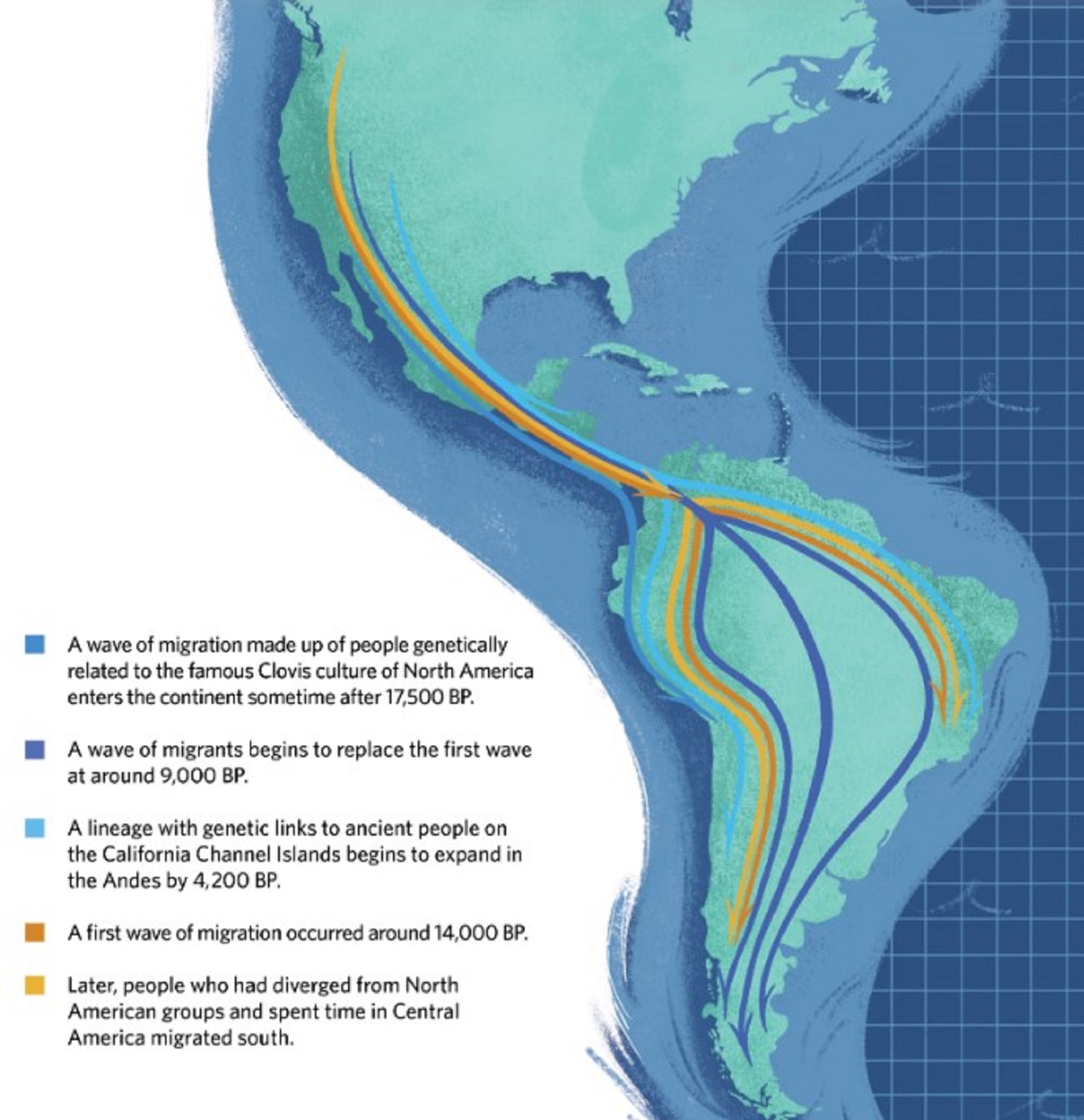
California DNA to Brazil and the Andes around 4,200 years ago?
“Based on current evidence, says Tábita Hünemeier, a population and evolutionary geneticist at the University of São Paulo in Brazil who conducts genetic studies of indigenous Brazilian groups, present-day Andeans seem to have descended from the wave of migrants that replaced the Clovis-related population, together with a more recent wave that occurred around 4,000 BP. After the highland and lowland populations divided around 9,000 years ago, the highland population further split into northern and southern populations around 5,800 BP, a study led by Reich and Fehren-Schmitz recently suggested.” ref
“Historically, the northern islands were occupied by the island Chumash, while the southern islands were occupied by the Tongva. The earliest known Chumash village site has been discovered on Santa Rosa Island. It belongs to the period around 7,500 BP. Soon after, the population density on the islands begins to rise. A significant increase in fish and marine mammal exploitation has been observed.” ref
“Considering regions within California, the area surrounding San Francisco Bay in Northern California, extensive investigation of the region’s dense archaeology has produced a trans-Holocene record, revealing that intensive sedentary or semisedentary habitation extends back >5,000 years ago. The highest levels of IBS sharing occur along the diagonal between individuals from the same population. The analysis suggests four clusters—Nevada, San Francisco Bay Area, North Channel Islands together with Santa Barbara, and South Channel Islands—for which pairs within a cluster possess elevated IBS sharing relative to pairs from distinct clusters. The individuals from Lovelock Cave in Nevada, who are close in age to those from the Rummey Ta Kuččuwiš Tiprectak and Santa Barbara sites, fall above the main cluster. The ancient individuals from the San Francisco Bay Area cluster with the ancient individuals from Southern California. Ancient individuals from Southern California separate into two groups: Individuals from San Nicolas and the Southern Channel Islands have membership primarily in a single component, whereas individuals from Santa Barbara and the North Channel Islands have more substantial membership in a second component as well. As was seen by Moreno-Mayar et al., we find that the individuals from Lovelock Cave in Nevada have noticeable membership in a component shared with those from the Pacific Northwest.” ref
Ancient DNA from a burial in California with A01 dated to 5,200 years old and utilized 90 percent marine resources in the coastal areas of Monterey County, located on the Pacific coast in the U.S. state of California. ref
“Humans utilized the cave starting around 2580 BCE but it was not intensively used until 1000 BCE. The burials from Lovelock Cave do not appear to be similar to the earlier burials from Spirit Cave or to the later burials from Stillwater Marsh. The eight burials from Lovelock Cave were buried at various times between 4,500 and 900 years ago.” ref
“Channel Islands (Bright and Bright 1976; Kroeber 1953), although there is considerable disagreement when this migratory event may have occurred. The most often cited date is about 2,000 years ago (Moratto 1984:559); however, some researchers have suggested a much earlier period, perhaps 5,000 years ago, noting the geographic distribution of certain distinctive items of material culture throughout much of the range known to have been occupied historically by Uto-Aztecan speakers (Raab and Howard 2002).” ref
“DNA studies are tantalizing clues that link some of today’s Chumash with settlers of coastal regions from Alaska to Tierra del Fuego more than 10,000 years ago. A number of scientists believe some may have trudged from Asia and then built boats that, over hundreds of generations, took them to spots where they put down roots along the length of the Pacific Coast. More than half were from the Cayapa tribe of Ecuador. Others were from tribes in Mexico and the southern reaches of Chile. Four matching samples, it would turn out, were from Chumash descendants living along California’s Central Coast. “This confirms a lot of Native American stories about origins,” Cordero said. “The Aztecs, for instance, say their ancestors came from the north, and this is certainly consistent with that. Chumash, link to an ancient tooth in Alaska and tribesmen in an Ecuadoran village.” ref
“North America is notable for its linguistic diversity, especially in California. This area has 18 language families comprising 74 languages (compared to four families in Europe: Indo-European, Uralic, Turkic, and Afroasiatic, and one isolate, Basque).” ref
Gene flow across linguistic boundaries in Native North American populations
“Geneticists and anthropologists often expect that human language groups and gene pools will share a common structure. It is noted that both language and genes are passed from parents to children, mating tends to be endogamous with respect to linguistic groups, and splits in linguistic communities usually occur with splits in breeding populations. Cavalli-Sforza et al. have reported that genetic trees of major geographic populations correlate well with language families. They argue that a process consisting of population fissions, expansion into new territories, and isolation between ancestral and descendant groups will produced a tree-like structure common to both genes and languages. Linguists agree that population fissions and range expansions play an important role in the generation of linguistic diversity.” ref
“The potential correspondence between gene pools and language groups in Native North American populations is particularly interesting for several reasons. Early investigations of the correspondence between genetic groups and linguistic groups in Native North Americans produced equivocal results. On the one hand, average genetic distances between populations in different language families were greater than average genetic distances between populations within language families. On the other hand, genetic distances were not significantly correlated with glottochronological distances. In the three language families, the average nucleotide diversity within populations is low in Eskimo-Aleut populations and high in Amerind populations. However, nucleotide diversity varies considerably among the populations classified as Na-Dene-speaking. The Alaskan Athabascan and Haida populations, who reside in the North, have low nucleotide diversities, in the range of nucleotide diversities in the Eskimo-Aleut-speaking populations. The Navajo and Apache, who reside in the Southwest, have high nucleotide diversities, in the range of nucleotide diversities in populations classified as Amerind speaking.” ref
“Several patterns that depart from the tree structure are apparent upon close examination. For example, the GLC expected distances consistently overestimate the realized genetic distances for several populations, including the Navajo, Aleut, and Siberian Yupik populations. This relationship means that these populations are genetically similar to populations with distantly related languages. Similarly, the GLC tree consistently underestimates the genetic distance between three Eskimo populations (Central Yupik, Canadian Inuit, and Inupaiq) and all other populations. First, none of Greenberg’s major language groups (Eskimo-Aleut, Na-Dene, or Amerind) forms a unique cluster. The most exclusive cluster that contains all Eskimo-Aleut populations (defined by branch a) also includes all four Na-Dene-speaking populations and the Amerind-speaking Cheyenne, Bella Coola, and Nuu Chah Nulth populations.” ref
“The most exclusive cluster with all Na-Dene-speaking populations (defined by branch b) also includes six Eskimo-Aleut-speaking populations (Siberian Yupik, Greenland Inuit, Central Yupik, Canadian Inuit, and Inupiaq) and the Amerind-speaking Bella Coola. The most exclusive cluster with all Amerind-speaking populations (defined by branch c) includes the Eskimo-Aleut-speaking Aleuts and the Na-Dene-speaking Navajo. Second, there is a strong North-South geographic pattern to the clustering pattern. An Arctic-Pacific Northwest cluster that includes all Aleut-Eskimo populations, all Na-Dene populations, and the Amerind Nuu Chah Nulth and Bella Coola populations originates on one side of branch a, whereas a more Southern group includes the Pima, Cherokee, Sioux, and Chippewa Amerind-speaking population forms to the other side of branch a. The Southwestern Athabascan-speaking populations, Navajo and Apache, defy the geographic groupings, but this result is consistent with the archaeological record.” ref
“Anthropologists agree that circa anno Domini 1400 the ancestors of Navajos and Apaches migrated from the Mackenzie Basin of Canada to the Southwest region, where they came into contact with Amerind-speaking populations who had been living there for thousands of years. The occurrence of haplogroup A differs markedly between the far Northern and the Southwestern samples. With only few exceptions, mtDNA lineages observed in the northern Na-Dene classified populations (Haida and Alaskan Athabascans) belong to haplogroup A. Haplogroup A is also common in Eskimos and Aleuts. Outside of the far North, the only samples in which haplogroup A appears commonly are the Southwestern Athabascan-speaking populations (Navajo and Apache). mtDNA sequences belonging to haplogroups B and C are frequent primarily in the Amerind-classified populations, including the Bella Coola, and Nuu Chah Nulth populations on the Northwest Coast. The Navajo and Apache are the only Na-Dene-classified populations with substantial frequencies of B- and C-group haplotypes, although haplogroup C is observed in the Haida and Alaskan Athabascan samples.” ref
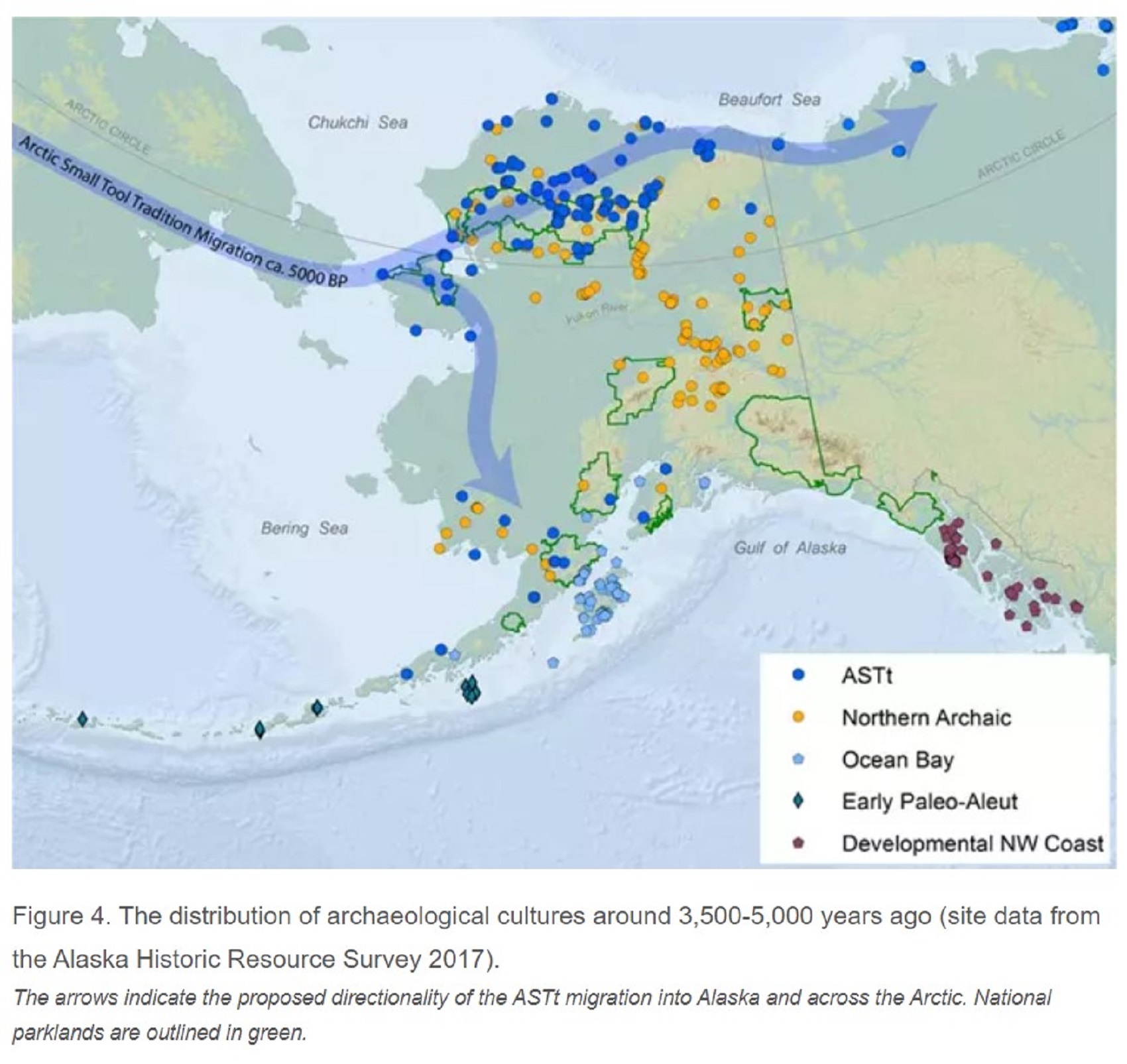
Human Migration from Asia into Alaska (North America) (5,000 to 3,500 years ago)
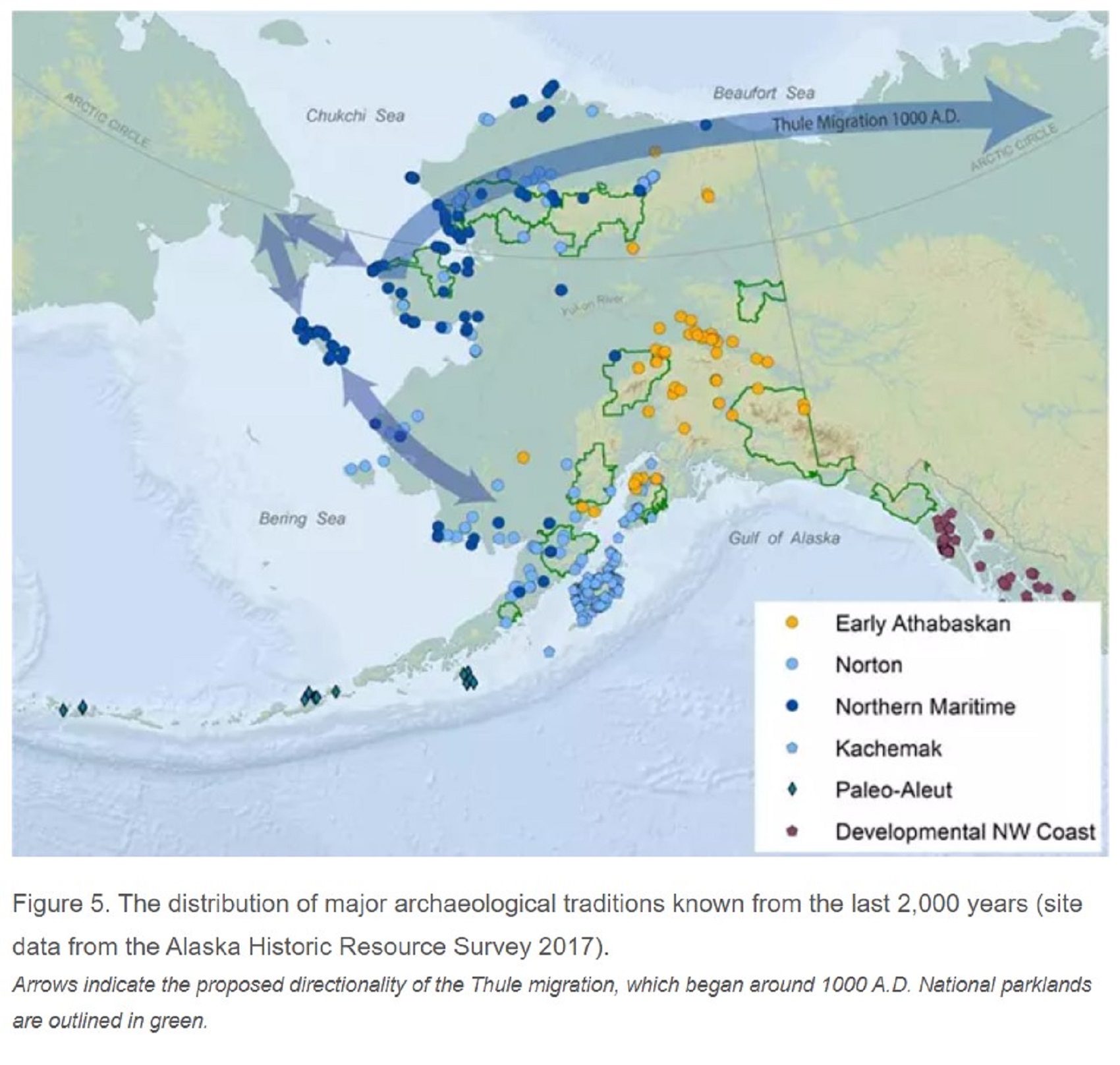
Human Migration from Asia into Alaska (North America) (in the last 2,000 years ago)
Periods in North American Prehistory
Lithic stage: before 8500 BCE
Archaic period: 8000 BC– 1000 BCE
Formative stage: 1000 BCE– CE 500
Woodland period1000 BCE– CE 1000
Classic stage: CE 500–1200
Post-Classic stage: after CE 1200
Lithic stage: before 8500 BCE
“The Lithic stage was the earliest period of human occupation in the Americas, as post-glacial hunter-gatherers spread through the Americas. The stage derived its name from the first appearance of Lithic flaked stone tools. The term Paleo-Indian is an alternative, generally indicating much the same period. This stage was conceived as embracing two major categories of stone technology: (1) unspecialized and largely unformulated core and flake industries, with percussion the dominant and perhaps only technique employed, and (2) industries exhibiting more advanced “blade” techniques of stoneworking, with specialized fluted or unfluted lanceolate points the most characteristic artifact types. Throughout South America, there are stone tool traditions of the lithic stage, such as the “fluted fishtail”, that reflect localized adaptations to the diverse habitats of the continent. In North America, the time encompasses the Paleo-Indian period, which subsequently is divided into more specific time terms, such as Early Lithic stage or Early Paleo-Indians, and Middle Paleo-Indians or Middle Lithic stage. Examples include the Clovis culture and Folsom tradition groups.” ref
Archaic period: 8000 BC– 1000 BCE
“The Archaic stage is characterized by subsistence economies supported through the exploitation of nuts, seeds, and shellfish. As its ending is defined by the adoption of sedentary farming, this date can vary significantly across the Americas. The use of textiles, fired pottery, and start of the gradual replacement of hunter gatherer lifestyles with agriculture and domesticated animals would all be factors. End dates vary, but are around 5,000 to 3,000 BCE in many areas. The Archaic stage is the most widely used term for the succeeding stage, but in the periodization of pre-Columbian Peru, the Cotton Pre-Ceramic may be used. As in the Norte Chico civilization, cultivated cotton seems to have been very important in economic and power relations, from around 3,200 BCE.” ref, ref
Early Archaic
- 8000 BCE: The last glacial period ends, causing sea levels to rise and flood the Beringia land bridge, closing the primary migration route from Siberia.
- 8000 BCE: Sufficient rain falls on the American Southwest to support many large mammal species – mammoth, mastodon, and a bison species – that soon go extinct.
- 8000 BCE: Hunters in the American Southwest use the atlatl.
- 7500 BCE: Early basketry.[citation needed]
- 7560—7370 BCE: Kennewick Man dies along the shore of the Columbia River in Washington State, leaving one of the most complete early Native American skeletons.
- 7000 BCE: Northeastern peoples depend increasingly on deer, nuts, and wild grains as the climate warms.
- 7000 BCE: Native Americans in Lahontan Basin, Nevada mummify their dead to give them honor and respect, evidencing deep concern about their treatment and condition. ref
Middle Archaic
- 6500 BCE–200 CE: The San Dieguito–Pinto tradition and Chihuahua tradition flourish in the Southwest.
- 6000 BCE: Ancestors of Penutian-speaking peoples settle in the Northwestern Plateau.
- 6000 BCE: Nomadic hunting bands roam Subarctic Alaska following herds of caribou and other game animals.
- 6000 BCE: Aleuts begin to arrive in the Aleutian Islands.
- 5700 BCE: Cataclysmic eruption of Mount Mazama in modern-day Oregon.
- 5500 BCE–500 AD: Oshara tradition, a Southwestern Archaic tradition, arises in north-central New Mexico, the San Juan Basin, the Rio Grande Valley, southern Colorado, and southeastern Utah.
- Natives of the Northwestern Plateau begin to rely on salmon runs.
- 5000 BCE: Early cultivation of food crops began in Mesoamerica.
- 5000 BCE: Native Americans in the Pacific Northwest from Alaska to California develop a fishing economy, with salmon as a staple.
- 5000 BCE: The Old Copper Culture of the Great Lakes area hammers the metal into various tools and ornaments, such as knives, axes, awls, bracelets, rings, and pendants.
- 5000 BCE–200 CE: The Cochise tradition arises in the American Southwest.
- Native Americans in the northern Great Lakes produce copper tools, ornaments, and utensils traded throughout the Great Plains and Ohio Valley.
- Shell ornaments and copper items at Indian Knoll in Kentucky evidence an extensive trade system over several millennia.
- 4000 BCE: Inhabitants of Mesoamerica cultivate maize (corn) while Peruvian natives cultivate beans and squash.
- 4000–1000 BCE: Old Copper complex emerges in the Great Lakes region
- 3500 BCE: The largest, oldest drive site at Head-Smashed-In Buffalo Jump, Alberta, Canada.
- 3500–3000 BCE: Construction of extensive mound complex built at Watson Brake in the floodplain of the Ouachita River near Monroe in northern Louisiana.
- Shell ornaments and copper items at Indian Knoll, Kentucky evidence an extensive trade system over several millennia. ref
Late Archaic
- 3000 BCE: Cultivation of the sunflower and marsh elder begins in the American South; northeastern natives cultivate amaranth and marsh elder. After harvesting these plants, the people grind their seeds into flour.
- 3000 BCE: The Cochise tradition of the American Southwest begin cultivating a primitive form of maize imported from Mesoamerica; common beans and squash follow later.
- 3000 BCE: Native Americans of the Pacific Northwest begin to exploit shellfish resources.
- 3000 BCE: Fishing in the Northwestern Plateau increases.
- 3000 BCE: Natives speaking the Algonquian languages arrive in the Northeastern Woodlands from the south.
- Shell ornaments and copper items at Indian Knoll, Kentucky evidence an extensive trade system over several millennia.
- 2888 BCE: People of the Stallings culture on the Savannah River begin making pottery, at a time that pottery making was spreading in South America, but had not reached Mesoamerica.
- 2500–800 BCE: The Arctic Small Tool tradition develops on the Alaska Peninsula, near Bristol Bay, and on the eastern shores of the Bering Strait in Alaska.
- 2500–1800 BCE: Aleutian tradition emerges in Alaska.
- 2500 BCE: Independence I people enter Greenland from North America. The last archaeological evidence of Independence I is from 1730 BCE.
- 2400 BCE: Saqqaq people enter Greenland from Siberia and live there until 400 BC.
- 2500 BCE: The Cochise tradition become skilled farmers of the American Southwest.
- 2100 BCE: Maize cultivation begins in Aridoamerica.
- 2000–1000 BCE: Poverty Point culture in northeastern Louisiana features stone work, flintknapping, earthenware, effigy, conical, and platform mounds, as well as planned settlements on concentric earthen ridges
- 1500 BCE: Salishan speakers arrive in Northwestern Plateau region.
- 1500 BCE–1000 CE: Intermediate Horizon (or Campbell tradition) emerged among Indigenous peoples of California
- Shell ornaments and copper items at Indian Knoll, Kentucky evidence an extensive trade system over several millennia.
- 1000 BCE: Athapaskan-speaking natives arrive in the North American Arctic, possibly from Siberia.
- 1000 BCE: Pottery making widespread in the Eastern woodlands. ref
Global Flood?
When @Graham Hancock talks about a global cataclysm flooding, his ideas relate to slow flooding as that is what ice melt actually did. I think Hancock missed that part in thinking about his global flooding beliefs. Sea level by about 60 m (197 ft) during the early Holocene, between about 12,000 and 7,000 years ago, thus a long time not all at once. Something close to about 4 inches per century or less. Some “global” cataclysm flooding threat. lol
“Ice sheet retreat initiated ca. 19,000 years ago and accelerated after ca. 15,000 years ago. The Holocene, starting with abrupt warming 11,700 years ago, resulted in rapid melting of the remaining ice sheets of North America and Europe. The early Holocene sea level rise (EHSLR) was a significant jump in sea level by about 60 m (197 ft) during the early Holocene, between about 12,000 and 7,000 years ago, spanning the Eurasian Mesolithic. The rapid rise in sea level and associated climate change, notably the 8.2 ka cooling event (8,200 years ago), and the loss of coastal land favored by early farmers, may have contributed to the spread of the Neolithic Revolution to Europe in its Neolithic period.” ref
“During the rest of the early Holocene, the rate of sea level rise varied from a low of about 6.0–9.9 mm (0.2–0.4 in)/yr to as high as 30–60 mm (1.2–2.4 in)/yr during brief periods of accelerated sea level rise. Solid geological evidence, based largely upon analysis of deep cores of coral reefs, exists only for three major periods of accelerated sea level rise, called meltwater pulses, during the last deglaciation. The first, Meltwater pulse 1A, lasted between c. 14.6–14.3 ka and was a 13.5 m (44 ft) rise over about 290 years centered at 14.2 ka.” ref
“The early Holocene sea level rise spans Meltwater pulses 1B and 1C, between 12,000 and 7,000 years ago:
- Meltwater pulse 1B between c. 11.4–11.1 ka, a 7.5 m (25 ft) rise over about 160 years centered at 11.1 ka, which includes the end of Younger Dryas interval of reduced sea level rise at about 6.0–9.9 mm (0.2–0.4 in)/yr;
- Meltwater pulse 1C between c. 8.2–7.6 ka, centered at 8.0 ka, a rise of 6.5 m (21 ft) in less than 140 years.” ref
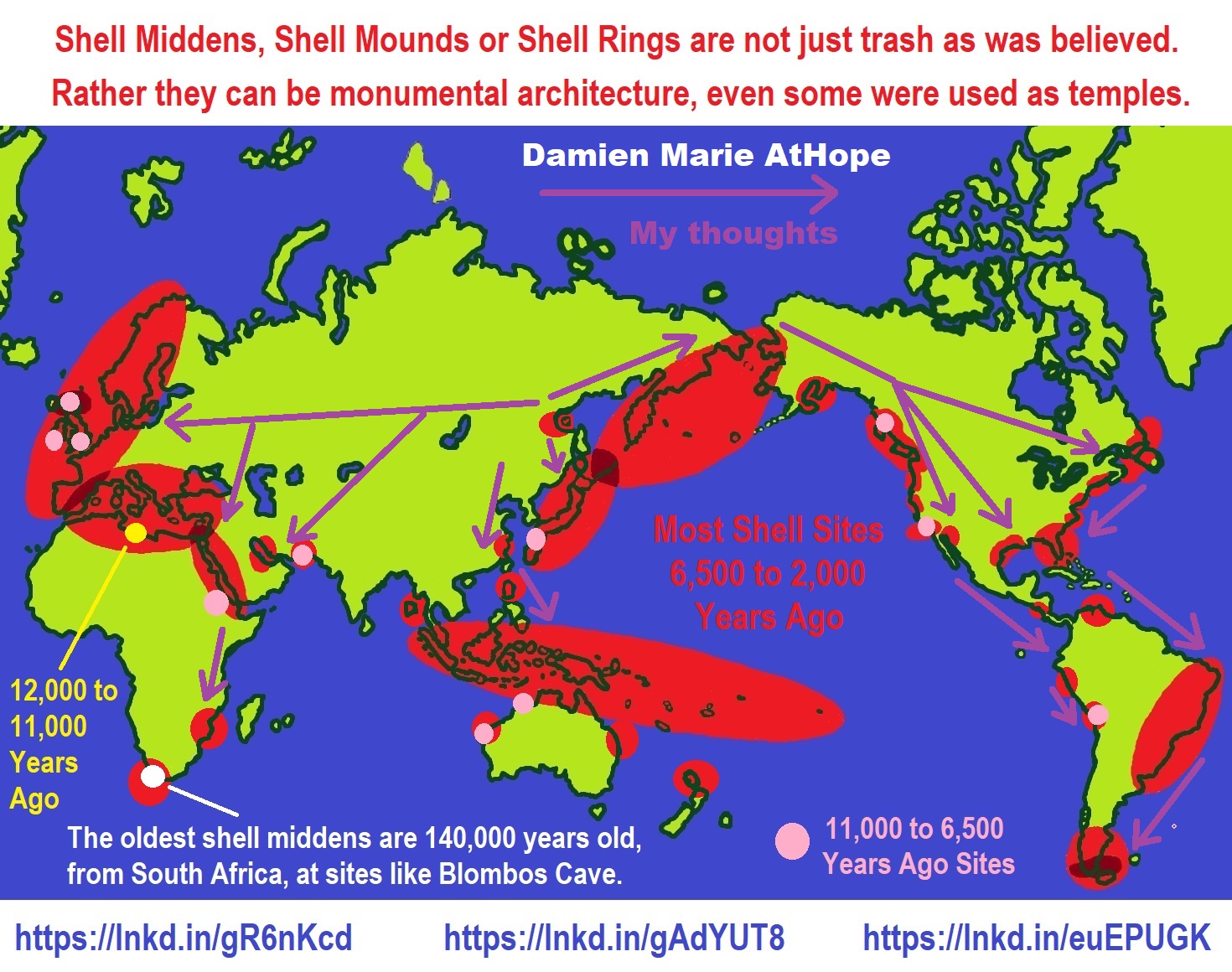
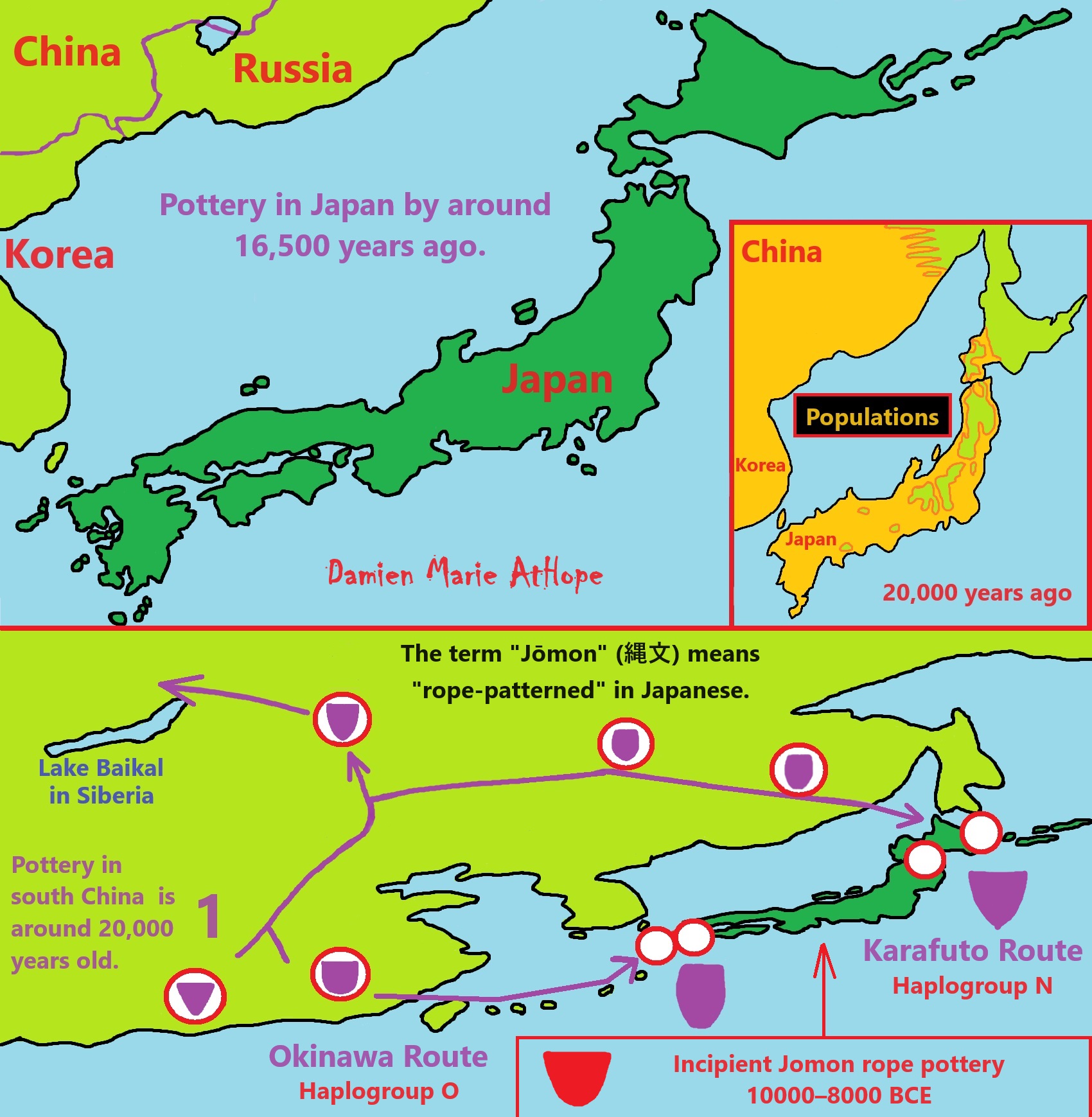

Dispersals of the Siberian Y-chromosome haplogroup Q in Eurasia
“Worldwide distribution of haplogroup Q-M242. The blue star is the original place of haplogroup Q-M242, around Central Asia and Siberia. The brown number one is Russian sample location in the Krasnoyarsk Region. The brown number two is Chinese sample location in Gansu province. The brown number three is Chinese sample location in Zhejiang province. The red arrows are the expansion routes of haplogroup Q-M242. The purple words show the locations of subclades of haplogroup Q used in this study.” ref
“Abstract: The human Y-chromosome has proven to be a powerful tool for tracing the paternal history of human populations and genealogical ancestors. The human Y-chromosome haplogroup Q is the most frequent haplogroup in the Americas. Previous studies have traced the origin of haplogroup Q to the region around Central Asia and Southern Siberia. Although the diversity of haplogroup Q in the Americas has been studied in detail, investigations on the diffusion of haplogroup Q in Eurasia and Africa are still limited. In this study, we collected 39 samples from China and Russia, investigated 432 samples from previous studies of haplogroup Q, and analyzed the single nucleotide polymorphism (SNP) subclades Q1a1a1-M120, Q1a2a1-L54, Q1a1b-M25, Q1a2-M346, Q1a2a1a2-L804, Q1a2b2-F1161, Q1b1a-M378, and Q1b1a1-L245. Through NETWORK and BATWING analyses, we found that the subclades of haplogroup Q continued to disperse from Central Asia and Southern Siberia during the past 10,000 years. Apart from its migration through the Beringia to the Americas, haplogroup Q also moved from Asia to the south and to the west during the Neolithic period, and subsequently to the whole of Eurasia and part of Africa.” ref
Y-chromosome haplogroup Q
“Haplogroup Q-M242 is one of the two branches of P-P226 (M45), the other being R-M207. Q-M242 is believed to have arisen around the Altai Mountains area (or South Central Siberia), approximately 17,000 to 31,700 years ago. However, the matter remains unclear due to limited sample sizes and changing definitions of Haplogroup Q: early definitions used a combination of the SNPs M242, P36.2, and MEH2 as defining mutations. Q-M242 is the predominant Y-DNA haplogroup among Native Americans and several peoples of Central Asia and Northern Siberia.” ref
|
Highest frequencies |
Kets 93.8%, Indigenous peoples of South America 92%, Turkmens from Karakalpakstan (mainly Yomut) 73%, Selkups 66.4%., Altaians 63.6%., Tuvans (from Xinjiang) 62.5%., Chelkans 60.0%., Greenlandic Inuit 54%, Tubalar 41%, Siberian Tatars (Ishtyak-Tokuz Tatars) 38%, Inuit, the indigenous peoples of the Americas, Akha people of northern Thailand, Mon-Khmer people and some tribes of Assam |
- Q1a (L472, MEH2) : found among the Koryaks of eastern Siberia
- Q1a1 (F1096)
- Q1a1a (F746)
- Q1a1a1 (M120) : observed in Mongolia, Japan and India
- Q1a1b (M25) : observed in Mongolia, Siberia, northern India, the Middle East, Italy and Ireland
- Q1a1b1 (L712): found in Central & Eastern Europe (probably Hunnic and/or Mongolian)
- Q1a1b1a (L713)
- Q1a2 (L56, M346): found in Kazakhstan, Russia, Armenia and Hungary
- Q1a2a (L53): found among the Mongols
- Q1a2a1 (L54): found in Mesolthic western Russia
- Q1a2a1a (CTS11969)
- Q1a2a1a1 (M3): the main subclade of Native Americans
- Q1a2a1a2 (L804): found in Germany, Scandinavia and Britain
- Q1a2a1a2a (L807): observed in Britain
- Q1a2a1b (Z780): found among Native Americans, notably in Mexico
- Q1a2a1c (L330): the main subclade of the Mongols, also found among the Kazakhs and Uzbeks, as well as in Ukraine, Turkey and Greece (probably Mongolian and Turkic)
- Q1a2b (L940): found in Central Asia, Afghanistan, India, Russia, Georgia, Hungary, Poland and Germany
- Q1a2b1 (L527): found almost exclusively in Scandinavia and places settled by the Vikings
- Q1a2b2 (L938): observed in Anatolia, Lithuania, Britain and Portugal
- Q1a2b2a (L939): observed in Britain
- Q1a2c (M323)
- Q1b (L275): found among the Tatars of Russia, in Central Asia, Afghanistan and Pakistan
- Q1b1 (M378): observed in Kazakhstan, India and Germany
- Q1b1a (L245): found in the Middle East, among the Jews, in Central Europe and in Sicily
- Q1b1a1 (L272.1): found in Sicily (probably Phoenician) ref
“Haplogroup Q is thought to have originated in Central Asia or North Asia during of shortly after the Last Glacial Maximum (LGM, 26,000 to 19,000 years ago). Q descends from haplogroup P, which is also the ancestor of haplogroups R1a and R1b. Haplogroup Q quickly split into two main branches: Q1a and Q1b. The northern Q1a tribes expanded over Siberia as the climate warmed up after the LGM. Some Q1a crossed the still frozen Bering Strait to the American continent some time between 16,500 and 13,000 years ago. Q1b tribes stayed in Central Asia and later migrated south towards the Middle East.” ref
“Q1a is also the main paternal lineage of Native Americans. The testing of the genome of 12,600 year-old boy (known as Anzick-1) from Clovis culture in the USA confirmed that haplogroup Q1a2a1 (L54) was already present on the American continent before the end of the Last Glaciation. The vast maority of modern Native Americans belong to the Q1a2a1a1 (M3) subclade. As this subclade is exclusive to the American continent and the Anzick boy was negative for the M3 mutation, it is likely that M3 appeared after Q1a2a1 reached America.” ref
“The maternal equivalents of that Siberian Q1a2 in prehistoric Eastern Europe are probably mtDNA haplogroups C4a and C5, which have been found Mesolithic Karelia (north-western Russia), in the Neolithic Dnieper-Donets culture in Ukraine, and in the Bronze Age Catacomb culture in the Pontic Steppe. Nowadays mtDNA C is mostly found among Siberians, Mongols, and Native Americans, who happen to share Y-haplogroup Q1a2 on the paternal side. The analysis of prehistoric genomes from Eastern Europe did confirm the presence of a small percentage of Amerindian-related autosomal admixture. In contrast with Q1b1, Q1b2 (Y1150) is found almost exclusively in the Indian subcontinent. The two Q1b branch split from each others some 15,000 years ago, during the Late Paleolithic period. Data is still sparse about this subclade, but is it reasonable to assume that it has been in South Asia at least since the end of the last Ice Age, long before the Indo-European migrations.” ref
“Oddly enough, the L804 branch, which descends from the same Northeast Siberian branch as the Native American M3, is now found exclusively in Germanic countries, including Scandinavia, Germany, Britain, and northern France. Like the other Scandinavian branch (L527>Y4827), its genetic diversity suggests that this lineage expanded from a single ancestor living approximately 3,000 years ago, presumably in Scandinavia, in what would have been the Nordic Bronze Age. At present it remains unclear when and how Q1a2-L804 reached Europe in the first place, but it might have been a very long time ago, during the late glacial period or the Mesolithic period. It may well have arrived at the same time as Q-Y4827. Alternatively, L804 might have come as a minor lineage accompanying haplogroup N1c1 from Mongolia until it reached Northeast Europe during the Neolithic period, some 7,000 years ago.” ref
“Several branches of haplogroup Q-M242 have been predominant pre-Columbian male lineages in indigenous peoples of the Americas. Most of them are descendants of the major founding groups who migrated from Asia into the Americas by crossing the Bering Strait. These small groups of founders must have included men from the Q-M346, Q-L54, Q-Z780, and Q-M3 lineages. In North America, two other Q-lineages also have been found. These are Q-P89.1 (under Q-MEH2) and Q-NWT01. They may have not been from the Beringia Crossings but instead come from later immigrants who traveled along the shoreline of Far East Asia and then the Americas using boats. It is unclear whether the current frequency of Q-M242 lineages represents their frequency at the time of immigration or is the result of the shifts in a small founder population over time. Regardless, Q-M242 came to dominate the paternal lineages in the Americas.” ref
“Q-M242 originated in Asia (Altai region), and is widely distributed across it. Q-M242 is found in Russia, Siberia (Kets, Selkups, Siberian Yupik people, Nivkhs, Chukchi people, Yukaghirs, Tuvans, Altai people, Koryaks, etc.), Mongolia, China, Uyghurs, Tibet, Korea, Japan, Indonesia, Vietnam, Thailand, India, Pakistan, Afghanistan, Iran, Iraq, Saudi Arabia, Turkmenistan, Uzbekistan, and so on.” ref
“In Siberia, the regions between Altai and Lake Baikal, which are famous for many prehistoric cultures and as the most likely birthplace of haplogroup Q, exhibit high frequencies of Q-M242. In a study (Dulik 2012), Q-M242 (mostly Q-M346 including some Q-M3) has been found in 24.3% (46/189: 45 Q-M346, 1 Q-M25) of all Altaian samples. Among them, Chelkans show the highest frequency at 60.0% (15/25: all Q-M346), followed by Tubalars at 41% (11/27: 1 Q-M25, 10 Q-M346) and Altaians-Kizhi at 17% (20/120). In a former study, Q-M242 is found in 4.2% of southern Altaians and 32.0% of northern Altaians with the highest frequency of 63.6% in Kurmach-Baigol (Baygol). The frequency reaches 13.7% (20/146) in the whole samples. In another study, the frequency rises up to 25.8% (23/89: all Q-M346) in Altaians. Based on the results of these studies, the average frequency of Q-M242 in Altaians is about 21%.” ref
“Tuva, which is located on the east side of Altai Republic and west of Lake Baikal as well as on the north side of Mongolia, shows higher frequency of Q-M242. It is found in 14%~38.0% (41/108) of Tuvans. Also, Todjins (Tozhu Tuvans) in eastern Tuva show the frequency at ≤22.2% (8/36 P(xR1))~38.5% (10/26, all Q-M346(xM3)). So, the average frequency of Q-M242 among Tuvans-Todjins in Tuva Republic is about 25%. Haplogroup Q-M242 has been found in 5.9% (3/51) of a sample of Tuvans from the village of Kanasi, 9.8% (5/51) of a sample of Tuvans from the village of Hemu, and 62.5% (30/48) of a sample of Tuvans from the village of Baihaba in northern Xinjiang near the international border with Altai Republic.” ref
“In Siberian Tatars, the Ishtyako-Tokuz sub-group of Tobol-Irtysh group has a frequency of Q-M242 at 38%. The highest frequencies of Q-M242 in Eurasia are witnessed in Kets (central Siberia) at 93.8% (45/48) and in Selkups (north Siberia) at 66.4% (87/131). Russian ethnographers believe that their ancient places were farther south, in the area of the Altai and Sayan Mountains (Altai-Sayan region). Their populations are currently small in number, being just under 1,500 and 5,000 respectively. In linguistic anthropology, the Ket language is significant as it is currently the only surviving one in the Yeniseian language family which has been linked by some scholars to the Native American Na-Dené languages and, more controversially, the language of the Huns. (See: L. Lieti, E. Pulleybank, E. Vajda, A. Vovin, etc.) Q-M346 is also found at lower rates in Sojots (7.1%, Q-M346), Khakassians (6.3%, Q-M346), Kalmyks (3.4%, Q-M25, Q-M346), Khanty, and so on.” ref
“In far eastern Siberia, Q-M242 is found in 35.3% of Nivkhs (Gilyaks) in the lower Amur River, and 33.3% of Chukchi people and 39.2% of Siberian Yupik people in Chukotka (Chukchi Peninsula). It is found in 30.8% of Yukaghirs who live in the basin of the Kolyma River, which is located northwest of Kamchatka. It is also found in 15% (Q1a* 9%, Q-M3 6%) of Koryaks in Kamchatka.” ref
Haplogroup Q in North America
“In the indigenous people of North America, Q-M242 is found in Na-Dené speakers at an average rate of 68%. The highest frequency is 92.3% in Navajo, followed by 78.1% in Apache, 87% in SC Apache, and about 80% in North American Eskimo (Inuit, Yupik)–Aleut populations. (Q-M3 occupies 46% among Q in North America). On the other hand, a 4000-year-old Saqqaq individual belonging to Q1a-MEH2* has been found in Greenland. Surprisingly, he turned out to be genetically more closely related to Far East Siberians such as Koryaks and Chukchi people rather than Native Americans. Today, the frequency of Q runs at 53.7% (122/227: 70 Q-NWT01, 52 Q-M3) in Greenland, showing the highest in east Sermersooq at 82% and the lowest in Qeqqata at 30%.” ref
Haplogroup Q in Mesoamerica & South America
“Haplogroup Q-M242 has been found in approximately 94% of Indigenous peoples of Mesoamerica and South America. The frequencies of Q among the whole male population of each country reach as follows:
- 61% in Bolivia.
- 51% in Guatemala,
- 40.1% (159/397) to 50% in Peru
- 37.6% in Ecuador,
- 37.3% (181/485) in Mexico (30.8% (203/659) among the specifically Mestizo segment)
- 31.2% (50/160) in El Salvador,
- 15.3% (37/242) to 21.8% (89/408) in Panama,
- 16.1% in Colombia,
- 15.2% (25/165) in Nicaragua,
- 9.7% (20/206) in Chile,
- 5.3% (13/246 in 8 provinces in northeastern, central, southern regions) to 23.4% (181/775 in 8 provinces in central-west, central, northwest regions) in Argentina,
- 5% in Costa Rica,
- 3.95% in Brazil, and so on.” ref
Y-DNA Q samples from ancient sites
- South Central Siberia (near Altai)
- Afontova-Gora-2, Yenisei River Bank, Krasnoyarsk (South Central Siberia of Russia), 17000YBP: Q1a1-F1215 (mtDNA R)
- North America
- Anzick-1, Clovis culture, western Montana, 12600YBP: Q1a2-L54* (not M3, mtDNA D4h3a)
- Kennewick Man, Washington, 8500YBP: Q1a2-M3 (mtDNA X2a)
- Altai (West Mongolia)
- Tsagaan Asga and Takhilgat Uzuur-5 Kurgan sites, westernmost Mongolian Altai, 2900YBP-4800YBP: 4 R1a1a1b2-Z93 (B.C. 10C, B.C. 14C, 2 period unknown), 3 Q1a2a1-L54 (period unknown), 1 Q-M242 (B.C. 28C), 1 C-M130 (B.C. 10C)
- Greenland
- Saqqaq (Qilakitsoq), Greenland, 4000YBP: Q1a-YP1500 (mtDNA D2a1)
- China
- Hengbei site (Peng kingdom cemetery of Western Zhou period), Jiang County, Shanxi, 2800-3000YBP: 9 Q1a1-M120, 2 O2a-M95, 1 N, 4 O3a2-P201, 2 O3, 4 O*
- In another paper, the social status of those human remains of ancient Peng kingdom(倗国) are analyzed. aristocrats: 3 Q1a1 (prostrate 2, supine 1), 2 O3a (supine 2), 1 N (prostrate) / commoners : 8 Q1a1 (prostrate 4, supine 4), 3 O3a (prostrate 1, supine 2), 3 O* (supine 3) / slaves: 3 O3a, 2 O2a, 1 O*
- (cf) Pengbo (倗伯), Monarch of Peng Kingdom is estimated as Q-M120.
- Pengyang County, Ningxia, 2500YBP: all 4 Q1a1-M120 (with a lot of animal bones and bronze swords and other weapons, etc.)
- Heigouliang, Xinjiang, 2200YBP: 6 Q1a* (not Q1a1-M120, not Q1a1b-M25, not Q1a2-M3), 4 Q1b-M378, 2 Q* (not Q1a, not Q1b: unable to determine subclades):
- In a paper (Lihongjie 2012), the author analyzed the Y-DNAs of the ancient male samples from the 2nd or 1st century BCE cemetery at Heigouliang in Xinjiang – which is also believed to be the site of a summer palace for Xiongnu kings – which is east of the Barkol basin and near the city of Hami. The Y-DNA of 12 men excavated from the site belonged to Q-MEH2 (Q1a) or Q-M378 (Q1b). The Q-M378 men among them were regarded as hosts of the tombs; half of the Q-MEH2 men appeared to be hosts and the other half as sacrificial victims.
- Xiongnu site in Barkol, Xinjiang, all 3 Q-M3
- In L. L. Kang et al. (2013), three samples from a Xiongnu) site in Barkol, Xinjiang were found to be Q-M3 (Q1a2a1a1). And, as Q-M3 is mostly found in Yeniseians and Native Americans, the authors suggest that the Xiongnu had connections to speakers of the Yeniseian languages. These discoveries from the above papers (Li 2012, Kang et al., 2013) have some positive implications on the not as yet clearly verified theory that the Xiongnu were precursors of the Huns.
- Mongolian noble burials in the Yuan dynasty, Shuzhuanglou Site, northernmost Hebei China, 700YBP: all 3 Q (not analysed subclade, the principal occupant Gaodangwang Korguz (高唐王=趙王 阔里吉思)’s mtDNA=D4m2, two others mtDNA=A)
- (cf) Korguz was a son of a princess of Kublai Khan (元 世祖), and was the king of the Ongud tribe. He died in 1298 and was reburied in Shuzhuanglou in 1311 by his son. (Do not confuse this man with the Uyghur governor, Korguz who died in 1242.) The Ongud tribe (汪古部) was a descendant of the Shatuo tribe (沙陀族) which was a tribe of Göktürks (Western Turkic Khaganate) and was prominent in the Five Dynasties and Ten Kingdoms period of China, building three dynasties. His two queens were all princesses of the Yuan dynasty (Kublai Khan’s granddaughters). It was very important for the Yuan dynasty to maintain a marriage alliance with Ongud tribe which had been a principal assistant since Genghis Khan‘s period. About 16 princesses of the Yuan dynasty married kings of the Ongud tribe.” ref
“In recent decades, the human Y-chromosome has proven to be a powerful tool for tracing the paternal history of human populations and genealogical ancestors. The human Y-chromosome haplogroup Q (also named Q-M242 in accordance with its defining mutation) probably originated in Central Asia and Southern Siberia during the time period of 15–25 KYA (1000 years ago), then subsequently diffused in the eastward, westward, and southward directions. Haplogroup Q has several subclades defined by single nucleotide polymorphisms (SNPs), and it reaches its highest frequency of 70–100% in the Americas. Although the diversity of haplogroup Q in the Americas has been studied in detail, investigations on the diffusion of haplogroup Q in Eurasia and Africa are still limited. Consequently, we studied samples of haplogroup Q in Eurasia to explore how it expanded from Central Asia and Southern Siberia during the Neolithic period.” ref
“The ancestors of present-day Native Americans migrated to the Americas from Siberia via the Beringia around 16 KYA. Q1a2a1-L54 and its subclade Q1a2a1a1-M3 are the two predominant subclades of haplogroup Q found on both sides of the Bering Strait. Q1a2a1-L54 has spread throughout Northern Asia, the Americas, and Western and Central Europe. An ancient individual of the Clovis culture belonged to Q1a2a1-L54 (xQ1a2a1a1-M3). Q1a2a1a1-M3, one of the most thoroughly studied subclades within haplogroup Q, is frequent both in the Chukotka Peninsula of Siberia (close to Alaska) and the Americas. Previous studies indicated that Q1a2a1a1-M3 migrated from Siberia to the Americas and partially returned to Siberia. The estimated time of Q1a2a1a1-M3 is 13-22 KYA. Q1a2a1a1a-M19, a subclade of Q1a2a1a1-M3, remained in Southern America and has a similarly diversified pattern with its upstream lineage. The age of Q1a2a1a1a-M19 is approximately 7–8 KYA.” ref
“The frequencies of haplogroup Q range from 0 to 94% in Eurasia (approximately 5% on average). Haplogroup Q reaches its highest frequencies in Siberia, especially in Kets (90–94%) and Selkups (66–71%), and is rarely seen in Western, Southern and South-eastern Asia. Subclade Q1a1a1-M120 appears almost only in Eastern Asia, and its diversity implies that haplogroup Q has migrated from north to south with the ancestors of current Han Chinese during the Neolithic period. Subclades Q1a1b-M25 and Q1a2-M346 have spread widely in Eurasia. Q1a1b-M25 reaches its highest frequency in Turkmen (34–43%) and shows low frequencies in other Eurasian populations, while Q1a2-M346 appears in Central, Western, and Southern Asia, and most parts of Europe.” ref
“Haplogroup Q has also appeared in other parts of the world. For instance, an ancient DNA study of a Saqqaq individual in Greenland suggests that haplogroup Q1a-MEH2 was frequent in Siberian and Native American populations. A few subclades of haplogroup Q have been identified in the Comoros population in Africa (Q1a2-M346) and the Polynesian islands in Oceania (Q1a2a1a1c-M199). Nowadays, the distribution of haplogroup Q in the Americas has been studied thoroughly, but we know little about its dispersals on western and southern routes. In this study, we present an analysis of some SNP subclades of haplogroup Q, including Q1a1a1-M120, Q1a2a1-L54, Q1a1b-M25, Q1a2-M346, Q1a2a1a2-L804, Q1a2b2-F1161, Q1b1a-M378, and Q1b1a1-L245. Based on NETWORK and BATWING analyses of haplogroup Q, we were able to better understand its dispersals on western and southern routes, and their impacts on Eurasian populations.” ref
mtDNA – R
“mtDNA Haplogroup R is a widely distributed human mitochondrial DNA (mtDNA) haplogroup. Haplogroup R is associated with the peopling of Eurasia after about 70,000 years ago, and is distributed in modern populations throughout the world outside of sub-Saharan Africa. Haplogroup R is a descendant of the macro-haplogroup N. Among the R clade’s descendant haplogroups are B, U (and thus K), F, R0 (and thus HV, H, and V), and JT (the ancestral haplogroup of J and T). Soares et al. (2009) estimate the age of haplogroup R at roughly 50,000 to 70,000 years ago.” ref
“This is consistent with an emergence in the course of the Coastal Migration out of East Africa to West, South and Southeast Asia. It has been suggested that the early lineage of haplogroups M, N and R along the coastal route during the period of roughly 70,000 to 60,000 years ago. The northern route out of Africa is another possibility, where the expansion of haplogroup R may originate from South East Asia. Haplogroup R has wide diversity and antiquity in the indigenous population of South Asia. Tribes and castes of Western and Southern India show higher diversity than the other regions, possibly suggesting their autochthonous status. Larruga et al. (2017) found mtDNA R spread out to Eurasia and Australia from a core area along the Southeast Asian coast.” ref
“The Ust’-Ishim man fossil of Siberia, dated ca. 45,000 years old, belongs to haplogroup R* (formerly classified as U*). Haplogroup R has also been observed among Egyptian mummies excavated at the Abusir el-Meleq archaeological site in Northern Egypt, which date from the Pre-Ptolemaic/late New Kingdom, Ptolemaic, and Roman periods. Subclade R2 was observed in the remains of a Neolithic human from western Iran in Tepe Abdul Hosein. Haplogroup R and its descendants are distributed all over Australasia, Americas, Southeast Asia, South Asia, Central Asia, West Asia, East Asia, Europe, North Africa, and Horn of Africa.” ref

ref, ref, ref, ref, ref, ref, ref, ref, ref, ref, ref, ref, ref, ref, ref, ref, ref, ref, ref
Here are my thoughts/speculations on where I believe is the possible origin of shamanism, which may have begun sometime around 35,000 to 30,000 years ago seen in the emergence of the Gravettian culture, just to outline his thinking, on what thousands of years later led to evolved Asian shamanism, in general, and thus WU shamanism as well. In both Europe-related “shamanism-possible burials” and in Gravettian mitochondrial DNA is a seeming connection to Haplogroup U. And the first believed Shaman proposed burial belonged to Eastern Gravettians/Pavlovian culture at Dolní Věstonice in southern Moravia in the Czech Republic, which is the oldest permanent human settlement that has ever been found. It is at Dolní Věstonice where approximately 27,000-25,000 years ago a seeming female shaman was buried and also there was an ivory totem portrait figure, seemingly of her.
And my thoughts on how cultural/ritual aspects were influenced in the area of Göbekli Tepe. I think it relates to a few different cultures starting in the area before the Neolithic. Two different groups of Siberians first from northwest Siberia with U6 haplogroup 40,000 to 30,000 or so. Then R Haplogroup (mainly haplogroup R1b but also some possible R1a both related to the Ancient North Eurasians). This second group added its “R1b” DNA of around 50% to the two cultures Natufian and Trialetian. To me, it is likely both of these cultures helped create Göbekli Tepe. Then I think the female art or graffiti seen at Göbekli Tepe to me possibly relates to the Epigravettians that made it into Turkey and have similar art in North Italy. I speculate that possibly the Totem pole figurines seen first at Kostenki, next went to Mal’ta in Siberia as seen in their figurines that also seem “Totem-pole-like”, and then with the migrations of R1a it may have inspired the Shigir idol in Russia and the migrations of R1b may have inspired Göbekli Tepe.
Göbekli Tepe Shamanism
From the journal Praehistorische Zeitschrift
“Abstract: The term shamanism is widely used in archaeology to describe early belief systems. Sometimes, this has taken the form of a one-size-fits-all-explanation, without a discussion of the concept or the cultural contexts it was applied to. Recently, the Early Neolithic (9600–7000 BCE) of southwestern Asia has become a focal point of this discussion. Sites like Nevalı Çori, Göbekli Tepe, Jerf el Ahmar, Körtik Tepe, Tell Abr’3, Tell Qaramel, Wadi Faynan 16, Karahantepe and Sayburç have produced rich evidence, mostly of an iconographical nature, that seems to offer direct insights into early belief systems. The current contribution uses one of the best-researched sites, Göbekli Tepe, as a case study to develop criteria for the identification of shamanism in the archaeological record.” ref

ref, ref, ref, ref, ref, ref, ref, ref, ref
“Several linguists and geneticists suggest that the Uralic languages are related to various Siberian languages and possibly also some languages of northern Native Americans. A proposed family is named Uralo-Siberian, it includes Uralic, Yukaghir, Eskimo–Aleut (Inuit), possibly Nivkh, and Chukotko-Kamchatkan. Haplogroup Q is found in nearly all Native Americans and nearly all of the Yeniseian Ket people (90%).” ref, ref
You can find some form of Shamanism, among Uralic, Transeurasian, Dené–Yeniseian, Chukotko-Kamchatkan, and Eskaleut languages.
My speculations of shamanism are its dispersals, after 24,000 to 4,000 years ago, seem to center on Lake Baikal and related areas. To me, the hotspot of Shamanism goes from west of Lake Baikal in the “Altai Mountains” also encompassing “Lake Baikal” and includes the “Amur Region/Watershed” east of Lake Baikal as the main location Shamanism seems to have radiated out from.
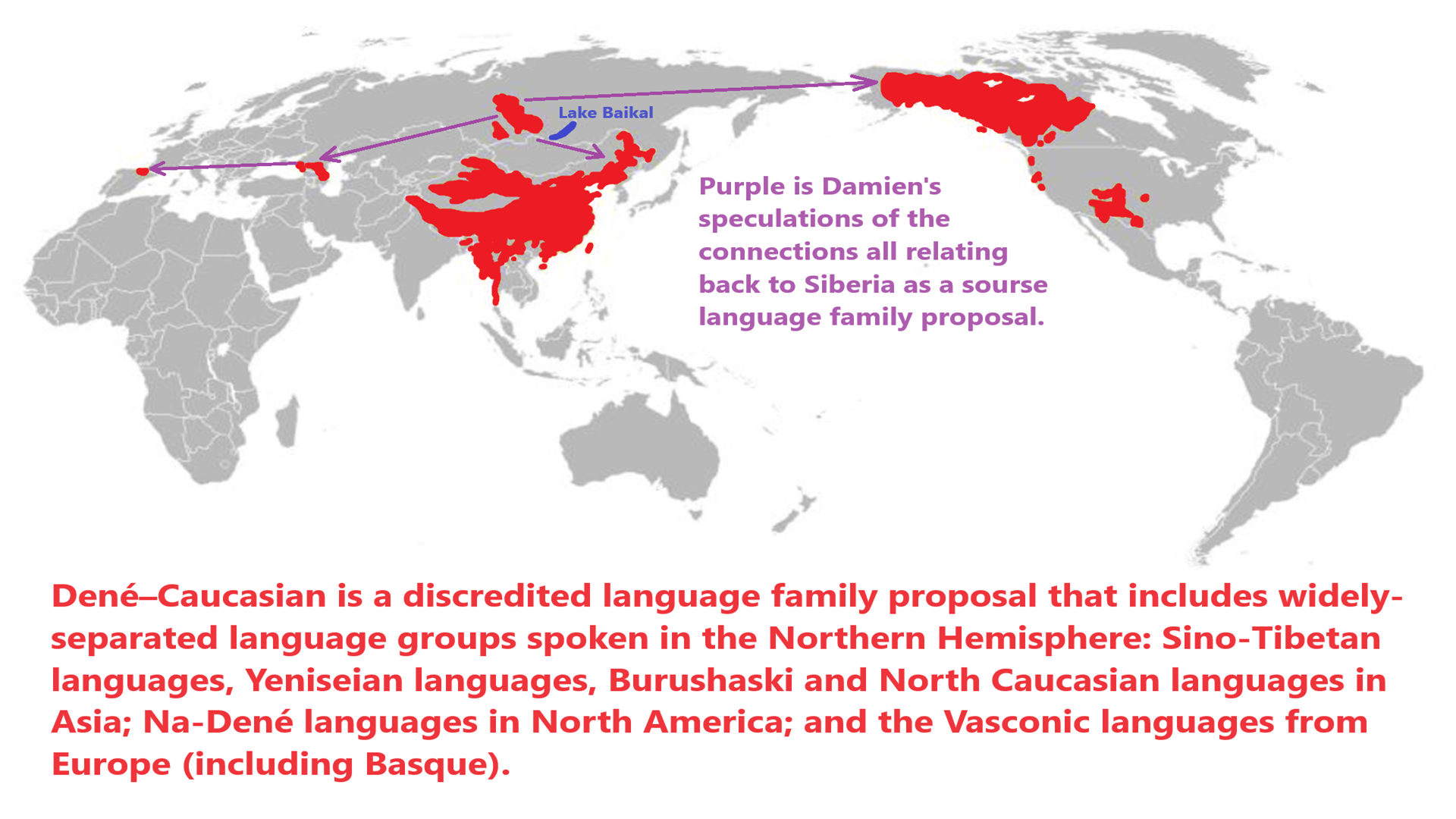
“Dené–Caucasian is a discredited language family proposal that includes widely-separated language groups spoken in the Northern Hemisphere: Sino-Tibetan languages, Yeniseian languages, Burushaski and North Caucasian languages in Asia; Na-Dené languages in North America; and the Vasconic languages from Europe (including Basque). A narrower connection specifically between North American Na-Dené and Siberian Yeniseian (the Dené–Yeniseian languages hypothesis) was proposed by Edward Vajda in 2008, and has met with some acceptance within the community of professional linguists. The validity of the rest of the family, however, is viewed as doubtful or rejected by nearly all historical linguists.” ref
“The Dené–Caucasian family tree and approximate divergence dates (estimated by modified glottochronology) proposed by S. A. Starostin and his colleagues from the Tower of Babel project:
- Dené–Caucasian languages [8,700 BCE or around 10,700 years ago]
- Na-Dené languages (Athabascan–Eyak–Tlingit)
- Sino-Vasconic languages [7,900 BCE or around 9,900 years ago]
- Vasconic (see below)
- Sino-Caucasian languages [6,200 BCE or around 8,200 years ago]
- Burushaski
- Caucaso-Sino-Yeniseian [5,900 BCE or around 7,900 years ago]
- North Caucasian languages
- Sino-Yeniseian [5,100 BCE or around 7,100 years ago]
“John D. Bengtson groups Basque, Caucasian and Burushaski together in a Macro-Caucasian (earlier Vasco-Caucasian) family (see the section on Macro-Caucasian below). According to him, it is as yet premature to propose other nodes or subgroupings, but he notes that Sumerian seems to share the same number of isoglosses with the (geographically) western branches as with the eastern ones:
- Dené–Caucasian
- The Macro-Caucasian family
- Basque
- North Caucasian
- Burushaski
- Sumerian
- Sino-Tibetan
- Yeniseian
- Na-Dené” ref
- The Macro-Caucasian family
“It has been conjectured that the North-West Caucasian languages may be genetically related to the Indo-European family, at a time depth of perhaps 12,000 years before the present. This hypothesized proto-language is called Proto-Pontic, but is not widely accepted. There does at least appear to have been extensive contact between the two proto-languages, and the resemblances may be due to this influence. A few linguists have proposed even broader relationships, of which the Dene–Caucasian hypothesis is perhaps the most popular. Dene–Caucasian links the North Caucasian (including Northwest Caucasian), Basque, Burushaski, Yeniseian, Sino-Tibetan, and Na–Dene families. However, this is an even more tentative hypothesis than Nostratic, which attempts to relate Kartvelian, Indo-European, Uralic, and Altaic, etc., and which is widely considered to be undemonstrated.” ref
“Nostratic is a hypothetical language macrofamily including many of the language families of northern Eurasia. Though a historically important proposal, in a contemporary context it is typically considered a fringe theory. Although the exact composition varies based on proponent, it typically comprises Kartvelian, Indo-European and Uralic languages; some languages from the similarly controversial Altaic family; the Afroasiatic languages; as well as the Dravidian languages (sometimes also Elamo-Dravidian).” ref
“Iran Neolithic (Iran_N) individuals dated ~8,500 years ago carried 50% Ancient North Eurasian-derived admixture and 50% Dzudzuana-related admixture, marking them as different from other Near-Eastern and Anatolian Neolithics who didn’t have Ancient North Eurasian admixture. Iran Neolithics were later replaced by Iran Chalcolithics, who were a mixture of Iran Neolithic and Near Eastern Levant Neolithic.” ref
I speculate that possibly this “Iran Neolithic” difference is a later migration relating to Ancient North Eurasian admixture, with the source languages from Siberia (pre-proto-indo-europeain, like some kind of pre/proto-Yeniseian, or Dené–Yeniseian languages/or Dené–Caucasian) that then merged into proto-indo-European languages seen just west of Iran in the Caucasus and East Turkey areas. Also, I speculate that the idea of pottery was likewise brought by these peoples and they, to me could have influenced the creation of the earliest pottery in Tell Hassuna and Jarmo (Iraq).
“Proto-Yeniseian or Proto-Yeniseic is the unattested reconstructed proto-language from which all Yeniseian languages are thought to descend from. It is uncertain whether Proto-Yeniseian had a similar tone/pitch accent system as Ket people, who practiced Shamanism and connected to Tengrism. Many studies about Proto-Yeniseian phonology have been done, however there are still many things unclear about Proto-Yeniseian. The probable location of the Yeniseian homeland is proposed on the basis of geographic names and genetic studies, which suggests a homeland in Southern Siberia.” ref
“Tengri (Old Turkic: 𐰚𐰇𐰚:𐱅𐰭𐰼𐰃, romanized: Kök Teŋri/Teŋiri, lit. ’Blue Heaven’; Old Uyghur: tängri; Middle Turkic: تآنغرِ; Ottoman Turkish: تڭری; Kyrgyz: Теңир; Kazakh: Тәңір; Turkish: Tanrı; Azerbaijani: Tanrı; Bulgarian: Тангра; Proto-Turkic *teŋri / *taŋrɨ; Mongolian script: ᠲᠩᠷᠢ, T’ngri; Mongolian: Тэнгэр, Tenger; Uyghur: تەڭرى tengri ) is the all-encompassing God of Heaven in the traditional Turkic, Yeniseian, Mongolic, and various other nomadic Altaic religious beliefs. Tengri is not considered a deity in the usual sense, but a personification of the universe. However, some qualities associated with Tengri as the judge and source of life, and being eternal and supreme, led European and Muslim writers to identify Tengri as a deity of Turkic and Mongolic peoples. According to Mongolian belief, Tengri’s will (jayayan) may break its own usual laws and intervene by sending a chosen person to earth. It is also one of the terms used for the primary chief deity of the early Turkic and Mongolic peoples. Worship surrounding Tengri is called Tengrism. The core beings in Tengrism are the Sky Father (Tenger Etseg) and the Earth Mother (Umay Ana). It involves ancestor worship, as Tengri was thought to have been the ancestral progenitor of mankind in Turkic regions and Mongolia, shamanism, animism, and totemism.” ref
“Tengrism (also known as Tengriism, Tengerism, or Tengrianism) is a religion originating in the Eurasian steppes, based on shamanism and animism. It generally involves the titular sky god Tengri, who is not considered a deity in the usual sense but a personification of the universe. According to some scholars, adherents of Tengrism view the purpose of life to be in harmony with the universe. It was the prevailing religion of the Göktürks, Xianbei, Bulgars, Xiongnu, Yeniseian, and Mongolic peoples and Huns, as well as the state religion of several medieval states: the First Turkic Khaganate, the Western Turkic Khaganate, the Eastern Turkic Khaganate, Old Great Bulgaria, the First Bulgarian Empire, Volga Bulgaria, Khazaria, and the Mongol Empire. In the Irk Bitig, a ninth century manuscript on divination, Tengri is mentioned as Türük Tängrisi (God of Turks). According to many academics, Tengrism was, and to some extent still is, a predominantly polytheistic religion based on the shamanistic concept of animism, and was first influenced by monotheism during the imperial period, especially by the 12th–13th centuries. Abdulkadir Inan argues that Yakut and Altai shamanism are not entirely equal to the ancient Turkic religion.” ref
“The term also describes several contemporary Turkic and Mongolic native religious movements and teachings. All modern adherents of “political” Tengrism are monotheists. Tengrism has been advocated for in intellectual circles of the Turkic nations of Central Asia (Kyrgyzstan with Kazakhstan) and Russia (Tatarstan, Bashkortostan) since the dissolution of the Soviet Union during the 1990s. Still practiced, it is undergoing an organized revival in Buryatia, Sakha (Yakutia), Khakassia, Tuva and other Turkic nations in Siberia. Altaian Burkhanism and Chuvash Vattisen Yaly are contemporary movements similar to Tengrism. The term tengri (compare with Kami) can refer to the sky deity Tenger Etseg – also Gök Tengri; Sky father, Blue sky – or to other deities. While Tengrism includes the worship of personified gods (tngri) such as Ülgen and Kaira,Tengri is considered an “abstract phenomenon”. In Mongolian folk religion, Genghis Khan is considered one of the embodiments, if not the main embodiment, of Tengri’s will. The forms of the name Tengri (Old Turkic: Täŋri) among the ancient and modern Turkic and Mongolic are Tengeri, Tangara, Tangri, Tanri, Tangre, Tegri, Tingir, Tenkri, Tangra, Teri, Ter, and Ture. The name Tengri (“the Sky”) is derived from Old Turkic: Tenk (“daybreak”) or Tan (“dawn”). Meanwhile, Stefan Georg proposed that the Turkic Tengri ultimately originates as a loanword from Proto-Yeniseian *tɨŋgɨr- “high”. Mongolia is sometimes poetically called the “Land of Eternal Blue Sky” (Mönkh Khökh Tengeriin Oron) by its inhabitants. According to some scholars, the name of the important deity Dangun (also Tangol) (God of the Mountains) of the Korean folk religion is related to the Siberian Tengri (“Heaven”), while the bear is a symbol of the Big Dipper (Ursa Major).” ref
“Tiān (天) is one of the oldest Chinese terms for heaven and a key concept in Chinese mythology, philosophy, and religion. During the Shang dynasty (17th―11th century BCE), the Chinese referred to their highest god as Shàngdì (上帝, “Lord Above”) or Dì (帝, “Lord”). During the following Zhou dynasty, Tiān became synonymous with this figure. Before the 20th century, worship of Tiān was an orthodox state religion of China. In Chinese culture, heaven tends to be “synonymous with order”, “containing the blueprints for creation”, “the mandate by which earthly rulers govern, and the standards by which to measure beauty, goodness, and truth.” Zhou dynasty nobles made the worship of heaven a major part of their political philosophy and viewed it as “many gods” who embodied order and kingship, as well as the mandate of heaven. For the etymology of tiān, Schuessler links it with the Mongolian word tengri “sky, heaven, heavenly deity” or the Tibeto-Burman words taleŋ (Adi) and tǎ-lyaŋ (Lepcha), both meaning “sky”. He also suggests a likely connection between Chinese tiān 天, diān 巔 “summit, mountaintop”, and diān 顛 “summit, top of the head, forehead”, which have cognates such as Zemeic Naga tiŋ “sky”. However, other reconstructions of 天’s OC pronunciation *qʰl’iːn or *l̥ˤi[n] reconstructed a voiceless lateral onset, either a cluster or a single consonant, respectively. Baxter & Sagart pointed to attested dialectal differences in Eastern Han Chinese, the use of 天 as a phonetic component in phono-semantic compound Chinese characters, and the choice of 天 to transcribe foreign syllables, all of which prompted them to conclude that, around 200 CE, 天’s onset had two pronunciations: coronal *tʰ & dorsal *x, both of which likely originated from an earlier voiceless lateral *l̥ˤ.” ref
“In Taoism and Confucianism, Tiān (the celestial aspect of the cosmos, often translated as “Heaven“) is mentioned in relationship to its complementary aspect of Dì (地, often translated as “Earth“). They are thought to maintain the two poles of the Three Realms (三界) of reality, with the middle realm occupied by Humanity (人, rén), and the lower world occupied by demons (魔, mó) and “ghosts”, the damned, (鬼, guǐ). Tiān was variously thought as a “supreme power reigning over lesser gods and human beings” that brought “order and calm…or catastrophe and punishment”, a god, destiny, an “impersonal” natural force that controlled various events, a holy world or afterlife containing other worlds or afterlives, or one or more of these. “Confucianism has a religious side with a deep reverence for Heaven and Earth (Di), whose powers regulate the flow of nature and influence human events.” Yin and yang are also thought to be integral to this relationship and permeate both, as well as humans and man-made constructs. This “cosmos” and its “principles” is something that “[t]he ways of man should conform to, or else” frustration will result. Many Confucianists, both historically and in current times, use the I Ching to divine events through the changes of Tiān and other “natural forces”. Historical and current Confucianists were/are often environmentalists out of their respect for Heaven and the other aspects of nature and the “Principle” that comes from their unity and, more generally, harmony as a whole, which is “the basis for a sincere mind.” The Emperor of China as Tianzi was formerly vital to Confucianism. Mount Tai is seen as a sacred place in Confucianism and was traditionally the most revered place where Chinese emperors offered sacrifices to heaven and earth. Some tiān in Chinese folk religion were thought to be many different or a hierarchy of multiple, sphere-like realms that contained morally ambiguous creatures and spirits such as huli jing and fire-breathing dragons. ” ref
“Paleo-Siberian languages, languages spoken in Asian Russia (Siberia) that belong to four genetically unrelated groups—Yeniseian, Luorawetlan, Yukaghir, and Nivkh.” ref
Proto-Indo-European mythology
“Proto-Indo-European mythology is the body of myths and deities associated with the Proto-Indo-Europeans, speakers of the hypothesized Proto-Indo-European language. Although the mythological motifs are not directly attested – since Proto-Indo-European speakers lived in preliterate societies – scholars of comparative mythology have reconstructed details from inherited similarities found among Indo-European languages, based on the assumption that parts of the Proto-Indo-Europeans’ original belief systems survived in the daughter traditions. The Proto-Indo-European pantheon includes a number of securely reconstructed deities, since they are both cognates – linguistic siblings from a common origin – and associated with similar attributes and body of myths: such as *Dyḗws Ph₂tḗr, the daylight-sky god; his consort *Dʰéǵʰōm, the earth mother; his daughter *H₂éwsōs, the dawn goddess; his sons the Divine Twins; and *Seh₂ul and *Meh₁not, a solar goddess and moon god, respectively. Some deities, like the weather god *Perkʷunos or the herding-god *Péh₂usōn, are only attested in a limited number of traditions – Western (i.e. European) and Graeco-Aryan, respectively – and could therefore represent late additions that did not spread throughout the various Indo-European dialects.” ref
“Some myths are also securely dated to Proto-Indo-European times, since they feature both linguistic and thematic evidence of an inherited motif: a story portraying a mythical figure associated with thunder and slaying a multi-headed serpent to release torrents of water that had previously been pent up; a creation myth involving two brothers, one of whom sacrifices the other in order to create the world; and probably the belief that the Otherworld was guarded by a watchdog and could only be reached by crossing a river. Various schools of thought exist regarding possible interpretations of the reconstructed Proto-Indo-European mythology. The main mythologies used in comparative reconstruction are Indo-Iranian, Baltic, Roman, and Norse, often supported with evidence from the Celtic, Greek, Slavic, Hittite, Armenian, Illyrian, and Albanian traditions as well.” ref
“Early agricultural communities such as Chogha Golan in 10,000 BCE or around 12,000 years ago, along with settlements such as Chogha Bonut (the earliest village in Elam) in 8000 BCE or around 10,000 years ago, began to flourish in and around the Zagros Mountains region in western Iran. Around about the same time, the earliest-known clay vessels and modeled human and animal terracotta figurines were produced at Ganj Dareh, also in western Iran. There are also 10,000-year-old human and animal figurines from Tepe Sarab in Kermanshah Province among many other ancient artifacts.” ref
I also speculate that there may be a connection with this to the earliest pottery in Turkey from Boncuklu Höyük as well.
“12 fired clay samples and an unfired marl sample from the late 9th and early 8th-millennium BCE site of Boncuklu Höyük (8300–7800 cal BCE or around 10,300 to 9,800 years ago) in the Konya Plain, Turkey. The clay vessels from Boncuklu Höyük, an early Neolithic site in central Anatolia, are much earlier than the accepted date for the introduction of pottery in Anatolia, c. 7000 cal BCE or around 9,000 years ago.” ref
Proto-Indo-European (PIE) is the reconstructed common ancestor of the Indo-European language family:
| Subdivisions |
|---|
“Western Iran was inhabited by a population genetically most similar to hunter-gatherers from the Caucasus, but distinct from the Neolithic Anatolian people who later brought food production into Europe. While some degree of cultural diffusion between Anatolia, Western Iran, and other neighboring regions is possible, the genetic dissimilarity between early Anatolian farmers and the inhabitants of Ganj Dareh supports a model in which Neolithic societies in these areas were distinct. The genome of an early Neolithic female from Ganj Dareh, GD13a, from the Central Zagros (Western Iran), dated to 10000-9700 cal years ago, a region located at the eastern edge of the Near East. Ganj Dareh is well known for providing the earliest evidence of herd management of goats beginning at 9,900 years ago. The mitochondrion of GD13a (91.74X) was assigned to haplogroup X, most likely to the subhaplogroup X2, which has been associated with an early expansion from the Near East and has been found in early Neolithic samples from Anatolia, Hungary, and Germany. GD13a did not cluster with any other early Neolithic individual from Eurasia in any of the analyses. Also genetically close to GD13a were ancient samples from Steppe populations (Yamanya & Afanasievo) that were part of one or more Bronze age migrations into Europe, as well as early Bronze age cultures in that continent (Corded Ware), in line with previous relationships observed for the Caucasus Hunter-Gatherers.” ref
“Subclade X2 appears to have undergone extensive population expansion and dispersal around or soon after the Last Glacial Maximum, roughly 20,000 years ago. It is more strongly represented in the Near East, the Caucasus, and southern Europe, and somewhat less strongly present in the rest of Europe. The highest concentrations are found in the Ojibwe (25%), Sioux (15%), Nuu-Chah-Nulth (12%), Georgia (8%), Orkney (7%), and amongst the Druze Assyrian community in Israel (27%). Subclades of X2 are not present in South Americans Amerindian populations. The oldest known human associated with X2 is Kennewick Man, whose c. 9000-year old remains were discovered in Washington State. The lineage of haplogroup X in the Americas is not derived from a European subclade, but rather represents an independent subclade, labeled X2a. The X2a subclade has not been found in Eurasia, and has most likely arisen within the early Paleo-Indian population, at roughly 13,000 years ago. A basal variant of X2a was found in the Kennewick Man fossil (ca. 9,000 years ago). No presence of mt-DNA ancestral to X2a has been found in Europe or the Near East. New World lineages X2a and X2g are not derived from the Old World lineages X2b, X2c, X2d, X2e, and X2f, indicating an early origin of the New World lineages “likely at the very beginning of their expansion and spread from the Near East.” ref
“Although it occurs only at a frequency of about 3% for the total current indigenous population of the Americas, it is a bigger haplogroup in northern North America, where among the Algonquian peoples it comprises up to 25% of mtDNA types. It is also present in lesser percentages to the west and south of this area—among the Sioux (15%), the Nuu-chah-nulth (11%–13%), the Navajo (7%), and the Yakama (5%). In Latin America, Haplotype X6 was present in the Tarahumara 1.8% (1/53) and Huichol 20% (3/15) X6 and X7 was also found in 12% in Yanomani people. Unlike the four main Native American mtDNA haplogroups (A, B, C, D), X is not strongly associated with East Asia. The main occurrence of X in Asia discovered so far is in the Altai people in Siberia. One theory of how the X Haplogroup ended up in North America is that the people carrying it migrated from central Asia along with haplogroups A, B, C, and D, from an ancestor from the Altai Region of Central Asia. Two sequences of haplogroup X2 were sampled further east of Altai among the Evenks of Central Siberia. These two sequences belong to X2* and X2b. It is uncertain if they represent a remnant of the migration of X2 through Siberia or a more recent input.” ref
“Haplogroup X has been found in various other bone specimens that were analysed for ancient DNA, including specimens associated with the Alföld Linear Pottery (X2b-T226C, Garadna-Elkerülő út site 2, 1/1 or 100%), Linearbandkeramik (X2d1, Halberstadt-Sonntagsfeld, 1/22 or ~5%), and Iberia Chalcolithic (X2b, La Chabola de la Hechicera, 1/3 or 33%; X2b, El Sotillo, 1/3 or 33%; X2b, El Mirador Cave, 1/12 or ~8%) cultures. Abel-beth-maachah 2201 was a man who lived between 1014 and 836 BCE during the Levant Iron Age and was found in the region now known as Abel Beth Maacah, Metula, Israel. He was associated with the Galilean cultural group. His direct maternal line belonged to mtDNA haplogroup X2b. Haplogroup X has been found in ancient Assyria and ancient Egyptian mummies excavated at the Abusir el-Meleq archaeological site in Middle Egypt, which date from the late New Kingdom and Roman periods. Fossils excavated at the Late Neolithic site of Kelif el Boroud in Morocco, which have been dated to around 5,000 years old, have also been found to carry the X2 subclade.” ref
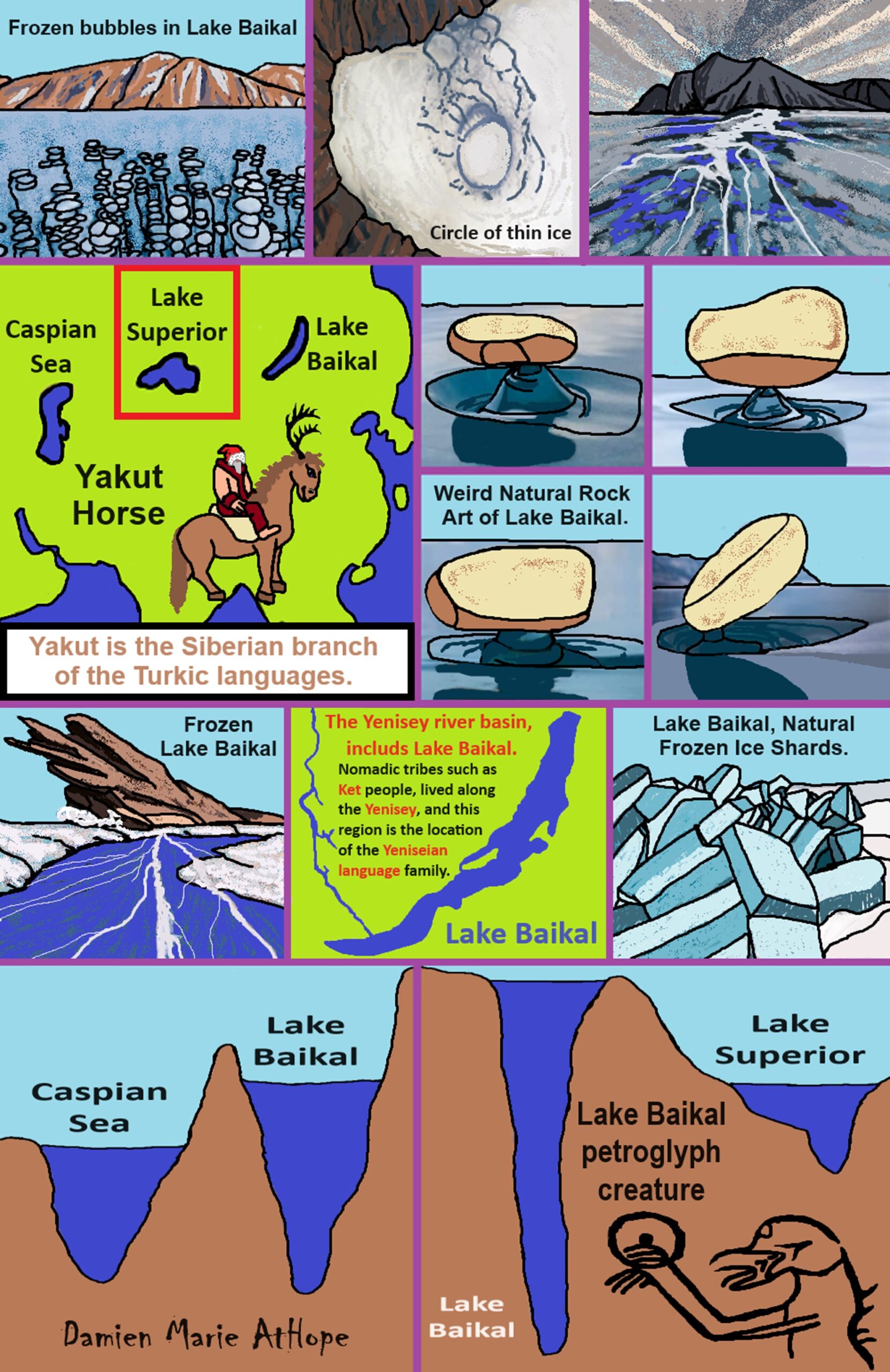
People reached Lake Baikal Siberia around 25,000 years ago. They (to Damien) were likely Animistic Shamanists who were also heavily totemistic as well. Being animistic thinkers they likely viewed amazing things in nature as a part of or related to something supernatural/spiritual (not just natural as explained by science): spirit-filled, a sprit-being relates to or with it, it is a sprit-being, it is a supernatural/spiritual creature, or it is a great spirit/tutelary deity/goddess-god. From there comes mythology and faith in things not seen but are believed to somehow relate or interact with this “real world” we know exists.
Both areas of Lake Baikal, one on the west side with Ancient North Eurasian culture and one on the east side with Ancient Northern East Asian culture (later to become: Ancient Northeast Asian culture) areas are the connected areas that (to Damien) are the origin ancestry religion area for many mythologies and religious ideas of the world by means of a few main migrations and many smaller ones leading to a distribution of religious ideas that even though are vast in distance are commonly related to and centering on Lake Baikal and its surrounding areas like the Amur region and Altai Mountains region.
“Lakes are often mysterious bodies of water, especially if they are very deep or surrounded by mountains. No wonder legends and mysteries thrive about them, including monsters that supposedly lurk in their bottomless depths.” ref
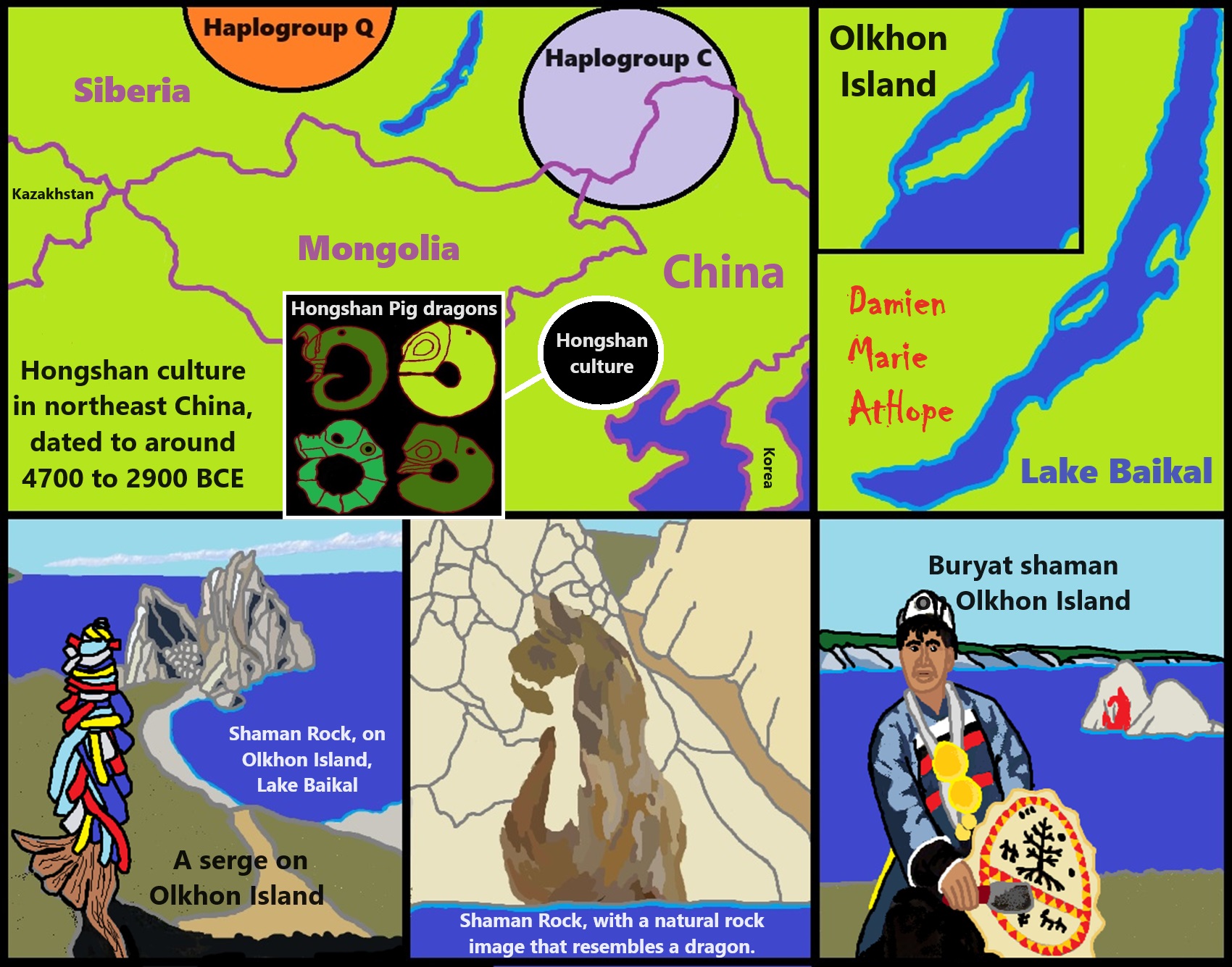
People may have first seen the Shaman Rock with the natural brown rock formation resembling a dragon between 30,000 to 25,000 years ago.

Postglacial genomes from foragers across Northern Eurasia reveal prehistoric
mobility associated with the spread of the Uralic and Yeniseian languages
Abstract
“The North Eurasian forest and forest-steppe zones have sustained millennia of sociocultural connections among northern peoples. We present genome-wide ancient DNA data for 181 individuals from this region spanning the Mesolithic, Neolithic, and Bronze Age. We find that Early to Mid-Holocene hunter-gatherer populations from across the southern forest and forest-steppes of Northern Eurasia can be characterized by a continuous gradient of ancestry that remained stable for millennia, ranging from fully West Eurasian in the Baltic region to fully East Asian in the Transbaikal region. In contrast, cotemporaneous groups in far Northeast Siberia were genetically distinct, retaining high levels of continuity from a population that was the primary source of ancestry for Native Americans. By the mid-Holocene, admixture between this early Northeastern Siberian population and groups from Inland East Asia and the Amur River Basin produced two distinctive populations in eastern Siberia that played an important role in the genetic formation of later people. Ancestry from the first population, Cis-Baikal Late Neolithic-Bronze Age (Cisbaikal_LNBA), is found substantially only among Yeniseian-speaking groups and those known to have admixed with them. Ancestry from the second, Yakutian Late Neolithic-Bronze Age (Yakutia_LNBA), is strongly associated with present-day Uralic speakers. We show how Yakutia_LNBA ancestry spread from an east Siberian origin ~4.5kya, along with subclades of Y-chromosome haplogroup N occurring at high frequencies among present-day Uralic speakers, into Western and Central Siberia in communities associated with Seima-Turbino metallurgy: a suite of advanced bronze casting techniques that spread explosively across an enormous region of Northern Eurasia ~4.0kya. However, the ancestry of the 16 Seima-Turbino-period individuals–the first reported from sites with this metallurgy–was otherwise extraordinarily diverse, with partial descent from Indo-Iranian-speaking pastoralists and multiple hunter-gatherer populations from widely separated regions of Eurasia. Our results provide support for theories suggesting that early Uralic speakers at the beginning of their westward dispersal where involved in the expansion of Seima-Turbino metallurgical traditions, and suggests that both cultural transmission and migration were important in the spread of Seima-Turbino material culture.” ref

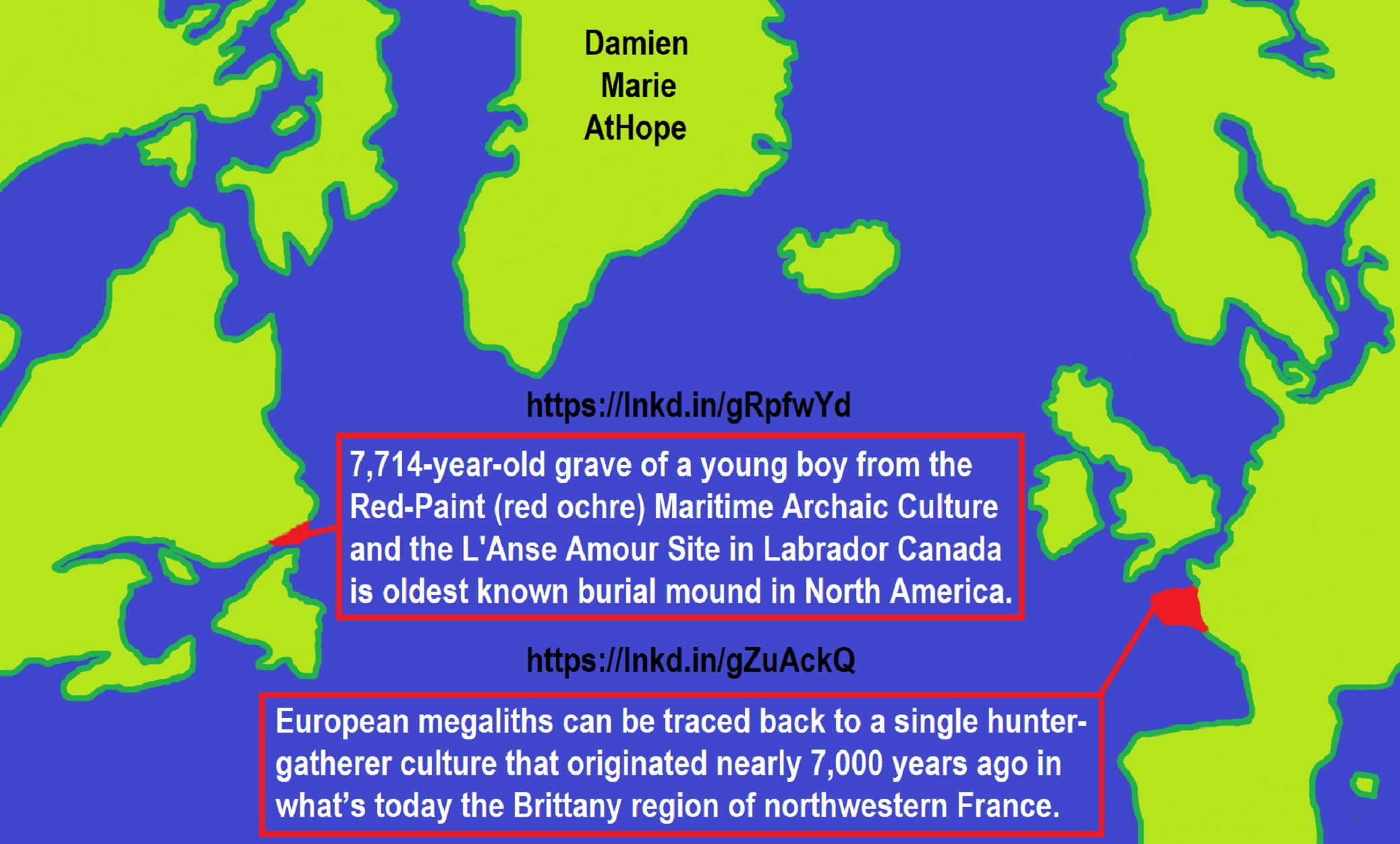
I don’t think they crossed the Atlantic Ocean across the water but by land going both directions from Asia west to Europe as well as east crossing the Bering Strait, between Asia and The Americas.
Megalithic tombs in western and northern Neolithic Europe were linked to a kindred society
“A new phenomenon of constructing distinctive funerary monuments, collectively known as megalithic tombs, emerged around 4500 BCE along the Atlantic façade. The megalithic phenomenon has attracted interest and speculation since medieval times. In particular, the origin, dispersal dynamics, and the role of these constructions within the societies that built them have been debated. We generate genome sequence data from 24 individuals buried in five megaliths and investigate the population history and social dynamics of the groups that buried their dead in megalithic monuments across northwestern Europe in the fourth millennium BCE. Our results show kin relations among the buried individuals and an overrepresentation of males, suggesting that at least some of these funerary monuments were used by patrilineal societies.” ref
“Paleogenomic and archaeological studies show that Neolithic lifeways spread from the Fertile Crescent into Europe around 9000 BCE, reaching northwestern Europe by 4000 BCE. Starting around 4500 BCE, a new phenomenon of constructing megalithic monuments, particularly for funerary practices, emerged along the Atlantic façade. While it has been suggested that the emergence of megaliths was associated with the territories of farming communities, the origin and social structure of the groups that erected them has remained largely unknown. We generated genome sequence data from human remains, corresponding to 24 individuals from five megalithic burial sites, encompassing the widespread tradition of megalithic construction in northern and western Europe, and analyzed our results in relation to the existing European paleogenomic data. The various individuals buried in megaliths show genetic affinities with local farming groups within their different chronological contexts. Individuals buried in megaliths display (past) admixture with local hunter-gatherers, similar to that seen in other Neolithic individuals in Europe. In relation to the tomb populations, we find significantly more males than females buried in the megaliths of the British Isles. The genetic data show close kin relationships among the individuals buried within the megaliths, and for the Irish megaliths, we found a kin relation between individuals buried in different megaliths. We also see paternal continuity through time, including the same Y-chromosome haplotypes reoccurring. These observations suggest that the investigated funerary monuments were associated with patrilineal kindred groups. Our genomic investigation provides insight into the people associated with this long-standing megalith funerary tradition, including their social dynamics.” ref
Radiocarbon dates and Bayesian modeling support maritime diffusion model for megaliths in Europe
“The radiocarbon dates suggest that the first megalithic graves in Europe were closed small structures or dolmens built aboveground with stone slabs and covered by a round or long mound of earth or stone. These graves emerge in the second half of the fifth millennium calibrated years (cal) BC within a time interval of 4794 cal BC to 3986 cal BC (95.4%; 4770 cal BC to 4005 cal BC, 68.2%) (Dataset S3, M7-2 to M29-4), which can be reduced most probably to 200 y to 300 y, in northwest France, the Channel Islands, Catalonia, southwestern France, Corsica, and Sardinia. Taking the associated cultural material into consideration, megalithic graves from Andalusia, Galicia, and northern Italy presumably belong to this first stage (Fig. 3). There are no radiocarbon dates available from the early megalithic graves in these regions, or their calibrated ranges show an onset extending into the fourth millennium cal BC, as is the case for Galicia. Of these regions, northwest France is the only one which exhibits monumental earthen constructions before the megaliths (SI Appendix, Fig. S2).” ref
“The Passy graves in the Paris Basin have no megalithic chamber yet, but are impressive labor-intensive structures with a length of up to 280 m. These graves seem to be the earliest monumental graves in Europe; the first individual buried in the Passy necropolis died in 5061 cal BC to 4858 cal BC (95.4%; 5029 cal BC to 4946 cal BC, 68.2%) (Dataset S3, M1-4). Somewhat later, the first monumental graves emerge in Brittany, and especially in the region of Carnac, in the form of round tumuli covering pit burials, stone cists, and dry-wall chambers. The first building phase of the tumulus St. Michel in Carnac is dated to the time interval 4782 cal BC to 4594 cal BC (95.4; 4724 cal BC to 4618 cal BC, 68.2%) (Dataset S3, M4-2 to M4-4). The earliest megalithic grave chambers in Brittany, such as Tumiac, Kervinio, Castellic, St. Germain, Manio 5, Mané Hui, and Kerlescan (14–16), emerge within this horizon as an architectonic feature of monumental long and round mounds. For these early megaliths, no radiocarbon determinations are available. It is only possible to limit the time interval of construction to the Ancient Castellic horizon based on the typochronological considerations of the grave goods and according to Ancient Castellic contexts with associated radiocarbon results ranging from 4794 cal BC to 3999 cal BC (95.4%; 4770 cal BC to 4034 cal BC, 68.2%) (Dataset S3, M7-2 to M7-7).” ref
“In the Seine-Yonne basin at around 4500 B.C. numerous cemeteries appeared, including giant “enclosures” which as a funerary manifestation would have no later equivalent in Europe. These constructions, whether tumuli, palisade enclosures, or mixed systems, sometimes exceed 300 m in length but contain very few burials. Beyond the classic interpretation, which sees high investment in a few individuals as reflecting a hierarchical society, structural analysis of these cemeteries shows the repetition of an elementary module, associated with consistent attributes, evoking hunting and more broadly, the wild. An exercise of association and exclusion brings into play the morphology and arrangements of the monuments, the gender of the inhumed individuals and their attributes. In the male monuments, a central figure is thus distinguished, sometimes with original physical characteristics and accompanied by an enigmatic insignia: a pointed bone instrument with a wide base, trivially called an “Eiffel Tower”. This figure is surrounded by other individuals interpreted as hunters on the basis of the accompanying objects. Other individuals probably served as no more than passive figurants, rather like foils. In any case, the monumental cemeteries of the 5th millennium correspond to the earliest human groups for which we can identify diverse and repetitive statuses.” ref
No ‘lost tribes’ or aliens: what ancient DNA reveals about American prehistory
“New genetics research settles questions about the peoples of Newfoundland and Labrador. Genetic Discontinuity between the Maritime Archaic and Beothuk Populations in Newfoundland, Canada which addresses the genetic diversity within three different ancient groups who lived in Newfoundland and Labrador. One reason this region is of particular interest is that it’s on the furthest northeastern margin of North America and so was one of the last areas in the Americas to be peopled. It appears to have been occupied successively by three culturally distinct groups beginning about 10,000 years ago in Labrador and 6,000 years ago in Newfoundland: the Maritime Archaic, the Paleo-Inuit (also referred to as the Paleo-Eskimo), and the indigenous peoples that Europeans called the Beothuk. Today the region is home to several indigenous groups, including the Inuit, the Innu, the Mi’kmaq and the Southern Inuit of NunatuKavut.” ref
“The members of the Maritime Archaic tradition created the oldest known burial mounds in North America (dating to 7,714 years ago) and subsisted upon coastal marine resources. Approximately 3,400 years ago they seem to have abandoned Newfoundland, either in response to the appearance of Paleo-Inuit in the region or because of climate changes. The Paleo-Inuit’s presence on the island overlapped with the peoples referred to as the Beothuk beginning around 2,000 years ago. The Beothuk encountered European settlers in 1500 AD, and in response to their presence gradually moved to the interior of the island, where their populations declined. Apart from that single exception, the Maritime Archaic, Paleo-Inuit, and Beothuk are clearly genetically distinctive from one another. However, it’s important to note that this study was done on mitochondrial DNA, which is exclusively matrilineally inherited, and so we can only say that the three groups were not maternally related.” ref
“In the case of Newfoundland, the three groups were genetically distinct; they do not share any maternal haplogroups except for haplogroup X2a, lineages of which were found in both the Maritime Archaic and Beothuk. (The presence of haplogroup X2a in North American populations has sometimes been cited as evidence for European ancestry in ancient Americans. If you’re interested in why I and most other geneticists specializing in Native American populations disagree with that, you can read about it here).” ref
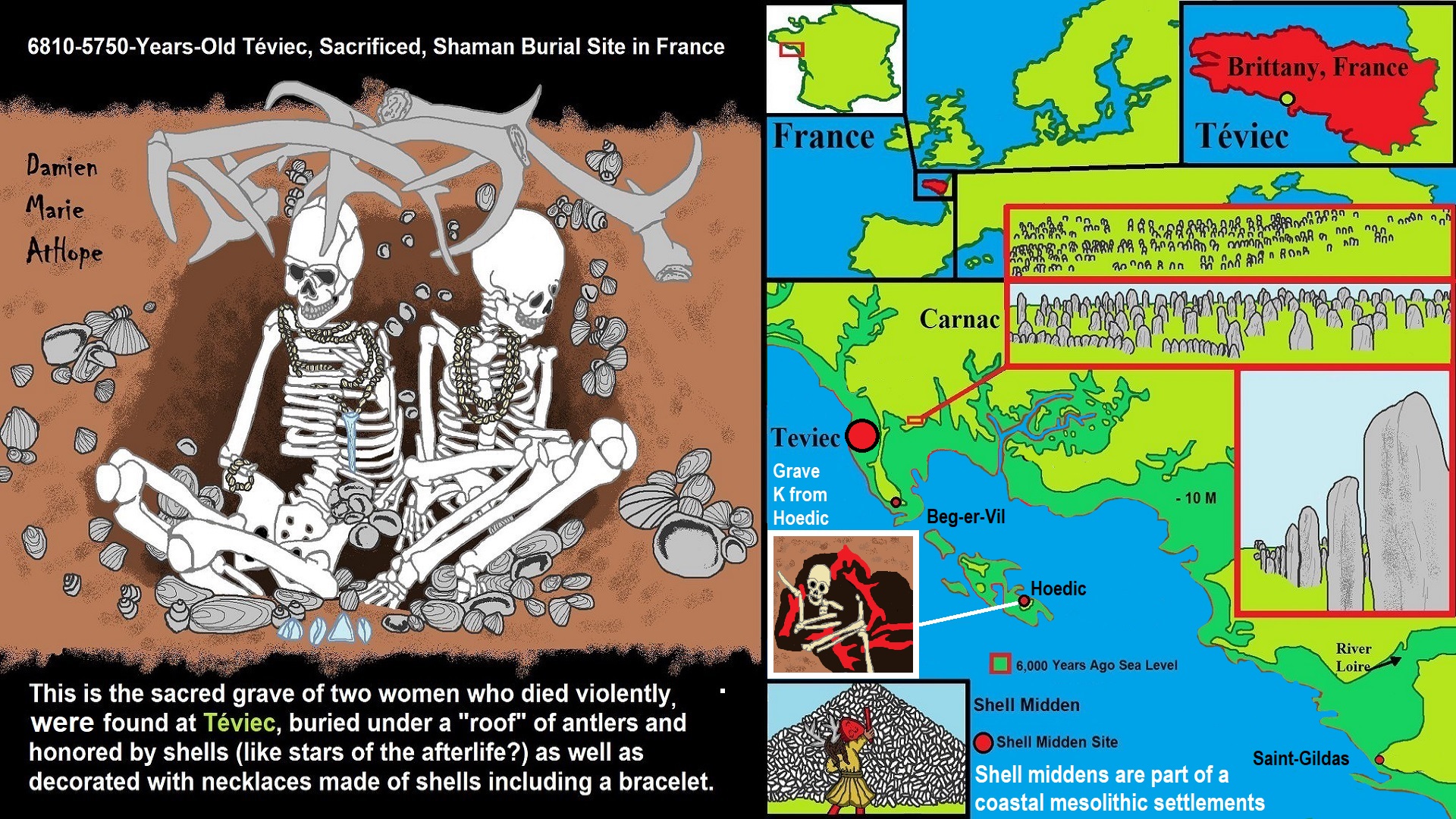
6810-5750-Years-Old Teviec, Sacrificed, Shaman Burial Site in France
This is the sacred grave of two women who died violently, were found at Teviec, buried under a “roof” of antlers and honored by shells (like stars of the afterlife?) as well as decorated with necklaces made of shells including a bracelet. ref
“The island is one of only a few known Mesolithic sites in Brittany, along with Pointe de la Torche, Hoëdic and Beg er Vil on the Quiberon peninsula. During the Mesolithic period, the sea level was much lower and it was possible to walk from France to England, and Téviec was situated in a lagoon.” ref
“Extensive middens were found near places of habitation on the island, containing the remains of shellfish, crustaceans, squid, fish, birds, cetaceans, and terrestrial mammals including wild boar, red deer, roe deer, dogs, and so on. The hunter-gatherers of Téviec buried their own dead in the middens. This helped to preserve the graves, as the carbonates from the shells in the middens insulated human bones from the acid soil.” ref
“Many tools made of bone and antler were found along with numerous flint microliths. They were originally believed to date to between 6740 and 5680 years BP. This indicates a longer occupation than previously thought, with its end coming at the beginning of the Neolithic period. Ten multiple graves were discovered at Téviec containing a total of 23 individuals, including adults and children.” ref
“Some of the remains were scattered between different locations. Several of those interred appear to have died violent deaths. One individual was found to have a flint arrowhead stuck in a vertebra. In another grave, the skeletons of two women aged 25–35, dubbed the “ladies of Téviec”, were found with signs of violence on both. One had sustained five blows to the head, two of which would have been fatal, and had received at least one arrow shot between the eyes. The other had also traces of injuries. However, this diagnosis is disputed by some archaeologists, who have suggested that the weight of earth above the grave may have been responsible for damaging the skeletons.” ref
“The bodies had been buried with great care in a pit that was partly dug into the ground and covered over with debris from the midden. They had been protected by a roof made of antlers and provided with a number of grave goods including pieces of flint and boar bones, and jewelry made of seashells drilled and assembled into necklaces, bracelets, and ringlets for the legs. The grave assemblage was excavated from the site in one piece and is now on display at the Muséum de Toulouse, where its restoration in 2010 earned a national award.” ref

Indigenous Religion and Monuments of the Land: Ancient Earthworks/Rockworks; Rings and Mounds in Canada:
*Rings, such as medicine wheels
*Mounds, such as burial mounds, temple mounds, platform (like elite housing or ritual ceremonies) mounds, and effigy mounds

ref, ref, ref, ref, ref, ref, ref, ref, ref, ref, ref, ref, ref, ref, ref, ref, ref
- Medicine Wheel
- Serpent Mound
- Mesa Verde
- Chaco Canyon
- Casas Grandes/Paquime
- Ciudad Perdida “lost city”; Teyuna
- Ingapirca “Inca”
- Chavín de Huántar “pre-Inca”
- Sacred City of Caral-Supe *Caral culture developed between 3000 – 1800 BCE*
- Machu Picchu
- Nazca Lines
- Sacsayhuamán
- Tiwanaku/Tiahuanaco
- Atacama Giant/Lines
- Pucará de Tilcara “pre-Inca”

My Speculations are in Comparative Mythologies?
For instance, the mytheme of an ancient belief that is seemingly shared though changed and adapted, a fundamental generic unit of narrative structure seems to be shared a common relation with mountains/ancestors/gods or sacred animals with Sacred Mounds, Mountains, Kurgans, and Pyramids.
Sacred Mounds, Mountains, Kurgans, and Pyramids may hold deep Mythology connections?

ref, ref, ref, ref, ref, ref, ref, ref, ref, ref, ref
“The earth-diver is a common character in various traditional creation myths. In these stories, a supreme being usually sends an animal (most often a type of bird, but also crustaceans, insects, and fish in some narratives) into the primal waters to find bits of sand or mud with which to build habitable land.” ref
Axis Mundi Mythology– cosmic axis, world axis, world pillar, center of the world, mound/mountain of creation, or “World/Cosmic tree,” or “Eagle and Serpent tree.” ref, ref
“The World Turtle, also called the Cosmic Turtle or the World-bearing Turtle, is a mytheme of a giant turtle (or tortoise) supporting or containing the world. It occurs in Hindu mythology, Chinese mythology, and the mythologies of some of the indigenous peoples of the Americas.” ref
“Chucalissa, Mississippian culture Mounds in Memphis, art shows all the elements involved in the Path of Souls death journey, a widely held belief system among the mound builders of America.” ref
“Interpretation of southeastern Native cosmology, showing the tripartite division of the world. The axis mundi is depicted as a tree or post connecting the fire symbol of this world, the sun symbol of the upper world, and the ‘swastika’ symbol of the lower world.” ref
“It should be remembered that the Mississippian culture that built Cahokia may have considered a cedar tree or a striped cedar pole to be a symbol of the Axis Mundi (also called the cosmic axis, world axis, world pillar, the center of the world, or world tree – has been greatly extended to refer to any mythological concept representing “the connection between Heaven and Earth” or the “higher and lower realms), the pillar connecting the above, middle, & below worlds, & around which the cosmos turns An American Yggdrasil (Norse tree of life). Some work has gone into reconstructing the woodhenge, and it is one of the sites around Cahokia that you can visit today. (The Solar Calendar of Woodhenge in Cahokia | Native America: Cities of the Sky).” – Vulpine Outlaw @Rad_Sherwoodism
“Items adduced as examples of the axis mundi by comparative mythologists include plants (notably a tree but also other types of plants such as a vine or stalk), a mountain, a column of smoke or fire, or a product of human manufacture (such as a staff, a tower, a ladder, a staircase, a maypole, a cross, a steeple, a rope, a totem pole, a pillar, a spire). Its proximity to heaven may carry implications that are chiefly religious (pagoda, temple mount, minaret, church) or secular (obelisk, lighthouse, rocket, skyscraper). The image appears in religious and secular contexts. The axis mundi symbol may be found in cultures utilizing shamanic practices or animist belief systems, in major world religions, and in technologically advanced “urban centers.” ref
Do we know what the symbols represent?
“Yes. It’s a bit more than I’d want to post on TwiX right now. It’s showing the 3-part universe, an upper, lower, and middle world, & the Milky Way is shown as well as Orion the Hand Constellation, Scorpius the ruler of the underworld, and Cygnus, the Judge. Also the main powers of the upper & lower worlds.” – Gregory L Little, Ed.D. @DrGregLittle2
Gregory L Little, Ed.D. BA/MS Psychology, Ed.D. Counseling/Ed. Psych Author since ’84 (70+ books/workbooks). Mound Builder Society: Be Kind; Respect Everything; Honor the Ancient Ones.
EVIDENCE FOR STEPPED PYRAMIDS OF SHELL IN THE WOODLAND PERIOD OF EASTERN NORTH AMERICA
FOLKLORE PARALLELS BETWEEN SIBERIA AND SOUTH ASIA AND THE MYTHOLOGY OF THE EURASIAN STEPPES*
“According to the myth about the origin of man recorded among the people of Eastern Europe and Siberia, the creator set a dog to guard the half-made human figures, but the antagonist bribed the guard and spoiled the creation, making humans vulnerable to disease. The creator told the dog to become the servant of man. Texts recorded in India (mostly among the Munda-speaking groups), the Dards of the Hindu Kush and the Abkhasians, though partly similar to the Northern Eurasian ones, do not share some important details: the antagonist is a horse, it tried to destroy man but a dog drove it away. In the Mongolian (more precisely, the Oirat) version, a cow acts instead of a horse, but in other respects, this variant is similar to the Abkhasian ones. Negative associations related to the horse are rather widespread
in Europe and Central Asia. Stories about the creation of man recorded in northern and southern Eurasia stemmed from the anthropogenic myth that was known to the Indo-Europeans of the Bronze Age. South Asia and the European–Siberian zone also share other tales, in particular the Earth-diver myth. Their analysis opens possibilities for reconstructing the early mythology of the inhabitants of the Eurasian steppe.” ref
Comparative Mythology
“Since the term ‘Ancient North Eurasian’ refers to a genetic bridge of connected mating networks, scholars of comparative mythology have argued that they probably shared myths and beliefs that could be reconstructed via the comparison of stories attested within cultures that were not in contact for millennia and stretched from the Pontic–Caspian steppe to the American continent. The mytheme of the dog guarding the Otherworld possibly stems from an older Ancient North Eurasian belief, as suggested by similar motifs found in Indo-European, Native American and Siberian mythology. In Siouan, Algonquian, Iroquoian, and in Central and South American beliefs, a fierce guard dog was located in the Milky Way, perceived as the path of souls in the afterlife, and getting past it was a test.” ref
“The Siberian Chukchi and Tungus believed in a guardian-of-the-afterlife dog and a spirit dog that would absorb the dead man’s soul and act as a guide in the afterlife. In Indo-European myths, the figure of the dog is embodied by Cerberus, Sarvarā, and Garmr. In Zoroastrianism, two four-eyed dogs guard the bridge to the afterlife called Chinvat Bridge. Anthony and Brown note that it might be one of the oldest mythemes recoverable through comparative mythology.” ref
“A second canid-related series of beliefs, myths and rituals connected dogs with healing rather than death. For instance, Ancient Near Eastern and Turkic–Kipchaq myths are prone to associate dogs with healing and generally categorised dogs as impure. A similar myth-pattern is assumed for the Eneolithic site of Botai in Kazakhstan, dated to 3500 BC, which might represent the dog as absorber of illness and guardian of the household against disease and evil. In Mesopotamia, the goddess Nintinugga, associated with healing, was accompanied or symbolized by dogs. Similar absorbent-puppy healing and sacrifice rituals were practiced in Greece and Italy, among the Hittites, again possibly influenced by Near Eastern traditions.” ref
Earth-diver myth
(creation myth or cosmogonic myth, which is a type of cosmogony,
a symbolic narrative of how the world began and how people first came to inhabit it.)
“The earth-diver is a common character in various traditional creation myths. In these stories, a supreme being usually sends an animal (most often a type of bird, but also crustaceans, insects, and fish in some narratives) into the primal waters to find bits of sand or mud with which to build habitable land. Some scholars interpret these myths psychologically while others interpret them cosmogonically. In both cases, emphasis is placed on beginnings emanating from the depths.” ref
“According to Gudmund Hatt and Tristram P. Coffin, Earth-diver myths are common in Native American folklore, among the following populations: Shoshone, Meskwaki, Blackfoot, Chipewyan, Newettee, Yokuts of California, Mandan, Hidatsa, Cheyenne, Arapaho, Ojibwe, Yuchi, and Cherokee. American anthropologist Gladys Reichard located the distribution of the motif across “all parts of North America”, save for “the extreme north, northeast, and southwest.” ref
“In a 1977 study, anthropologist Victor Barnouw surmised that the earth-diver motif appeared in “hunting-gathering societies“, mainly among northerly groups such as the Hare, Dogrib, Kaska, Beaver, Carrier, Chipewyan, Sarsi, Cree, and Montagnais. Similar tales are also found among the Chukchi and Yukaghir, the Tatars, and many Finno-Ugric traditions, as well as among the Buryat and the Samoyed. In addition, the earth-diver motif also exists in narratives from Eastern Europe, namely Romani, Romanian, Slavic (namely, Bulgarian, Polish, Ukrainian, and Belarusian), and Lithuanian mythological traditions.” ref
“The pattern of distribution of these stories suggest they have a common origin in the eastern Asiatic coastal region, spreading as peoples migrated west into Siberia and east to the North American continent. However, there are examples of this mytheme found well outside of this boreal distribution pattern, for example the West African Yoruba creation myth of Ọbatala and Oduduwa. Characteristic of many Native American myths, earth-diver creation stories begin as beings and potential forms linger asleep or suspended in the primordial realm. The earth-diver is among the first of them to awaken and lay the necessary groundwork by building suitable lands where the coming creation will be able to live. In many cases, these stories will describe a series of failed attempts to make land before the solution is found.” ref
“Among the indigenous peoples of the Americas, the earth-diver cosmogony is attested in Iroquois mythology: a female sky deity falls from the heavens, and certain animals, the beaver, the otter, the duck, and the muskrat dive in the waters to fetch mud to construct an island. In a similar story from the Seneca, people lived in a sky realm. One day, the chief’s daughter was afflicted with a mysterious illness, and the only cure recommended for her (revealed in a dream) was to lie beside a tree and to have it be dug up. The people do so, but a man complains that the tree was their livelihood, and kicks the girl through the hole. She ends up falling from the sky to a world of only water, but is rescued by waterfowl.” ref
“A turtle offers to bear her on its shell, but asked where would be a definitive dwelling place for her. They decide to create land, and the toad dives into the depths of the primal sea to get pieces of soil. The toad puts it on the turtle’s back, which grows larger with every deposit of soil. In another version from the Wyandot, the Wyandot lived in heaven. The daughter of the Big Chief (or Mighty Ruler) was sick, so the medicine man recommends that they dig up the wild apple tree that stands next to the Lodge of the Mighty Ruler, because the remedy is to be found on its roots.” ref
“However, as the tree has been dug out, the ground begins to sink away, and the treetops catch and carry down the sick daughter with it. As the girl falls from the skies, two swans rescue her on their backs. The birds decide to summon all the Swimmers and the Water Tribes. Many volunteer to dive into the Great Water to fetch bits of earth from the bottom of the sea, but only the toad (female, in the story) is the one successful.” ref
GENES AND MYTHS: ANCIENT MAL’TA DNA AND THE EARTH-DIVER MYTHOLOGICAL MOTIF
“Earth-Diver is one of the most widely-distributed and well-studied cosmological myths. Found in mostly Uralic-speaking Eastern Europe, in Siberia, in Munda-speaking Northeast India and North America, its action is set in post-diluvial times when a demiurge sends various creatures to bring a piece of mud from the bottom of the ocean. The first creature fails, but the second one succeeds. Importantly, it’s the least likely creature that succeeds, while the more obvious favorite fails. A loon is a much better diver than a duck but it’s the duck that succeeds. In the end, the demiurge blows the earth out of the tiny piece of mud and restores life on it. Depending on the region, the diving creatures are different – in Eurasia it’s waterfowl birds – loon and duck, in North America it’s amphibians such as turtle or frog, animals such as otter or beaver or waterbirds, in Northeast India and the American Southwest – it’s arthropods.” ref
“The Initial Stages of Evolution of Uralic-Speakers: Evidence from a Mythological Reconstruction (Proto-Uralic Cosmogonic Myth) have suggested that the Earth-Diver motif is the folkloric manifestation of a more comprehensive system of beliefs related to the experiences of a shamanic flight in Northern Eurasian and Amerindian cultures. Siberian shamans liken themselves to waterfowl birds flying between worlds in search of the soul of their patient and they manipulate waterfowl figurines during their shamanic seances. Remarkably, very similar figurines are found at the 24,000-year-old Mal’ta archaeological site in South Siberia (see one on the left made out of a mammoth tusk), and Napol’skikh, in his 1991 book as well as in a recent talk (see video in Russian, roughly from 11:40 on) proposed that the Mal’ta people possessed the “cult of a waterfowl” and told the Earth-Diver myth. This means that the Earth-Diver motif may go back to pre-LGM times.” ref
“Mal’ta has recently made headlines thanks to the sequencing of the genome of a 4-year-old boy found at this site. The DNA sample fell in-between West Eurasians and Amerindians, without any special connection to East Asians, and showed typical West Eurasian mtDNA and Y-DNA haplogroups, namely U and R, respectively. They are sister lineages of widely distributed in the Americas hg B (mtDNA) and hg Q (Y-DNA). It appears that, in pre-LGM times, Amerindians and West Eurasians formed a genetic continuum and that modern East Asians did not yet emerge as a distinct population. This finding may put the distribution of the Earth-Diver myth into a new perspective. Per Davidski’s request, adduce the map of the distribution of the Earth-Diver motif in Eurasia and North America (see the shaded areas on the left).” ref
“One should not expect a perfect fit between the distribution of myths and genes but the Earth-Diver distribution is rather clearly demarcated on a worldwide scale and does show continuity between West Eurasia and North America. The motif is notably absent from Western Europe – precisely the area that was covered with the glacier from 25,000 to 14,000 years ago – and from Beringia (Paleoasiatic peoples such as Chukchees and Koryaks as well as Eskimos don’t tell earth-diver stories), which may have been blocked by ice as well. Its presence in the Balkans is a due to relatively recent events such as Turkic and Avar migrations across the southern European steppe.” ref
“According to Napol’skikh’s motif phylogeny (on the left), the Earth-Diver myth has gone through 3 evolutionary stages – MNP-0, MNP-1 and MNP-2. At MNP-0, any creature (and any number of creatures) could become the demiurge’s helper as long as the least likely creature succeeded. At MNP-1, the plot crystallized around a pair of waterfowls in Siberia and Western North America and a pair of animals in Eastern North America. At MNP-3, one of the creatures dropped off and the demiurge used the help of only one helper. The “cladistics” of the myth is, therefore, rather simple: the dynamic and variable ancestral forms crystallize into progressively fewer characters.” ref
“As the detailed maps of motif and submotif distribution show, North America and Northern Eurasia share MNP-2 but then the rest of the variation is continent-specific. Eurasia has a number of clearly derived variants that are missing from the Americas, while America has a number variants not seen in Eurasia. Napol’skikh observes that stage MNP-0 is better represented in North America – the region that tends to have more archaic versions of the motif and more basal motif diversity (not just waterfowls, but animals, too; not just two creatures but many, etc.). Remarkably, the use of arthropods by the demiurge is a trait shared by Munda-speaking Northeast Indians (see the Berezkin map of Eurasia above) and the Muskogean-speaking Amerindians from the Southeast, both areas being the southernmost extremes of the Earth-Diver distribution. As the Mal’ta boy is re-writing the prehistory of Eurasia, opportunities are growing for cross-disciplinary integration that would tie together genes and culture into a coherent story.” ref
Folklore Parallels Between Siberia And South Asia And The Mythology Of The Eurasian Steppes
“According to the myth about the origin of man recorded among the people of Eastern Europe and Siberia, the creator set a dog to guard the half-made human figures, but the antagonist bribed the guard and spoiled the creation, making humans vulnerable to disease. The creator told the dog to become the servant of man. Texts recorded in India (mostly among the Munda-speaking groups), the Dards of the Hindu Kush and the Abkhasians, though partly similar to the Northern Eurasian ones, do not share some important details: the antagonist is a horse, it tried to destroy man but a dog drove it away. In the Mongolian (more precisely, the Oirat) version, a cow acts instead of a horse, but in other respects this variant is similar to the Abkhasian ones. Negative associations related to the horse are rather widespread in Europe and Central Asia. Stories about the creation of man recorded in northern and southern Eurasia stemmed from the anthropogenic myth that was known to the Indo-Europeans of the Bronze Age. South Asia and the European–Siberian zone also share other tales, in particular the Earth-diver myth. Their analysis opens possibilities for reconstructing the early mythology of the inhabitants of the Eurasian steppe.” ref
Diver-Myths
“Scientific evidence has shown that at one point parts of the earth that are now dry were covered by water. Many myths allude to this fact by imagining a world once covered by water. Many myths, called diver-myths (Long 188), consisted of a being diving into the water that covers the earth to retrieve some earth. The earth brought to the surface became the land we know today. Other stories had the mud brought to the surface in a different way, but many had the common element of some earth being brought to the surface of the water and growing until it became the Earth.” ref
“According to the Iroquois Native Americans water animals inhabited the Earth before there was land. When a Sky Woman fell from her home above they caught her and dove into the seas to bring up mud. This mud they spread onto the back of Big Turtle. There it began to grow until it became North America.” ref
“The Japanese creation myth painted a picture of a muddy ocean which covered the world at the beginning of time. A god and goddess, Izanagi and Izanami, became curious about what was beneath the ocean. Izanagi took his staff and threw it into the ocean. As he lifted it back up some lumps of earth fell off into the water. These became the islands of Japan. No being dove beneath the waters to find mud, but the element of earth being covered by water and a being bringing the earth up is there.” ref
“The creation myth of Christians and Jews does not tell of God diving into the water to bring up mud, but Genesis 1:2 says Òthe Spirit of God was hovering over the waters.Ó Therefore according to the Torah and Bible the Earth was once covered entirely by water.” ref
Power of Myths
“The most obvious function of myths is the explanation of facts, whether natural or cultural. One North American Indian (Abenaki) myth, for example, explains the origin of corn (maize): a lonely man meets a beautiful woman with long, fair hair; she promises to remain with him if he follows her instructions; she tells him in detail how to make a fire and, after he has done so, she orders him to drag her over the burned ground; as a result of these actions, he will see her silken hair (viz., the cornstalk) reappear, and thereafter he will have corn seeds for his use. Henceforth, whenever Abenaki Indians see corn (the woman’s hair), they know that she remembers them.” ref
“Obviously, a myth such as this one functions as an explanation, but the narrative form distinguishes it from a straightforward answer to an intellectual question about causes. The function of explanation and the narrative form go together, since the imaginative power of the myth lends credibility to the explanation and crystallizes it into a memorable and enduring form. Hence myths play an important part in many traditional systems of education. Many myths explain ritual and cultic customs. According to myths from the island of Ceram (in Indonesia), in the beginning life was not complete, or not yet “human”: vegetation and animals did not exist, and there was neither death nor sexuality. In a mysterious manner Hainuwele, a girl with extraordinary gift-bestowing powers, appeared.” ref
“The people killed her at the end of their great annual celebration, and her dismembered body was planted in the earth. Among the species that sprang up after this act of planting were tubers—the staple diet of the people telling the myth. With a certain circularity frequent in mythology, the myth validates the very cultic celebration mentioned in the myth. The cult can be understood as a commemoration of those first events. Hence, the myth can be said to validate life itself together with the cultic celebration. Comparable myths are told in a number of societies where the main means of food production is the cultivation of root crops; the myths reflect the fact that tubers must be cut up and buried in the earth for propagation to take place.” ref
“Ritual sacrifices are typical of traditional peasant cultures. In most cases such customs are related to mythical events. Among important themes are the necessity of death (e.g., the grain “dies” and is buried, only to yield a subsequent harvest), a society’s cyclic renewal of itself (e.g., New Year’s celebrations), and the significance of women and sexuality. New Year’s celebrations, often accompanied by a temporary abandonment of all rules, may be related to or justified by mythical themes concerning a return to chaos and a return of the dead.” ref
“In every mythological tradition one myth or cluster of myths tends to be central. The subject of the central mythology is often cosmogony (origin of the cosmos). In many of those ceremonies that each society has developed as a symbol of what is necessary to its well-being, references are made to the beginning of the world. Examples include the enthronements of kings, which in some traditions (as in Fiji or ancient India) are associated with a creation or re-creation of the world. Analogously, in ancient Mesopotamia the creation epic Enuma elish, which was read each New Year at Babylon, celebrated the progress of the cosmos from initial anarchy to government by the kingship of Marduk; hence the authority of earthly rulers, and of earthly monarchy in general, was implicitly supported and justified.” ref
“Ruling families in ancient civilizations frequently justified their position by invoking myths—for example, that they had divine origins. Examples are known from imperial China, pharaonic Egypt, the Hittite empire, Polynesia, the Inca empire, and India. Elites have also based their claims to privilege on myths. The French historian of ancient religion Georges Dumézil was the pioneer in suggesting that the priestly, warrior, and producing classes in ancient Indo-European societies regarded themselves as having been ordained to particular tasks by virtue of their mythological origins. And in every known cultural tradition there exists some mythological foundation that is referred to when defending marriage and funerary customs.” ref
“Creation myths play a significant role in healing the sick; they are recited (e.g., among the Navajo people of North America) when an individual’s world—that is to say, the person’s life—is in jeopardy. Thus, healing through recitation of a cosmogony is one example of the use of myth as a magical incantation. Another example is the case of Icelandic poets, who, in the singing of the episode in Old Norse mythology in which the god Odin wins for gods and humans the “mead of song” (a drink containing the power of poetic inspiration), can be said to be celebrating the origins of their own art and, hence, renewing it.” ref
“Modern science did not evolve in its entirety as a rebellion against myth, nor at its birth did it suddenly throw off the shackles of myth. In ancient Greece the naturalists of Ionia (western Asia Minor), long regarded as the originators of science, developed views of the universe that were in fact very close to the creation myths of their time. Those who laid the foundations of modern science, such as Nicholas of Cusa, Johannes Kepler, Isaac Newton, and Gottfried Leibniz, were absorbed by metaphysical problems of which the traditional, indeed mythological, character is evident. Among these problems were the nature of infinity and the question of the omnipotence of God. The influence of mythological views is seen in the English physician William Harvey’s association of the circulation of the blood with the planetary movements and Charles Darwin’s explanation of woman’s menstrual cycles by the tides of the ocean.” ref


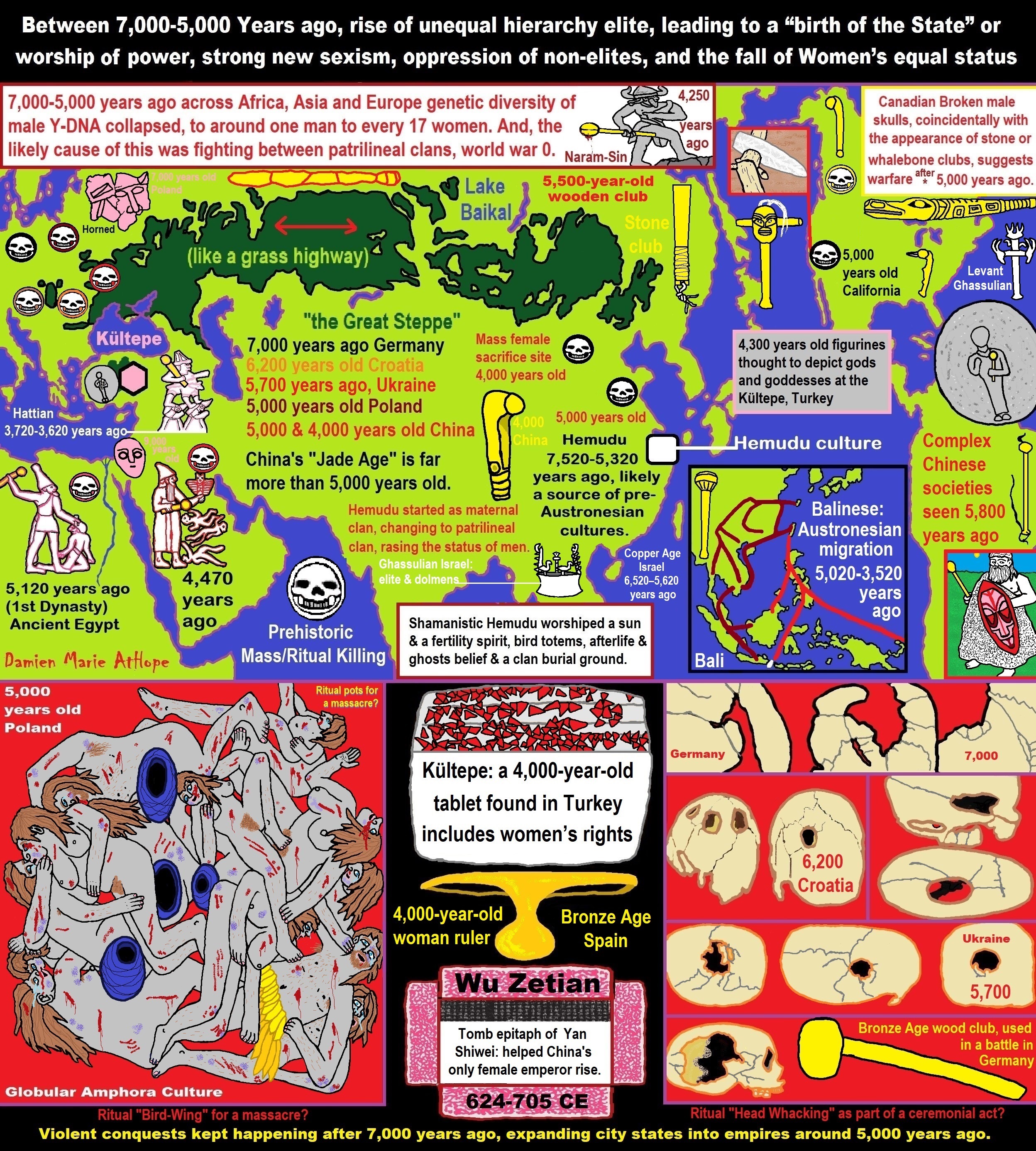
ref, ref, ref, ref, ref, ref, ref, ref, ref, ref, ref, ref, ref, ref, ref, ref, ref, ref, ref, ref, ref, ref, ref, ref, ref, ref, ref, ref, ref, ref, ref, ref, ref, ref, ref, ref, ref, ref, ref, ref, ref, ref, ref, ref, ref, ref, ref, ref, ref, ref, ref, ref, ref, ref, ref, ref, ref, ref, ref, ref, ref, ref, ref, ref, ref, ref, ref, ref, ref, ref, ref, ref, ref, ref, ref, ref, ref, ref, ref, ref, ref, ref, ref, ref, ref, ref, ref, ref, ref, ref
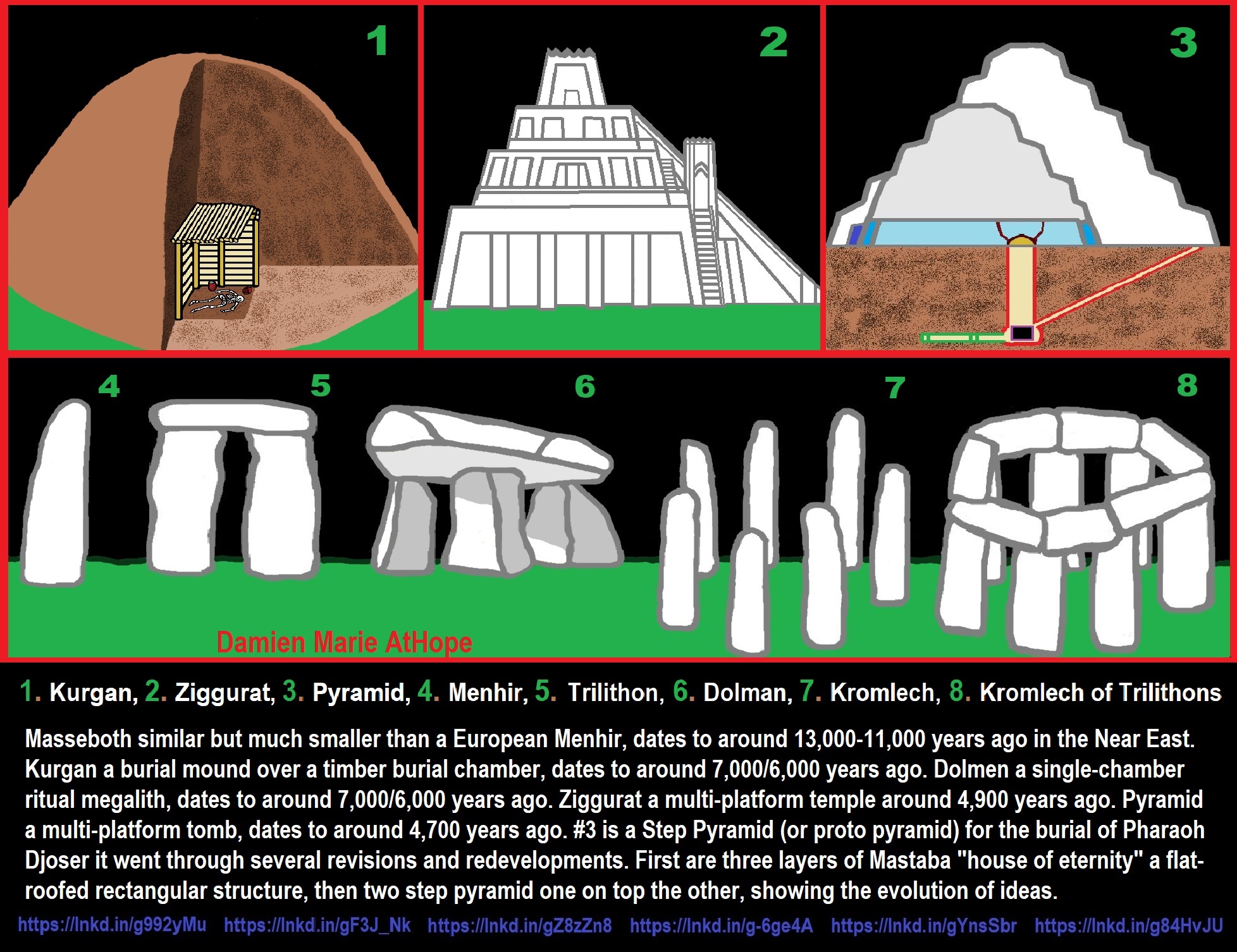
ref, ref, ref, ref, ref, ref, ref, ref, ref, ref, ref, ref
Kurgans 7,000/6,000 years ago/Dolmens 7,000/6,000 years ago: funeral, ritual, and other?
Is there a connection between Dolmans/Kurgans and Ziggurats/Pyramids?
My best Video talking about My thoughts on “Religion and Deity Evolution” with Questions and Answers
“The First Nations of Saskatchewan are: Nêhiyawak (Plains Cree), Nahkawininiwak (Saulteaux), Nakota (Assiniboine), Dakota and Lakota (Sioux), and Denesuline (Dene/Chipewyan).” ref
“Native Americans in Florida are: Ais, Apalachee, Calusa, Creek, Miccosukee, Seminole, Timucua, and Yemassee.” ref
Colonization and Colonialism of Florida, its Indigenous Peoples, and a little on Masculinity (VIDEO)

My favorite “Graham Hancock” Quote?
“In what archaeologists have studied, yes, we can say there is NO Evidence of an advanced civilization.” – (Time 1:27) Joe Rogan Experience #2136 – Graham Hancock & Flint Dibble
Help the Valentine fight against pseudoarchaeology!!!
In a world of “Hancocks” supporting evidence lacking claims, be a “John Hoopes” supporting what evidence explains.
#SupportEvidenceNotWishfullThinking
Graham Hancock: @Graham__Hancock
John Hoopes: @KUHoopes

People don’t commonly teach religious history, even that of their own claimed religion. No, rather they teach a limited “pro their religion” history of their religion from a religious perspective favorable to the religion of choice.

Do you truly think “Religious Belief” is only a matter of some personal choice?
Do you not see how coercive one’s world of choice is limited to the obvious hereditary belief, in most religious choices available to the child of religious parents or caregivers? Religion is more commonly like a family, culture, society, etc. available belief that limits the belief choices of the child and that is when “Religious Belief” is not only a matter of some personal choice and when it becomes hereditary faith, not because of the quality of its alleged facts or proposed truths but because everyone else important to the child believes similarly so they do as well simply mimicking authority beliefs handed to them. Because children are raised in religion rather than being presented all possible choices but rather one limited dogmatic brand of “Religious Belief” where children only have a choice of following the belief as instructed, and then personally claim the faith hereditary belief seen in the confirming to the belief they have held themselves all their lives. This is obvious in statements asked and answered by children claiming a faith they barely understand but they do understand that their family believes “this or that” faith, so they feel obligated to believe it too. While I do agree that “Religious Belief” should only be a matter of some personal choice, it rarely is… End Hereditary Religion!

Animism: Respecting the Living World by Graham Harvey
“How have human cultures engaged with and thought about animals, plants, rocks, clouds, and other elements in their natural surroundings? Do animals and other natural objects have a spirit or soul? What is their relationship to humans? In this new study, Graham Harvey explores current and past animistic beliefs and practices of Native Americans, Maori, Aboriginal Australians, and eco-pagans. He considers the varieties of animism found in these cultures as well as their shared desire to live respectfully within larger natural communities. Drawing on his extensive casework, Harvey also considers the linguistic, performative, ecological, and activist implications of these different animisms.” ref

We are like believing machines we vacuum up ideas, like Velcro sticks to almost everything. We accumulate beliefs that we allow to negatively influence our lives, often without realizing it. Our willingness must be to alter skewed beliefs that impend our balance or reason, which allows us to achieve new positive thinking and accurate outcomes.

My thoughts on Religion Evolution with external links for more info:
- (Pre-Animism Africa mainly, but also Europe, and Asia at least 300,000 years ago), (Pre-Animism – Oxford Dictionaries)
- (Animism Africa around 100,000 years ago), (Animism – Britannica.com)
- (Totemism Europe around 50,000 years ago), (Totemism – Anthropology)
- (Shamanism Siberia around 30,000 years ago), (Shamanism – Britannica.com)
- (Paganism Turkey around 12,000 years ago), (Paganism – BBC Religion)
- (Progressed Organized Religion “Institutional Religion” Egypt around 5,000 years ago), (Ancient Egyptian Religion – Britannica.com)
- (CURRENT “World” RELIGIONS after 4,000 years ago) (Origin of Major Religions – Sacred Texts)
- (Early Atheistic Doubting at least by 2,600 years ago) (History of Atheism – Wikipedia)
“Religion is an Evolved Product” and Yes, Religion is Like Fear Given Wings…
Atheists talk about gods and religions for the same reason doctors talk about cancer, they are looking for a cure, or a firefighter talks about fires because they burn people and they care to stop them. We atheists too often feel a need to help the victims of mental slavery, held in the bondage that is the false beliefs of gods and the conspiracy theories of reality found in religions.
Understanding Religion Evolution:
- Pre-Animism (at least 300,000 years ago)
- Animism (Africa: 100,000 years ago)
- Totemism (Europe: 50,000 years ago)
- Shamanism (Siberia: 30,000 years ago)
- Paganism (Turkey: 12,000 years ago)
- Progressed organized religion (Egypt: 5,000 years ago), (Egypt, the First Dynasty 5,150 years ago)
- CURRENT “World” RELIGIONS (after 4,000 years ago)
- Early Atheistic Doubting (at least by 2,600 years ago)
“An Archaeological/Anthropological Understanding of Religion Evolution”
It seems ancient peoples had to survived amazing threats in a “dangerous universe (by superstition perceived as good and evil),” and human “immorality or imperfection of the soul” which was thought to affect the still living, leading to ancestor worship. This ancestor worship presumably led to the belief in supernatural beings, and then some of these were turned into the belief in gods. This feeble myth called gods were just a human conceived “made from nothing into something over and over, changing, again and again, taking on more as they evolve, all the while they are thought to be special,” but it is just supernatural animistic spirit-belief perceived as sacred.
Quick Evolution of Religion?
Pre-Animism (at least 300,000 years ago) pre-religion is a beginning that evolves into later Animism. So, Religion as we think of it, to me, all starts in a general way with Animism (Africa: 100,000 years ago) (theoretical belief in supernatural powers/spirits), then this is physically expressed in or with Totemism (Europe: 50,000 years ago) (theoretical belief in mythical relationship with powers/spirits through a totem item), which then enlists a full-time specific person to do this worship and believed interacting Shamanism (Siberia/Russia: 30,000 years ago) (theoretical belief in access and influence with spirits through ritual), and then there is the further employment of myths and gods added to all the above giving you Paganism (Turkey: 12,000 years ago) (often a lot more nature-based than most current top world religions, thus hinting to their close link to more ancient religious thinking it stems from). My hypothesis is expressed with an explanation of the building of a theatrical house (modern religions development). Progressed organized religion (Egypt: 5,000 years ago) with CURRENT “World” RELIGIONS (after 4,000 years ago).
Historically, in large city-state societies (such as Egypt or Iraq) starting around 5,000 years ago culminated to make religion something kind of new, a sociocultural-governmental-religious monarchy, where all or at least many of the people of such large city-state societies seem familiar with and committed to the existence of “religion” as the integrated life identity package of control dynamics with a fixed closed magical doctrine, but this juggernaut integrated religion identity package of Dogmatic-Propaganda certainly did not exist or if developed to an extent it was highly limited in most smaller prehistoric societies as they seem to lack most of the strong control dynamics with a fixed closed magical doctrine (magical beliefs could be at times be added or removed). Many people just want to see developed religious dynamics everywhere even if it is not. Instead, all that is found is largely fragments until the domestication of religion.
Religions, as we think of them today, are a new fad, even if they go back to around 6,000 years in the timeline of human existence, this amounts to almost nothing when seen in the long slow evolution of religion at least around 70,000 years ago with one of the oldest ritual worship. Stone Snake of South Africa: “first human worship” 70,000 years ago. This message of how religion and gods among them are clearly a man-made thing that was developed slowly as it was invented and then implemented peace by peace discrediting them all. Which seems to be a simple point some are just not grasping how devastating to any claims of truth when we can see the lie clearly in the archeological sites.
I wish people fought as hard for the actual values as they fight for the group/clan names political or otherwise they think support values. Every amount spent on war is theft to children in need of food or the homeless kept from shelter.
Here are several of my blog posts on history:
- To Find Truth You Must First Look
- (Magdalenian/Iberomaurusian) Connections to the First Paganists of the early Neolithic Near East Dating from around 17,000 to 12,000 Years Ago
- Natufians: an Ancient People at the Origins of Agriculture and Sedentary Life
- Possible Clan Leader/Special “MALE” Ancestor Totem Poles At Least 13,500 years ago?
- Jewish People with DNA at least 13,200 years old, Judaism, and the Origins of Some of its Ideas
- Baltic Reindeer Hunters: Swiderian, Lyngby, Ahrensburgian, and Krasnosillya cultures 12,020 to 11,020 years ago are evidence of powerful migratory waves during the last 13,000 years and a genetic link to Saami and the Finno-Ugric peoples.
- The Rise of Inequality: patriarchy and state hierarchy inequality
- Fertile Crescent 12,500 – 9,500 Years Ago: fertility and death cult belief system?
- 12,400 – 11,700 Years Ago – Kortik Tepe (Turkey) Pre/early-Agriculture Cultic Ritualism
- Ritualistic Bird Symbolism at Gobekli Tepe and its “Ancestor Cult”
- Male-Homosexual (female-like) / Trans-woman (female) Seated Figurine from Gobekli Tepe
- Could a 12,000-year-old Bull Geoglyph at Göbekli Tepe relate to older Bull and Female Art 25,000 years ago and Later Goddess and the Bull cults like Catal Huyuk?
- Sedentism and the Creation of goddesses around 12,000 years ago as well as male gods after 7,000 years ago.
- Alcohol, where Agriculture and Religion Become one? Such as Gobekli Tepe’s Ritualistic use of Grain as Food and Ritual Drink
- Neolithic Ritual Sites with T-Pillars and other Cultic Pillars
- Paganism: Goddesses around 12,000 years ago then Male Gods after 7,000 years ago
- First Patriarchy: Split of Women’s Status around 12,000 years ago & First Hierarchy: fall of Women’s Status around 5,000 years ago.
- Natufians: an Ancient People at the Origins of Agriculture and Sedentary Life
- J DNA and the Spread of Agricultural Religion (paganism)
- Paganism: an approximately 12,000-year-old belief system
- Paganism 12,000 years old: related to “Anarchism and Socialism” (Pre-Capitalism)
- Shaman burial in Israel 12,000 years ago and the Shamanism Phenomena
- Need to Mythicized: gods and goddesses
- 12,000 – 7,000 Years Ago – Paleo-Indian Culture (The Americas)
- 12,000 – 2,000 Years Ago – Indigenous-Scandinavians (Nordic)
- Norse did not wear helmets with horns?
- Pre-Pottery Neolithic Skull Cult around 11,500 to 8,400 Years Ago?
- 10,400 – 10,100 Years Ago, in Turkey the Nevail Cori Religious Settlement
- 9,000-6,500 Years Old Submerged Pre-Pottery/Pottery Neolithic Ritual Settlements off Israel’s Coast
- Catal Huyuk “first religious designed city” around 9,500 to 7,700 years ago (Turkey)
- Cultic Hunting at Catal Huyuk “first religious designed city”
- Special Items and Art as well as Special Elite Burials at Catal Huyuk
- New Rituals and Violence with the appearance of Pottery and People?
- Haplogroup N and its related Uralic Languages and Cultures
- Ainu people, Sámi people, Native Americans, the Ancient North Eurasians, and Paganistic-Shamanism with Totemism
- Ideas, Technology and People from Turkey, Europe, to China and Back again 9,000 to 5,000 years ago?
- First Pottery of Europe and the Related Cultures
- 9,000 years old Neolithic Artifacts Judean Desert and Hills Israel
- 9,000-7,000 years-old Sex and Death Rituals: Cult Sites in Israel, Jordan, and the Sinai
- 9,000-8500 year old Horned Female shaman Bad Dürrenberg Germany
- Neolithic Jewelry and the Spread of Farming in Europe Emerging out of West Turkey
- 8,600-year-old Tortoise Shells in Neolithic graves in central China have Early Writing and Shamanism
- Swing of the Mace: the rise of Elite, Forced Authority, and Inequality begin to Emerge 8,500 years ago?
- Migrations and Changing Europeans Beginning around 8,000 Years Ago
- My “Steppe-Anatolian-Kurgan hypothesis” 8,000/7,000 years ago
- Around 8,000-year-old Shared Idea of the Mistress of Animals, “Ritual” Motif
- Pre-Columbian Red-Paint (red ochre) Maritime Archaic Culture 8,000-3,000 years ago
- 7,522-6,522 years ago Linear Pottery culture which I think relates to Arcane Capitalism’s origins
- Arcane Capitalism: Primitive socialism, Primitive capital, Private ownership, Means of production, Market capitalism, Class discrimination, and Petite bourgeoisie (smaller capitalists)
- 7,500-4,750 years old Ritualistic Cucuteni-Trypillian culture of Moldova, Romania, and Ukraine
- Roots of a changing early society 7,200-6,700 years ago Jordan and Israel
- Agriculture religion (Paganism) with farming reached Britain between about 7,000 to 6,500 or so years ago and seemingly expressed in things like Western Europe’s Long Barrows
- My Thoughts on Possible Migrations of “R” DNA and Proto-Indo-European?
- “Millet” Spreading from China 7,022 years ago to Europe and related Language may have Spread with it leading to Proto-Indo-European
- Proto-Indo-European (PIE), ancestor of Indo-European languages: DNA, Society, Language, and Mythology
- The Dnieper–Donets culture and Asian varieties of Millet from China to the Black Sea region of Europe by 7,022 years ago
- Kurgan 6,000 years ago/dolmens 7,000 years ago: funeral, ritual, and other?
- 7,020 to 6,020-year-old Proto-Indo-European Homeland of Urheimat or proposed home of their Language and Religion
- Ancient Megaliths: Kurgan, Ziggurat, Pyramid, Menhir, Trilithon, Dolman, Kromlech, and Kromlech of Trilithons
- The Mytheme of Ancient North Eurasian Sacred-Dog belief and similar motifs are found in Indo-European, Native American, and Siberian comparative mythology
- Elite Power Accumulation: Ancient Trade, Tokens, Writing, Wealth, Merchants, and Priest-Kings
- Sacred Mounds, Mountains, Kurgans, and Pyramids may hold deep connections?
- Between 7,000-5,000 Years ago, rise of unequal hierarchy elite, leading to a “birth of the State” or worship of power, strong new sexism, oppression of non-elites, and the fall of Women’s equal status
- Paganism 7,000-5,000 years old: related to “Anarchism and Socialism” (Capitalism) (World War 0) Elite & their slaves
- Hell and Underworld mythologies starting maybe as far back as 7,000 to 5,000 years ago with the Proto-Indo-Europeans?
- The First Expression of the Male God around 7,000 years ago?
- White (light complexion skin) Bigotry and Sexism started 7,000 years ago?
- Around 7,000-year-old Shared Idea of the Divine Bird (Tutelary and/or Trickster spirit/deity), “Ritual” Motif
- Nekhbet an Ancient Egyptian Vulture Goddess and Tutelary Deity
- 6,720 to 4,920 years old Ritualistic Hongshan Culture of Inner Mongolia with 5,000-year-old Pyramid Mounds and Temples
- First proto-king in the Balkans, Varna culture around 6,500 years ago?
- 6,500–5,800 years ago in Israel Late Chalcolithic (Copper Age) Period in the Southern Levant Seems to Express Northern Levant Migrations, Cultural and Religious Transfer
- KING OF BEASTS: Master of Animals “Ritual” Motif, around 6,000 years old or older…
- Around 6000-year-old Shared Idea of the Solid Wheel & the Spoked Wheel-Shaped Ritual Motif
- “The Ghassulian Star,” a mysterious 6,000-year-old mural from Jordan; a Proto-Star of Ishtar, Star of Inanna or Star of Venus?
- Religious/Ritual Ideas, including goddesses and gods as well as ritual mounds or pyramids from Northeastern Asia at least 6,000 years old, seemingly filtering to Iran, Iraq, the Mediterranean, Europe, Egypt, and the Americas?
- Maykop (5,720–5,020 years ago) Caucasus region Bronze Age culture-related to Copper Age farmers from the south, influenced by the Ubaid period and Leyla-Tepe culture, as well as influencing the Kura-Araxes culture
- 5-600-year-old Tomb, Mummy, and First Bearded Male Figurine in a Grave
- Kura-Araxes Cultural 5,520 to 4,470 years old DNA traces to the Canaanites, Arabs, and Jews
- Minoan/Cretan (Keftiu) Civilization and Religion around 5,520 to 3,120 years ago
- Evolution Of Science at least by 5,500 years ago
- 5,500 Years old birth of the State, the rise of Hierarchy, and the fall of Women’s status
- “Jiroft culture” 5,100 – 4,200 years ago and the History of Iran
- Stonehenge: Paganistic Burial and Astrological Ritual Complex, England (5,100-3,600 years ago)
- Around 5,000-year-old Shared Idea of the “Tree of Life” Ritual Motif
- Complex rituals for elite, seen from China to Egypt, at least by 5,000 years ago
- Around 5,000 years ago: “Birth of the State” where Religion gets Military Power and Influence
- The Center of the World “Axis Mundi” and/or “Sacred Mountains” Mythology Could Relate to the Altai Mountains, Heart of the Steppe
- Progressed organized religion starts, an approximately 5,000-year-old belief system
- China’s Civilization between 5,000-3,000 years ago, was a time of war and class struggle, violent transition from free clans to a Slave or Elite society
- Origin of Logics is Naturalistic Observation at least by around 5,000 years ago.
- Paganism 5,000 years old: progressed organized religion and the state: related to “Anarchism and Socialism” (Kings and the Rise of the State)
- Ziggurats (multi-platform temples: 4,900 years old) to Pyramids (multi-platform tombs: 4,700 years old)
- Did a 4,520–4,420-year-old Volcano In Turkey Inspire the Bible God?
- Finland’s Horned Shaman and Pre-Horned-God at least 4,500 years ago?
- 4,000-year-Old Dolmens in Israel: A Connected Dolmen Religious Phenomenon?
- Creation myths: From chaos, Ex nihilo, Earth-diver, Emergence, World egg, and World parent
- Bronze Age “Ritual” connections of the Bell Beaker culture with the Corded Ware/Single Grave culture, which were related to the Yamnaya culture and Proto-Indo-European Languages/Religions
- Low Gods (Earth/ Tutelary deity), High Gods (Sky/Supreme deity), and Moralistic Gods (Deity enforcement/divine order)
- The exchange of people, ideas, and material-culture including, to me, the new god (Sky Father) and goddess (Earth Mother) religion between the Cucuteni-Trypillians and others which is then spread far and wide
- Koryaks: Indigenous People of the Russian Far East and Big Raven myths also found in Tlingit, Haida, Tsimshian, and other Indigenous People of North America
- 42 Principles Of Maat (Egyptian Goddess of the justice) around 4,400 years ago, 2000 Years Before Ten Commandments
- “Happy Easter” Well Happy Eostre/Ishter
- 4,320-3,820 years old “Shimao” (North China) site with Totemistic-Shamanistic Paganism and a Stepped Pyramid
- 4,250 to 3,400 Year old Stonehenge from Russia: Arkaim?
- 4,100-year-old beaker with medicinal & flowering plants in a grave of a woman in Scotland
- Early European Farmer ancestry, Kelif el Boroud people with the Cardial Ware culture, and the Bell Beaker culture Paganists too, spread into North Africa, then to the Canary Islands off West Africa
- Flood Accounts: Gilgamesh epic (4,100 years ago) Noah in Genesis (2,600 years ago)
- Paganism 4,000 years old: related to “Anarchism and Socialism” (First Moralistic gods, then the Origin time of Monotheism)
- When was the beginning: TIMELINE OF CURRENT RELIGIONS, which start around 4,000 years ago.
- Early Religions Thought to Express Proto-Monotheistic Systems around 4,000 years ago
- Kultepe? An archaeological site with a 4,000 years old women’s rights document.
- Single God Religions (Monotheism) = “Man-o-theism” started around 4,000 years ago with the Great Sky Spirit/God Tiān (天)?
- Confucianism’s Tiān (Shangdi god 4,000 years old): Supernaturalism, Pantheism or Theism?
- Yes, Your Male God is Ridiculous
- Mythology, a Lunar Deity is a Goddess or God of the Moon
- Sacred Land, Hills, and Mountains: Sami Mythology (Paganistic Shamanism)
- Horse Worship/Sacrifice: mythical union of Ruling Elite/Kingship and the Horse
- The Amorite/Amurru people’s God Amurru “Lord of the Steppe”, relates to the Origins of the Bible God?
- Bronze Age Exotic Trade Routes Spread Quite Far as well as Spread Religious Ideas with Them
- Sami and the Northern Indigenous Peoples Landscape, Language, and its Connection to Religion
- Prototype of Ancient Analemmatic Sundials around 3,900-3,150 years ago and a Possible Solar Connection to gods?
- Judaism is around 3,450 or 3,250 years old. (“Paleo-Hebrew” 3,000 years ago and Torah 2,500 years ago)
- The Weakening of Ancient Trade and the Strengthening of Religions around 3000 years ago?
- Are you aware that there are religions that worship women gods, explain now religion tears women down?
- Animistic, Totemistic, and Paganistic Superstition Origins of bible god and the bible’s Religion.
- Myths and Folklore: “Trickster gods and goddesses”
- Jews, Judaism, and the Origins of Some of its Ideas
- An Old Branch of Religion Still Giving Fruit: Sacred Trees
- Dating the BIBLE: naming names and telling times (written less than 3,000 years ago, provable to 2,200 years ago)
- Did a Volcano Inspire the bible god?
- Dené–Yeniseian language, Old Copper Complex, and Pre-Columbian Mound Builders?
- No “dinosaurs and humans didn’t exist together just because some think they are in the bible itself”
- Sacred Shit and Sacred Animals?
- Everyone Killed in the Bible Flood? “Nephilim” (giants)?
- Hey, Damien dude, I have a question for you regarding “the bible” Exodus.
- Archaeology Disproves the Bible
- Bible Battle, Just More, Bible Babble
- The Jericho Conquest lie?
- Canaanites and Israelites?
- Accurate Account on how did Christianity Began?
- Let’s talk about Christianity.
- So the 10 commandments isn’t anything to go by either right?
- Misinformed christian
- Debunking Jesus?
- Paulism vs Jesus
- Ok, you seem confused so let’s talk about Buddhism.
- Unacknowledged Buddhism: Gods, Savior, Demons, Rebirth, Heavens, Hells, and Terrorism
- His Foolishness The Dalai Lama
- Yin and Yang is sexist with an ORIGIN around 2,300 years ago?
- I Believe Archaeology, not Myths & Why Not, as the Religious Myths Already Violate Reason!
- Archaeological, Scientific, & Philosophic evidence shows the god myth is man-made nonsense.
- Aquatic Ape Theory/Hypothesis? As Always, Just Pseudoscience.
- Ancient Aliens Conspiracy Theorists are Pseudohistorians
- The Pseudohistoric and Pseudoscientific claims about “Bakoni Ruins” of South Africa
- Why do people think Religion is much more than supernaturalism and superstitionism?
- Religion is an Evolved Product
- Was the Value of Ancient Women Different?
- 1000 to 1100 CE, human sacrifice Cahokia Mounds a pre-Columbian Native American site
- Feminist atheists as far back as the 1800s?
- Promoting Religion as Real is Mentally Harmful to a Flourishing Humanity
- Screw All Religions and Their Toxic lies, they are all fraud
- Forget Religions’ Unfounded Myths, I Have Substantiated “Archaeology Facts.”
- Religion Dispersal throughout the World
- I Hate Religion Just as I Hate all Pseudoscience
- Exposing Scientology, Eckankar, Wicca and Other Nonsense?
- Main deity or religious belief systems
- Quit Trying to Invent Your God From the Scraps of Science.
- Archaeological, Scientific, & Philosophic evidence shows the god myth is man-made nonsense.
- Ancient Alien Conspiracy Theorists: Misunderstanding, Rhetoric, Misinformation, Fabrications, and Lies
- Misinformation, Distortion, and Pseudoscience in Talking with a Christian Creationist
- Judging the Lack of Goodness in Gods, Even the Norse God Odin
- Challenging the Belief in God-like Aliens and Gods in General
- A Challenge to Christian use of Torture Devices?
- Yes, Hinduism is a Religion
- Trump is One of the Most Reactionary Forces of Far-right Christian Extremism
- Was the Bull Head a Symbol of God? Yes!
- Primate Death Rituals
- Christian – “God and Christianity are objectively true”
- Australopithecus afarensis Death Ritual?
- You Claim Global Warming is a Hoax?
- Doubter of Science and Defamer of Atheists?
- I think that sounds like the Bible?
- History of the Antifa (“anti-fascist”) Movements
- Indianapolis Anti-Blasphemy Laws #Free Soheil Rally
- Damien, you repeat the golden rule in so many forms then you say religion is dogmatic?
- Science is a Trustable Methodology whereas Faith is not Trustable at all!
- Was I ever a believer, before I was an atheist?
- Atheists rise in reason
- Mistrust of science?
- Open to Talking About the Definition of ‘God’? But first, we address Faith.
- ‘United Monarchy’ full of splendor and power – Saul, David, and Solomon? Most likely not.
- Is there EXODUS ARCHAEOLOGY? The short answer is “no.”
- Lacking Proof of Bigfoots, Unicorns, and Gods is Just a Lack of Research?
- Religion and Politics: Faith Beliefs vs. Rational Thinking
- Hammer of Truth that lying pig RELIGION: challenged by an archaeologist
- “The Hammer of Truth” -ontology question- What do You Mean by That?
- Navigation of a bad argument: Ad Hominem vs. Attack
- Why is it Often Claimed that Gods have a Gender?
- Why are basically all monotheistic religions ones that have a male god?
- Shifting through the Claims in support of Faith
- Dear Mr. AtHope, The 20th Century is an Indictment of Secularism and a Failed Atheist Century
- An Understanding of the Worldwide Statistics and Dynamics of Terrorist Incidents and Suicide Attacks
- Intoxication and Evolution? Addressing and Assessing the “Stoned Ape” or “Drunken Monkey” Theories as Catalysts in Human Evolution
- Sacred Menstrual cloth? Inanna’s knot, Isis knot, and maybe Ma’at’s feather?
- Damien, why don’t the Hebrews accept the bible stories?
- Dealing with a Troll and Arguing Over Word Meaning
- Knowledge without Belief? Justified beliefs or disbeliefs worthy of Knowledge?
- Afrocentrism and African Religions
- Crecganford @crecganford offers history & stories of the people, places, gods, & culture
- Empiricism-Denier?
I am not an academic. I am a revolutionary that teaches in public, in places like social media, and in the streets. I am not a leader by some title given but from my commanding leadership style of simply to start teaching everywhere to everyone, all manner of positive education.


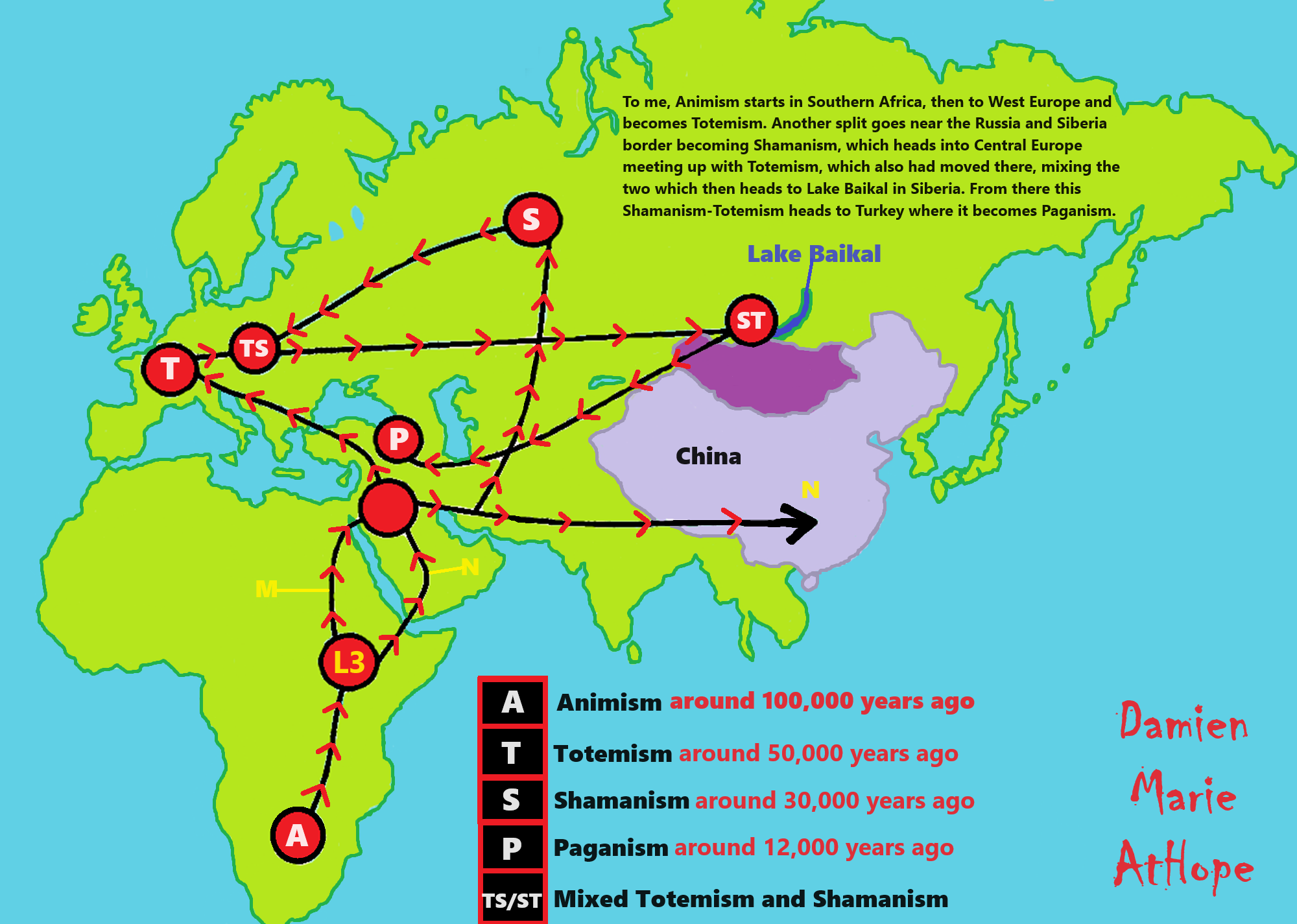
To me, Animism starts in Southern Africa, then to West Europe, and becomes Totemism. Another split goes near the Russia and Siberia border becoming Shamanism, which heads into Central Europe meeting up with Totemism, which also had moved there, mixing the two which then heads to Lake Baikal in Siberia. From there this Shamanism-Totemism heads to Turkey where it becomes Paganism.





Not all “Religions” or “Religious Persuasions” have a god(s) but
All can be said to believe in some imaginary beings or imaginary things like spirits, afterlives, etc.

Paganism 12,000-4,000 years old
12,000-7,000 years old: related to (Pre-Capitalism)
7,000-5,000 years old: related to (Capitalism) (World War 0) Elite and their slaves!
5,000 years old: related to (Kings and the Rise of the State)
4,000 years old: related to (First Moralistic gods, then the Origin time of Monotheism)

ref, ref, ref, ref, ref, ref, ref, ref, ref, ref, ref, ref, ref, ref, ref, ref, ref, ref, ref, ref, ref
Low Gods “Earth” or Tutelary deity and High Gods “Sky” or Supreme deity
“An Earth goddess is a deification of the Earth. Earth goddesses are often associated with the “chthonic” deities of the underworld. Ki and Ninhursag are Mesopotamian earth goddesses. In Greek mythology, the Earth is personified as Gaia, corresponding to Roman Terra, Indic Prithvi/Bhūmi, etc. traced to an “Earth Mother” complementary to the “Sky Father” in Proto-Indo-European religion. Egyptian mythology exceptionally has a sky goddess and an Earth god.” ref
“A mother goddess is a goddess who represents or is a personification of nature, motherhood, fertility, creation, destruction or who embodies the bounty of the Earth. When equated with the Earth or the natural world, such goddesses are sometimes referred to as Mother Earth or as the Earth Mother. In some religious traditions or movements, Heavenly Mother (also referred to as Mother in Heaven or Sky Mother) is the wife or feminine counterpart of the Sky father or God the Father.” ref
“Any masculine sky god is often also king of the gods, taking the position of patriarch within a pantheon. Such king gods are collectively categorized as “sky father” deities, with a polarity between sky and earth often being expressed by pairing a “sky father” god with an “earth mother” goddess (pairings of a sky mother with an earth father are less frequent). A main sky goddess is often the queen of the gods and may be an air/sky goddess in her own right, though she usually has other functions as well with “sky” not being her main. In antiquity, several sky goddesses in ancient Egypt, Mesopotamia, and the Near East were called Queen of Heaven. Neopagans often apply it with impunity to sky goddesses from other regions who were never associated with the term historically. The sky often has important religious significance. Many religions, both polytheistic and monotheistic, have deities associated with the sky.” ref
“In comparative mythology, sky father is a term for a recurring concept in polytheistic religions of a sky god who is addressed as a “father”, often the father of a pantheon and is often either a reigning or former King of the Gods. The concept of “sky father” may also be taken to include Sun gods with similar characteristics, such as Ra. The concept is complementary to an “earth mother“. “Sky Father” is a direct translation of the Vedic Dyaus Pita, etymologically descended from the same Proto-Indo-European deity name as the Greek Zeûs Pater and Roman Jupiter and Germanic Týr, Tir or Tiwaz, all of which are reflexes of the same Proto-Indo-European deity’s name, *Dyēus Ph₂tḗr. While there are numerous parallels adduced from outside of Indo-European mythology, there are exceptions (e.g. In Egyptian mythology, Nut is the sky mother and Geb is the earth father).” ref
Tutelary deity
“A tutelary (also tutelar) is a deity or spirit who is a guardian, patron, or protector of a particular place, geographic feature, person, lineage, nation, culture, or occupation. The etymology of “tutelary” expresses the concept of safety and thus of guardianship. In late Greek and Roman religion, one type of tutelary deity, the genius, functions as the personal deity or daimon of an individual from birth to death. Another form of personal tutelary spirit is the familiar spirit of European folklore.” ref
“A tutelary (also tutelar) in Korean shamanism, jangseung and sotdae were placed at the edge of villages to frighten off demons. They were also worshiped as deities. Seonangshin is the patron deity of the village in Korean tradition and was believed to embody the Seonangdang. In Philippine animism, Diwata or Lambana are deities or spirits that inhabit sacred places like mountains and mounds and serve as guardians. Such as: Maria Makiling is the deity who guards Mt. Makiling and Maria Cacao and Maria Sinukuan. In Shinto, the spirits, or kami, which give life to human bodies come from nature and return to it after death. Ancestors are therefore themselves tutelaries to be worshiped. And similarly, Native American beliefs such as Tonás, tutelary animal spirit among the Zapotec and Totems, familial or clan spirits among the Ojibwe, can be animals.” ref
“A tutelary (also tutelar) in Austronesian beliefs such as: Atua (gods and spirits of the Polynesian peoples such as the Māori or the Hawaiians), Hanitu (Bunun of Taiwan‘s term for spirit), Hyang (Kawi, Sundanese, Javanese, and Balinese Supreme Being, in ancient Java and Bali mythology and this spiritual entity, can be either divine or ancestral), Kaitiaki (New Zealand Māori term used for the concept of guardianship, for the sky, the sea, and the land), Kawas (mythology) (divided into 6 groups: gods, ancestors, souls of the living, spirits of living things, spirits of lifeless objects, and ghosts), Tiki (Māori mythology, Tiki is the first man created by either Tūmatauenga or Tāne and represents deified ancestors found in most Polynesian cultures). ” ref, ref, ref, ref, ref, ref, ref
Mesopotamian Tutelary Deities can be seen as ones related to City-States
“Historical city-states included Sumerian cities such as Uruk and Ur; Ancient Egyptian city-states, such as Thebes and Memphis; the Phoenician cities (such as Tyre and Sidon); the five Philistine city-states; the Berber city-states of the Garamantes; the city-states of ancient Greece (the poleis such as Athens, Sparta, Thebes, and Corinth); the Roman Republic (which grew from a city-state into a vast empire); the Italian city-states from the Middle Ages to the early modern period, such as Florence, Siena, Ferrara, Milan (which as they grew in power began to dominate neighboring cities) and Genoa and Venice, which became powerful thalassocracies; the Mayan and other cultures of pre-Columbian Mesoamerica (including cities such as Chichen Itza, Tikal, Copán and Monte Albán); the central Asian cities along the Silk Road; the city-states of the Swahili coast; Ragusa; states of the medieval Russian lands such as Novgorod and Pskov; and many others.” ref
“The Uruk period (ca. 4000 to 3100 BCE; also known as Protoliterate period) of Mesopotamia, named after the Sumerian city of Uruk, this period saw the emergence of urban life in Mesopotamia and the Sumerian civilization. City-States like Uruk and others had a patron tutelary City Deity along with a Priest-King.” ref
“Chinese folk religion, both past, and present, includes myriad tutelary deities. Exceptional individuals, highly cultivated sages, and prominent ancestors can be deified and honored after death. Lord Guan is the patron of military personnel and police, while Mazu is the patron of fishermen and sailors. Such as Tu Di Gong (Earth Deity) is the tutelary deity of a locality, and each individual locality has its own Earth Deity and Cheng Huang Gong (City God) is the guardian deity of an individual city, worshipped by local officials and locals since imperial times.” ref
“A tutelary (also tutelar) in Hinduism, personal tutelary deities are known as ishta-devata, while family tutelary deities are known as Kuladevata. Gramadevata are guardian deities of villages. Devas can also be seen as tutelary. Shiva is the patron of yogis and renunciants. City goddesses include: Mumbadevi (Mumbai), Sachchika (Osian); Kuladevis include: Ambika (Porwad), and Mahalakshmi. In NorthEast India Meitei mythology and religion (Sanamahism) of Manipur, there are various types of tutelary deities, among which Lam Lais are the most predominant ones. Tibetan Buddhism has Yidam as a tutelary deity. Dakini is the patron of those who seek knowledge.” ref
“A tutelary (also tutelar) The Greeks also thought deities guarded specific places: for instance, Athena was the patron goddess of the city of Athens. Socrates spoke of hearing the voice of his personal spirit or daimonion:
You have often heard me speak of an oracle or sign which comes to me … . This sign I have had ever since I was a child. The sign is a voice which comes to me and always forbids me to do something which I am going to do, but never commands me to do anything, and this is what stands in the way of my being a politician.” ref
“Tutelary deities who guard and preserve a place or a person are fundamental to ancient Roman religion. The tutelary deity of a man was his Genius, that of a woman her Juno. In the Imperial era, the Genius of the Emperor was a focus of Imperial cult. An emperor might also adopt a major deity as his personal patron or tutelary, as Augustus did Apollo. Precedents for claiming the personal protection of a deity were established in the Republican era, when for instance the Roman dictator Sulla advertised the goddess Victory as his tutelary by holding public games (ludi) in her honor.” ref
“Each town or city had one or more tutelary deities, whose protection was considered particularly vital in time of war and siege. Rome itself was protected by a goddess whose name was to be kept ritually secret on pain of death (for a supposed case, see Quintus Valerius Soranus). The Capitoline Triad of Juno, Jupiter, and Minerva were also tutelaries of Rome. The Italic towns had their own tutelary deities. Juno often had this function, as at the Latin town of Lanuvium and the Etruscan city of Veii, and was often housed in an especially grand temple on the arx (citadel) or other prominent or central location. The tutelary deity of Praeneste was Fortuna, whose oracle was renowned.” ref
“The Roman ritual of evocatio was premised on the belief that a town could be made vulnerable to military defeat if the power of its tutelary deity were diverted outside the city, perhaps by the offer of superior cult at Rome. The depiction of some goddesses such as the Magna Mater (Great Mother, or Cybele) as “tower-crowned” represents their capacity to preserve the city. A town in the provinces might adopt a deity from within the Roman religious sphere to serve as its guardian, or syncretize its own tutelary with such; for instance, a community within the civitas of the Remi in Gaul adopted Apollo as its tutelary, and at the capital of the Remi (present-day Rheims), the tutelary was Mars Camulus.” ref
Household deity (a kind of or related to a Tutelary deity)
“A household deity is a deity or spirit that protects the home, looking after the entire household or certain key members. It has been a common belief in paganism as well as in folklore across many parts of the world. Household deities fit into two types; firstly, a specific deity – typically a goddess – often referred to as a hearth goddess or domestic goddess who is associated with the home and hearth, such as the ancient Greek Hestia.” ref
“The second type of household deities are those that are not one singular deity, but a type, or species of animistic deity, who usually have lesser powers than major deities. This type was common in the religions of antiquity, such as the Lares of ancient Roman religion, the Gashin of Korean shamanism, and Cofgodas of Anglo-Saxon paganism. These survived Christianisation as fairy-like creatures existing in folklore, such as the Anglo-Scottish Brownie and Slavic Domovoy.” ref
“Household deities were usually worshipped not in temples but in the home, where they would be represented by small idols (such as the teraphim of the Bible, often translated as “household gods” in Genesis 31:19 for example), amulets, paintings, or reliefs. They could also be found on domestic objects, such as cosmetic articles in the case of Tawaret. The more prosperous houses might have a small shrine to the household god(s); the lararium served this purpose in the case of the Romans. The gods would be treated as members of the family and invited to join in meals, or be given offerings of food and drink.” ref
“In many religions, both ancient and modern, a god would preside over the home. Certain species, or types, of household deities, existed. An example of this was the Roman Lares. Many European cultures retained house spirits into the modern period. Some examples of these include:
- Brownie (Scotland and England) or Hob (England) / Kobold (Germany) / Goblin / Hobgoblin
- Domovoy (Slavic)
- Nisse (Norwegian or Danish) / Tomte (Swedish) / Tonttu (Finnish)
- Húsvættir (Norse)” ref
“Although the cosmic status of household deities was not as lofty as that of the Twelve Olympians or the Aesir, they were also jealous of their dignity and also had to be appeased with shrines and offerings, however humble. Because of their immediacy they had arguably more influence on the day-to-day affairs of men than the remote gods did. Vestiges of their worship persisted long after Christianity and other major religions extirpated nearly every trace of the major pagan pantheons. Elements of the practice can be seen even today, with Christian accretions, where statues to various saints (such as St. Francis) protect gardens and grottos. Even the gargoyles found on older churches, could be viewed as guardians partitioning a sacred space.” ref
“For centuries, Christianity fought a mop-up war against these lingering minor pagan deities, but they proved tenacious. For example, Martin Luther‘s Tischreden have numerous – quite serious – references to dealing with kobolds. Eventually, rationalism and the Industrial Revolution threatened to erase most of these minor deities, until the advent of romantic nationalism rehabilitated them and embellished them into objects of literary curiosity in the 19th century. Since the 20th century this literature has been mined for characters for role-playing games, video games, and other fantasy personae, not infrequently invested with invented traits and hierarchies somewhat different from their mythological and folkloric roots.” ref
“In contradistinction to both Herbert Spencer and Edward Burnett Tylor, who defended theories of animistic origins of ancestor worship, Émile Durkheim saw its origin in totemism. In reality, this distinction is somewhat academic, since totemism may be regarded as a particularized manifestation of animism, and something of a synthesis of the two positions was attempted by Sigmund Freud. In Freud’s Totem and Taboo, both totem and taboo are outward expressions or manifestations of the same psychological tendency, a concept which is complementary to, or which rather reconciles, the apparent conflict. Freud preferred to emphasize the psychoanalytic implications of the reification of metaphysical forces, but with particular emphasis on its familial nature. This emphasis underscores, rather than weakens, the ancestral component.” ref
“William Edward Hearn, a noted classicist, and jurist, traced the origin of domestic deities from the earliest stages as an expression of animism, a belief system thought to have existed also in the neolithic, and the forerunner of Indo-European religion. In his analysis of the Indo-European household, in Chapter II “The House Spirit”, Section 1, he states:
The belief which guided the conduct of our forefathers was … the spirit rule of dead ancestors.” ref
“In Section 2 he proceeds to elaborate:
It is thus certain that the worship of deceased ancestors is a vera causa, and not a mere hypothesis. …
In the other European nations, the Slavs, the Teutons, and the Kelts, the House Spirit appears with no less distinctness. … [T]he existence of that worship does not admit of doubt. … The House Spirits had a multitude of other names which it is needless here to enumerate, but all of which are more or less expressive of their friendly relations with man. … In [England] … [h]e is the Brownie. … In Scotland this same Brownie is well known. He is usually described as attached to particular families, with whom he has been known to reside for centuries, threshing the corn, cleaning the house, and performing similar household tasks. His favorite gratification was milk and honey.” ref

ref, ref, ref, ref, ref, ref, ref, ref, ref, ref, ref, ref, ref, ref, ref, ref, ref
“These ideas are my speculations from the evidence.”
I am still researching the “god‘s origins” all over the world. So you know, it is very complicated but I am smart and willing to look, DEEP, if necessary, which going very deep does seem to be needed here, when trying to actually understand the evolution of gods and goddesses. I am sure of a few things and less sure of others, but even in stuff I am not fully grasping I still am slowly figuring it out, to explain it to others. But as I research more I am understanding things a little better, though I am still working on understanding it all or something close and thus always figuring out more.
Sky Father/Sky God?
“Egyptian: (Nut) Sky Mother and (Geb) Earth Father” (Egypt is different but similar)
Turkic/Mongolic: (Tengri/Tenger Etseg) Sky Father and (Eje/Gazar Eej) Earth Mother *Transeurasian*
Hawaiian: (Wākea) Sky Father and (Papahānaumoku) Earth Mother *Austronesian*
New Zealand/ Māori: (Ranginui) Sky Father and (Papatūānuku) Earth Mother *Austronesian*
Proto-Indo-European: (Dyḗus/Dyḗus ph₂tḗr) Sky Father and (Dʰéǵʰōm/Pleth₂wih₁) Earth Mother
Indo-Aryan: (Dyaus Pita) Sky Father and (Prithvi Mata) Earth Mother *Indo-European*
Italic: (Jupiter) Sky Father and (Juno) Sky Mother *Indo-European*
Etruscan: (Tinia) Sky Father and (Uni) Sky Mother *Tyrsenian/Italy Pre–Indo-European*
Hellenic/Greek: (Zeus) Sky Father and (Hera) Sky Mother who started as an “Earth Goddess” *Indo-European*
Nordic: (Dagr) Sky Father and (Nótt) Sky Mother *Indo-European*
Slavic: (Perun) Sky Father and (Mokosh) Earth Mother *Indo-European*
Illyrian: (Deipaturos) Sky Father and (Messapic Damatura’s “earth-mother” maybe) Earth Mother *Indo-European*
Albanian: (Zojz) Sky Father and (?) *Indo-European*
Baltic: (Perkūnas) Sky Father and (Saulė) Sky Mother *Indo-European*
Germanic: (Týr) Sky Father and (?) *Indo-European*
Colombian-Muisca: (Bochica) Sky Father and (Huythaca) Sky Mother *Chibchan*
Aztec: (Quetzalcoatl) Sky Father and (Xochiquetzal) Sky Mother *Uto-Aztecan*
Incan: (Viracocha) Sky Father and (Mama Runtucaya) Sky Mother *Quechuan*
China: (Tian/Shangdi) Sky Father and (Dì) Earth Mother *Sino-Tibetan*
Sumerian, Assyrian and Babylonian: (An/Anu) Sky Father and (Ki) Earth Mother
Finnish: (Ukko) Sky Father and (Akka) Earth Mother *Finno-Ugric*
Sami: (Horagalles) Sky Father and (Ravdna) Earth Mother *Finno-Ugric*
Puebloan-Zuni: (Ápoyan Ta’chu) Sky Father and (Áwitelin Tsíta) Earth Mother
Puebloan-Hopi: (Tawa) Sky Father and (Kokyangwuti/Spider Woman/Grandmother) Earth Mother *Uto-Aztecan*
Puebloan-Navajo: (Tsohanoai) Sky Father and (Estsanatlehi) Earth Mother *Na-Dene*
ref, ref, ref, ref, ref, ref, ref, ref, ref, ref, ref, ref, ref, ref, ref, ref, ref, ref, ref, ref, ref, ref, ref, ref, ref, ref, ref

Hinduism around 3,700 to 3,500 years old. ref
Judaism around 3,450 or 3,250 years old. (The first writing in the bible was “Paleo-Hebrew” dated to around 3,000 years ago Khirbet Qeiyafa is the site of an ancient fortress city overlooking the Elah Valley. And many believe the religious Jewish texts were completed around 2,500) ref, ref
Judaism is around 3,450 or 3,250 years old. (“Paleo-Hebrew” 3,000 years ago and Torah 2,500 years ago)
“Judaism is an Abrahamic, its roots as an organized religion in the Middle East during the Bronze Age. Some scholars argue that modern Judaism evolved from Yahwism, the religion of ancient Israel and Judah, by the late 6th century BCE, and is thus considered to be one of the oldest monotheistic religions.” ref
“Yahwism is the name given by modern scholars to the religion of ancient Israel, essentially polytheistic, with a plethora of gods and goddesses. Heading the pantheon was Yahweh, the national god of the Israelite kingdoms of Israel and Judah, with his consort, the goddess Asherah; below them were second-tier gods and goddesses such as Baal, Shamash, Yarikh, Mot, and Astarte, all of whom had their own priests and prophets and numbered royalty among their devotees, and a third and fourth tier of minor divine beings, including the mal’ak, the messengers of the higher gods, who in later times became the angels of Judaism, Christianity and Islam. Yahweh, however, was not the ‘original’ god of Israel “Isra-El”; it is El, the head of the Canaanite pantheon, whose name forms the basis of the name “Israel”, and none of the Old Testament patriarchs, the tribes of Israel, the Judges, or the earliest monarchs, have a Yahwistic theophoric name (i.e., one incorporating the name of Yahweh).” ref
“El is a Northwest Semitic word meaning “god” or “deity“, or referring (as a proper name) to any one of multiple major ancient Near Eastern deities. A rarer form, ‘ila, represents the predicate form in Old Akkadian and in Amorite. The word is derived from the Proto-Semitic *ʔil-, meaning “god”. Specific deities known as ‘El or ‘Il include the supreme god of the ancient Canaanite religion and the supreme god of East Semitic speakers in Mesopotamia’s Early Dynastic Period. ʼĒl is listed at the head of many pantheons. In some Canaanite and Ugaritic sources, ʼĒl played a role as father of the gods, of creation, or both. For example, in the Ugaritic texts, ʾil mlk is understood to mean “ʼĒl the King” but ʾil hd as “the god Hadad“. The Semitic root ʾlh (Arabic ʾilāh, Aramaic ʾAlāh, ʾElāh, Hebrew ʾelōah) may be ʾl with a parasitic h, and ʾl may be an abbreviated form of ʾlh. In Ugaritic the plural form meaning “gods” is ʾilhm, equivalent to Hebrew ʾelōhîm “powers”. In the Hebrew texts this word is interpreted as being semantically singular for “god” by biblical commentators. However the documentary hypothesis for the Old Testament (corresponds to the Jewish Torah) developed originally in the 1870s, identifies these that different authors – the Jahwist, Elohist, Deuteronomist, and the Priestly source – were responsible for editing stories from a polytheistic religion into those of a monotheistic religion. Inconsistencies that arise between monotheism and polytheism in the texts are reflective of this hypothesis.” ref
Jainism around 2,599 – 2,527 years old. ref
Confucianism around 2,600 – 2,551 years old. ref
Buddhism around 2,563/2,480 – 2,483/2,400 years old. ref
Christianity around 2,o00 years old. ref
Shinto around 1,305 years old. ref
Islam around 1407–1385 years old. ref

Knowledge to Ponder:
Stars/Astrology:
- Possibly, around 30,000 years ago (in simpler form) to 6,000 years ago, Stars/Astrology are connected to Ancestors, Spirit Animals, and Deities.
- The star also seems to be a possible proto-star for Star of Ishtar, Star of Inanna, or Star of Venus.
- Around 7,000 to 6,000 years ago, Star Constellations/Astrology have connections to the “Kurgan phenomenon” of below-ground “mound” stone/wood burial structures and “Dolmen phenomenon” of above-ground stone burial structures.
- Around 6,500–5,800 years ago, The Northern Levant migrations into Jordon and Israel in the Southern Levant brought new cultural and religious transfer from Turkey and Iran.
- “The Ghassulian Star,” a mysterious 6,000-year-old mural from Jordan may have connections to the European paganstic kurgan/dolmens phenomenon.
“Astrology is a range of divinatory practices, recognized as pseudoscientific since the 18th century, that claim to discern information about human affairs and terrestrial events by studying the apparent positions of celestial objects. Different cultures have employed forms of astrology since at least the 2nd millennium BCE, these practices having originated in calendrical systems used to predict seasonal shifts and to interpret celestial cycles as signs of divine communications. Most, if not all, cultures have attached importance to what they observed in the sky, and some—such as the Hindus, Chinese, and the Maya—developed elaborate systems for predicting terrestrial events from celestial observations. Western astrology, one of the oldest astrological systems still in use, can trace its roots to 19th–17th century BCE Mesopotamia, from where it spread to Ancient Greece, Rome, the Islamicate world and eventually Central and Western Europe. Contemporary Western astrology is often associated with systems of horoscopes that purport to explain aspects of a person’s personality and predict significant events in their lives based on the positions of celestial objects; the majority of professional astrologers rely on such systems.” ref
Around 5,500 years ago, Science evolves, The first evidence of science was 5,500 years ago and was demonstrated by a body of empirical, theoretical, and practical knowledge about the natural world. ref
Around 5,000 years ago, Origin of Logics is a Naturalistic Observation (principles of valid reasoning, inference, & demonstration) ref
Around 4,150 to 4,000 years ago: The earliest surviving versions of the Sumerian Epic of Gilgamesh, which was originally titled “He who Saw the Deep” (Sha naqba īmuru) or “Surpassing All Other Kings” (Shūtur eli sharrī) were written. ref
Hinduism:
- 3,700 years ago or so, the oldest of the Hindu Vedas (scriptures), the Rig Veda was composed.
- 3,500 years ago or so, the Vedic Age began in India after the collapse of the Indus Valley Civilization.
Judaism:
- around 3,000 years ago, the first writing in the bible was “Paleo-Hebrew”
- around 2,500 years ago, many believe the religious Jewish texts were completed
Myths: The bible inspired religion is not just one religion or one myth but a grouping of several religions and myths
- Around 3,450 or 3,250 years ago, according to legend, is the traditionally accepted period in which the Israelite lawgiver, Moses, provided the Ten Commandments.
- Around 2,500 to 2,400 years ago, a collection of ancient religious writings by the Israelites based primarily upon the Hebrew Bible, Tanakh, or Old Testament is the first part of Christianity’s bible.
- Around 2,400 years ago, the most accepted hypothesis is that the canon was formed in stages, first the Pentateuch (Torah).
- Around 2,140 to 2,116 years ago, the Prophets was written during the Hasmonean dynasty, and finally the remaining books.
- Christians traditionally divide the Old Testament into four sections:
- The first five books or Pentateuch (Torah).
- The proposed history books telling the history of the Israelites from their conquest of Canaan to their defeat and exile in Babylon.
- The poetic and proposed “Wisdom books” dealing, in various forms, with questions of good and evil in the world.
- The books of the biblical prophets, warning of the consequences of turning away from God:
- Henotheism:
- Exodus 20:23 “You shall not make other gods besides Me (not saying there are no other gods just not to worship them); gods of silver or gods of gold, you shall not make for yourselves.”
- Polytheism:
- Judges 10:6 “Then the sons of Israel again did evil in the sight of the LORD, served the Baals and the Ashtaroth, the gods of Aram, the gods of Sidon, the gods of Moab, the gods of the sons of Ammon, and the gods of the Philistines; thus they forsook the LORD and did not serve Him.”
- 1 Corinthians 8:5 “For even if there are so-called gods whether in heaven or on earth, as indeed there are many gods and many lords.”
- Monotheism:
- Isaiah 43:10 “You are my witnesses,” declares the LORD, “and my servant whom I have chosen, so that you may know and believe me and understand that I am he. Before me no god was formed, nor will there be one after me.
Around 2,570 to 2,270 Years Ago, there is a confirmation of atheistic doubting as well as atheistic thinking, mainly by Greek philosophers. However, doubting gods is likely as old as the invention of gods and should destroy the thinking that belief in god(s) is the “default belief”. The Greek word is apistos (a “not” and pistos “faithful,”), thus not faithful or faithless because one is unpersuaded and unconvinced by a god(s) claim. Short Definition: unbelieving, unbeliever, or unbelief.

Expressions of Atheistic Thinking:
- Around 2,600 years ago, Ajita Kesakambali, ancient Indian philosopher, who is the first known proponent of Indian materialism. ref
- Around 2,535 to 2,475 years ago, Heraclitus, Greek pre-Socratic philosopher, a native of the Greek city Ephesus, Ionia, on the coast of Anatolia, also known as Asia Minor or modern Turkey. ref
- Around 2,500 to 2,400 years ago, according to The Story of Civilization book series certain African pygmy tribes have no identifiable gods, spirits, or religious beliefs or rituals, and even what burials accrue are without ceremony. ref
- Around 2,490 to 2,430 years ago, Empedocles, Greek pre-Socratic philosopher and a citizen of Agrigentum, a Greek city in Sicily. ref
- Around 2,460 to 2,370 years ago, Democritus, Greek pre-Socratic philosopher considered to be the “father of modern science” possibly had some disbelief amounting to atheism. ref
- Around 2,399 years ago or so, Socrates, a famous Greek philosopher was tried for sinfulness by teaching doubt of state gods. ref
- Around 2,341 to 2,270 years ago, Epicurus, a Greek philosopher known for composing atheistic critics and famously stated, “Is God willing to prevent evil, but not able? Then he is not omnipotent. Is he able, but not willing? Then he is malevolent. Is he both able and willing? Then whence cometh evil? Is he neither able nor willing? Then why call him god?” ref
This last expression by Epicurus, seems to be an expression of Axiological Atheism. To understand and utilize value or actually possess “Value Conscious/Consciousness” to both give a strong moral “axiological” argument (the problem of evil) as well as use it to fortify humanism and positive ethical persuasion of human helping and care responsibilities. Because value-blindness gives rise to sociopathic/psychopathic evil.

“Theists, there has to be a god, as something can not come from nothing.”
Well, thus something (unknown) happened and then there was something. This does not tell us what the something that may have been involved with something coming from nothing. A supposed first cause, thus something (unknown) happened and then there was something is not an open invitation to claim it as known, neither is it justified to call or label such an unknown as anything, especially an unsubstantiated magical thinking belief born of mythology and religious storytelling.


While hallucinogens are associated with shamanism, it is alcohol that is associated with paganism.
The Atheist-Humanist-Leftist Revolutionaries Shows in the prehistory series:
Show two: Pre-animism 300,000 years old and animism 100,000 years old: related to “Anarchism and Socialism”
Show tree: Totemism 50,000 years old: related to “Anarchism and Socialism”
Show four: Shamanism 30,000 years old: related to “Anarchism and Socialism”
Show five: Paganism 12,000 years old: related to “Anarchism and Socialism”
Show six: Emergence of hierarchy, sexism, slavery, and the new male god dominance: Paganism 7,000-5,000 years old: related to “Anarchism and Socialism” (Capitalism) (World War 0) Elite and their slaves!
Prehistory: related to “Anarchism and Socialism” the division of labor, power, rights, and recourses: VIDEO
Pre-animism 300,000 years old and animism 100,000 years old: related to “Anarchism and Socialism”: VIDEO
Totemism 50,000 years old: related to “Anarchism and Socialism”: VIDEO
Shamanism 30,000 years old: related to “Anarchism and Socialism”: VIDEO
Paganism 12,000 years old: related to “Anarchism and Socialism” (Pre-Capitalism): VIDEO
Paganism 7,000-5,000 years old: related to “Anarchism and Socialism” (Capitalism) (World War 0) Elite and their slaves: VIEDO
Paganism 5,000 years old: progressed organized religion and the state: related to “Anarchism and Socialism” (Kings and the Rise of the State): VIEDO
Paganism 4,000 years old: related to “Anarchism and Socialism” (First Moralistic gods, then the Origin time of Monotheism): VIEDO
I do not hate simply because I challenge and expose myths or lies any more than others being thought of as loving simply because of the protection and hiding from challenge their favored myths or lies.
The truth is best championed in the sunlight of challenge.
An archaeologist once said to me “Damien religion and culture are very different”
My response, So are you saying that was always that way, such as would you say Native Americans’ cultures are separate from their religions? And do you think it always was the way you believe?
I had said that religion was a cultural product. That is still how I see it and there are other archaeologists that think close to me as well. Gods too are the myths of cultures that did not understand science or the world around them, seeing magic/supernatural everywhere.
I personally think there is a goddess and not enough evidence to support a male god at Çatalhöyük but if there was both a male and female god and goddess then I know the kind of gods they were like Proto-Indo-European mythology.
This series idea was addressed in, Anarchist Teaching as Free Public Education or Free Education in the Public: VIDEO
Our 12 video series: Organized Oppression: Mesopotamian State Force and the Politics of power (9,000-4,000 years ago), is adapted from: The Complete and Concise History of the Sumerians and Early Bronze Age Mesopotamia (7000-2000 BC): https://www.youtube.com/watch?v=szFjxmY7jQA by “History with Cy“
Show #1: Mesopotamian State Force and the Politics of Power (Samarra, Halaf, Ubaid)
Show #2: Mesopotamian State Force and the Politics of Power
Show #3: Mesopotamian State Force and the Politics of Power (Uruk and the First Cities)
Show #4: Mesopotamian State Force and the Politics of Power (First Kings)
Show #5: Mesopotamian State Force and the Politics of Power (Early Dynastic Period)
Show #6: Mesopotamian State Force and the Politics of Power
Show #7: Mesopotamian State Force and the Politics of Power (Sargon and Akkadian Rule)
Show #9: Mesopotamian State Force and the Politics of Power (Gudea of Lagash and Utu-hegal)
Show #12: Mesopotamian State Force and the Politics of Power (Aftermath and Legacy of Sumer)

The “Atheist-Humanist-Leftist Revolutionaries”
Cory Johnston ☭ Ⓐ Atheist Leftist @Skepticallefty & I (Damien Marie AtHope) @AthopeMarie (my YouTube & related blog) are working jointly in atheist, antitheist, antireligionist, antifascist, anarchist, socialist, and humanist endeavors in our videos together, generally, every other Saturday.
Why Does Power Bring Responsibility?
Think, how often is it the powerless that start wars, oppress others, or commit genocide? So, I guess the question is to us all, to ask, how can power not carry responsibility in a humanity concept? I know I see the deep ethical responsibility that if there is power their must be a humanistic responsibility of ethical and empathic stewardship of that power. Will I be brave enough to be kind? Will I possess enough courage to be compassionate? Will my valor reach its height of empathy? I as everyone, earns our justified respect by our actions, that are good, ethical, just, protecting, and kind. Do I have enough self-respect to put my love for humanity’s flushing, over being brought down by some of its bad actors? May we all be the ones doing good actions in the world, to help human flourishing.
I create the world I want to live in, striving for flourishing. Which is not a place but a positive potential involvement and promotion; a life of humanist goal precision. To master oneself, also means mastering positive prosocial behaviors needed for human flourishing. I may have lost a god myth as an atheist, but I am happy to tell you, my friend, it is exactly because of that, leaving the mental terrorizer, god belief, that I truly regained my connected ethical as well as kind humanity.
Cory and I will talk about prehistory and theism, addressing the relevance to atheism, anarchism, and socialism.
At the same time as the rise of the male god, 7,000 years ago, there was also the very time there was the rise of violence, war, and clans to kingdoms, then empires, then states. It is all connected back to 7,000 years ago, and it moved across the world.
Cory Johnston: https://damienmarieathope.com/2021/04/cory-johnston-mind-of-a-skeptical-leftist/?v=32aec8db952d
The Mind of a Skeptical Leftist (YouTube)
Cory Johnston: Mind of a Skeptical Leftist @Skepticallefty
The Mind of a Skeptical Leftist By Cory Johnston: “Promoting critical thinking, social justice, and left-wing politics by covering current events and talking to a variety of people. Cory Johnston has been thoughtfully talking to people and attempting to promote critical thinking, social justice, and left-wing politics.” http://anchor.fm/skepticalleft
Cory needs our support. We rise by helping each other.
Cory Johnston ☭ Ⓐ @Skepticallefty Evidence-based atheist leftist (he/him) Producer, host, and co-host of 4 podcasts @skeptarchy @skpoliticspod and @AthopeMarie
Damien Marie AtHope (“At Hope”) Axiological Atheist, Anti-theist, Anti-religionist, Secular Humanist. Rationalist, Writer, Artist, Poet, Philosopher, Advocate, Activist, Psychology, and Armchair Archaeology/Anthropology/Historian.
Damien is interested in: Freedom, Liberty, Justice, Equality, Ethics, Humanism, Science, Atheism, Antiteism, Antireligionism, Ignosticism, Left-Libertarianism, Anarchism, Socialism, Mutualism, Axiology, Metaphysics, LGBTQI, Philosophy, Advocacy, Activism, Mental Health, Psychology, Archaeology, Social Work, Sexual Rights, Marriage Rights, Woman’s Rights, Gender Rights, Child Rights, Secular Rights, Race Equality, Ageism/Disability Equality, Etc. And a far-leftist, “Anarcho-Humanist.”
I am not a good fit in the atheist movement that is mostly pro-capitalist, I am anti-capitalist. Mostly pro-skeptic, I am a rationalist not valuing skepticism. Mostly pro-agnostic, I am anti-agnostic. Mostly limited to anti-Abrahamic religions, I am an anti-religionist.
To me, the “male god” seems to have either emerged or become prominent around 7,000 years ago, whereas the now favored monotheism “male god” is more like 4,000 years ago or so. To me, the “female goddess” seems to have either emerged or become prominent around 11,000-10,000 years ago or so, losing the majority of its once prominence around 2,000 years ago due largely to the now favored monotheism “male god” that grow in prominence after 4,000 years ago or so.
My Thought on the Evolution of Gods?
Animal protector deities from old totems/spirit animal beliefs come first to me, 13,000/12,000 years ago, then women as deities 11,000/10,000 years ago, then male gods around 7,000/8,000 years ago. Moralistic gods around 5,000/4,000 years ago, and monotheistic gods around 4,000/3,000 years ago.
To me, animal gods were likely first related to totemism animals around 13,000 to 12,000 years ago or older. Female as goddesses was next to me, 11,000 to 10,000 years ago or so with the emergence of agriculture. Then male gods come about 8,000 to 7,000 years ago with clan wars. Many monotheism-themed religions started in henotheism, emerging out of polytheism/paganism.


Damien Marie AtHope (Said as “At” “Hope”)/(Autodidact Polymath but not good at math):
Axiological Atheist, Anti-theist, Anti-religionist, Secular Humanist, Rationalist, Writer, Artist, Jeweler, Poet, “autodidact” Philosopher, schooled in Psychology, and “autodidact” Armchair Archaeology/Anthropology/Pre-Historian (Knowledgeable in the range of: 1 million to 5,000/4,000 years ago). I am an anarchist socialist politically. Reasons for or Types of Atheism
My Website, My Blog, & Short-writing or Quotes, My YouTube, Twitter: @AthopeMarie, and My Email: damien.marie.athope@gmail.com

